|
|
Post by codystarbuck on May 23, 2021 22:01:26 GMT -5
Airboy #50 Cover by Joe Kubert! Creative Team: Chuck Dixon-writer, Andy Kubert-pencils, Adam Kubert-inks, letters & colors, cat yronwode-editor & executioner It's a Kubert Employment Scheme! On the inside cover, cat hawks some prestige items from Eclipse, like gold foil cover Tapping the Vein, limited edition Roy Krenkel Swords & Saurains, and autographed Bob Kane (highly suspect) autobiographies, complete with "original sketch." Wonder if those were ghost drawn, like those Batman lithographs he was hawking. I read that book and; and, to put it mildly, it required hip waders. Synopsis:We pick up where we left off, as Davy has discovered that his father's body has been stolen from the family crypt, by Misery! 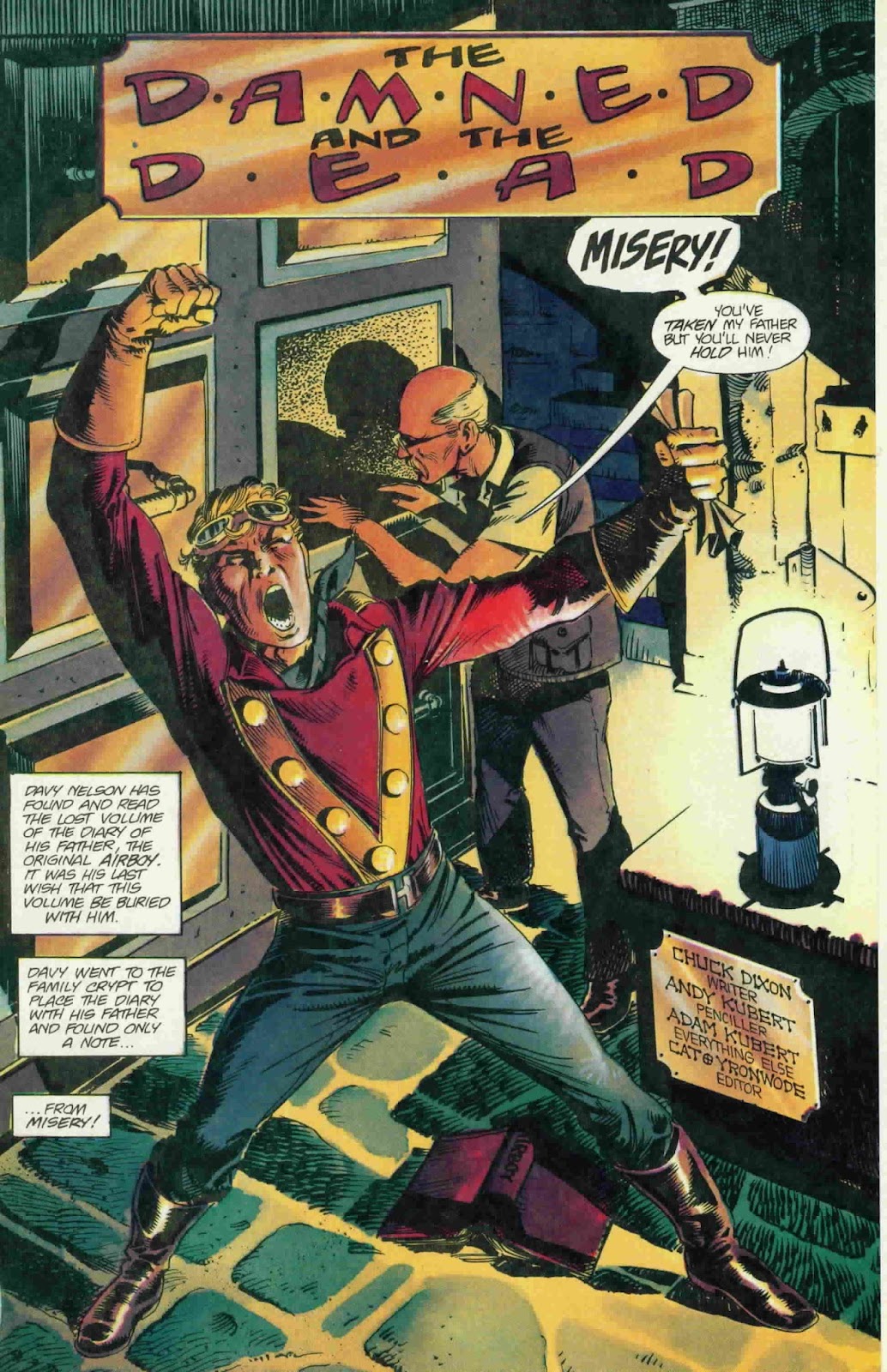 Davy vows to get him back and Hirota warns him that is exactly what Misery wants. Davy says he understands and Hirota tells him good, as they gear up. Valkyrie comes home and finds then oiling and polishing their weapons (which is not a euphemism, I swear!) She makes light and Davy tries to hide what they are doing, but Hirota says she has a right to know. Davy tells her and she runs off, crying, with Davy following... 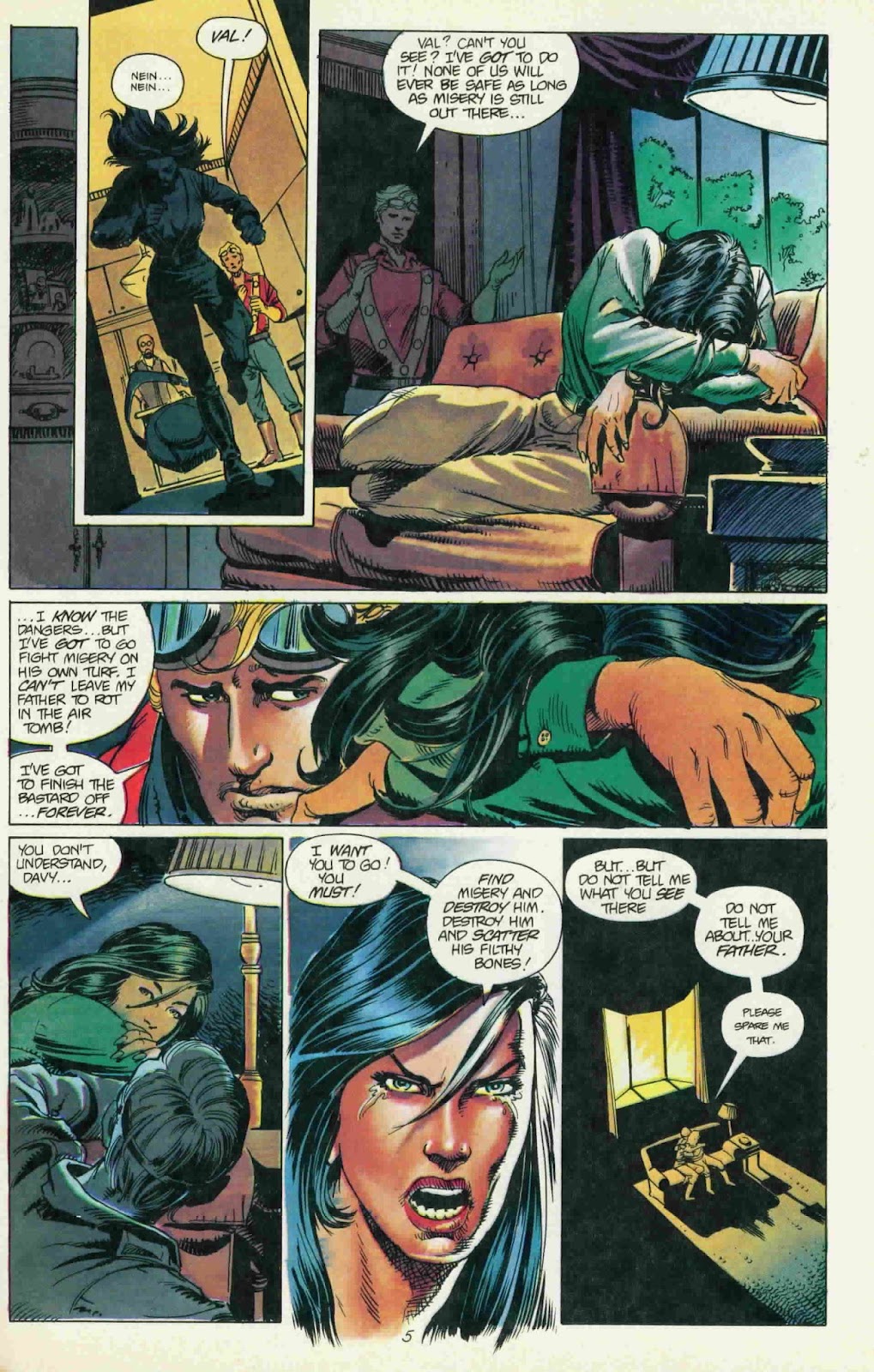 Valkyrie is not going, but the Heap has been sent to Bogantilla to accompany Davy. les Mansfield turns up and presents Davy with a "backpack" nuclear device! Must have gotten it from the Sharper Image catalog; or Shotgun News (they used to list all kinds of crazy stuff!). Hirota and Val see Davy off, as he climbs into Birdie and heads southeast. Hirota fills Les in about Misery. In Bogantilla, some customs officials try to fleece the shaman for taxes & duties and he calls their bluff by summoning the cargo...the Heap! 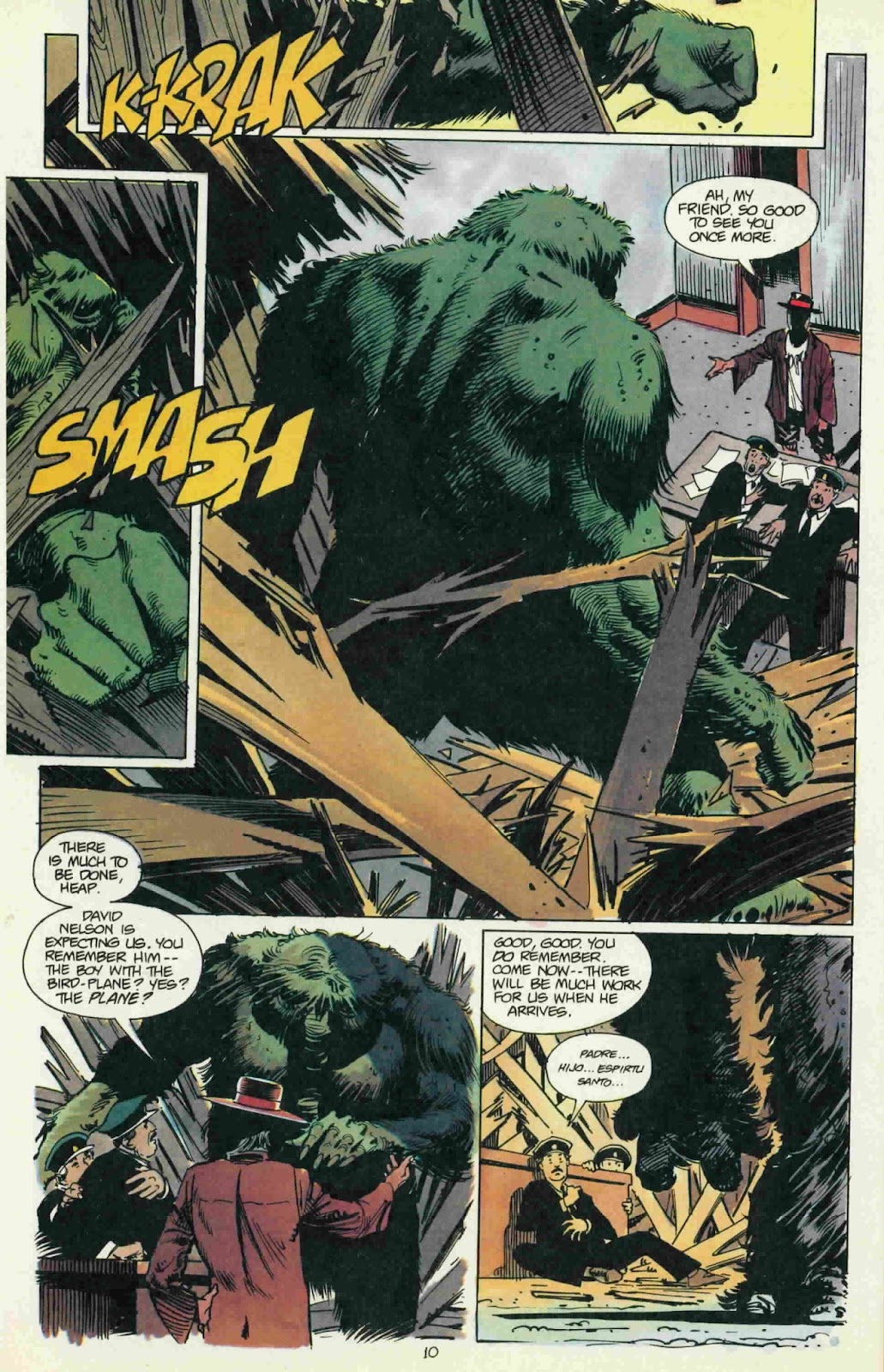 They wave the fees and duties and the Heap and the shaman go to prepare for Davy's arrival. He lands near the castle where Davy freed Valkyrie from Misery. They go inside and the shaman prepares the ritual for opening a portal into Misery's realm, then Davy and the Heap cross over. They emerge on a desolate plain, within the dimension Misery claims as his own.... 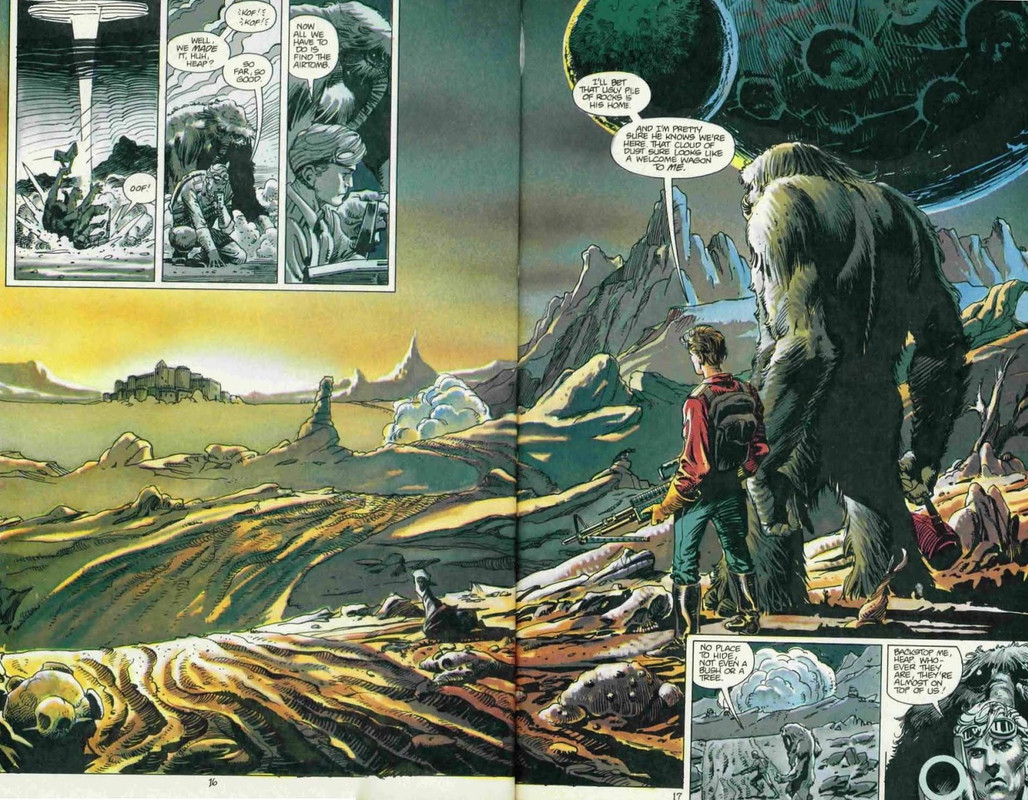 They head for the fortress and run into the biker rats that were once led by Manic. With Heap's help, Davy smashes them and they move on, but soon run into another rider in this desert... 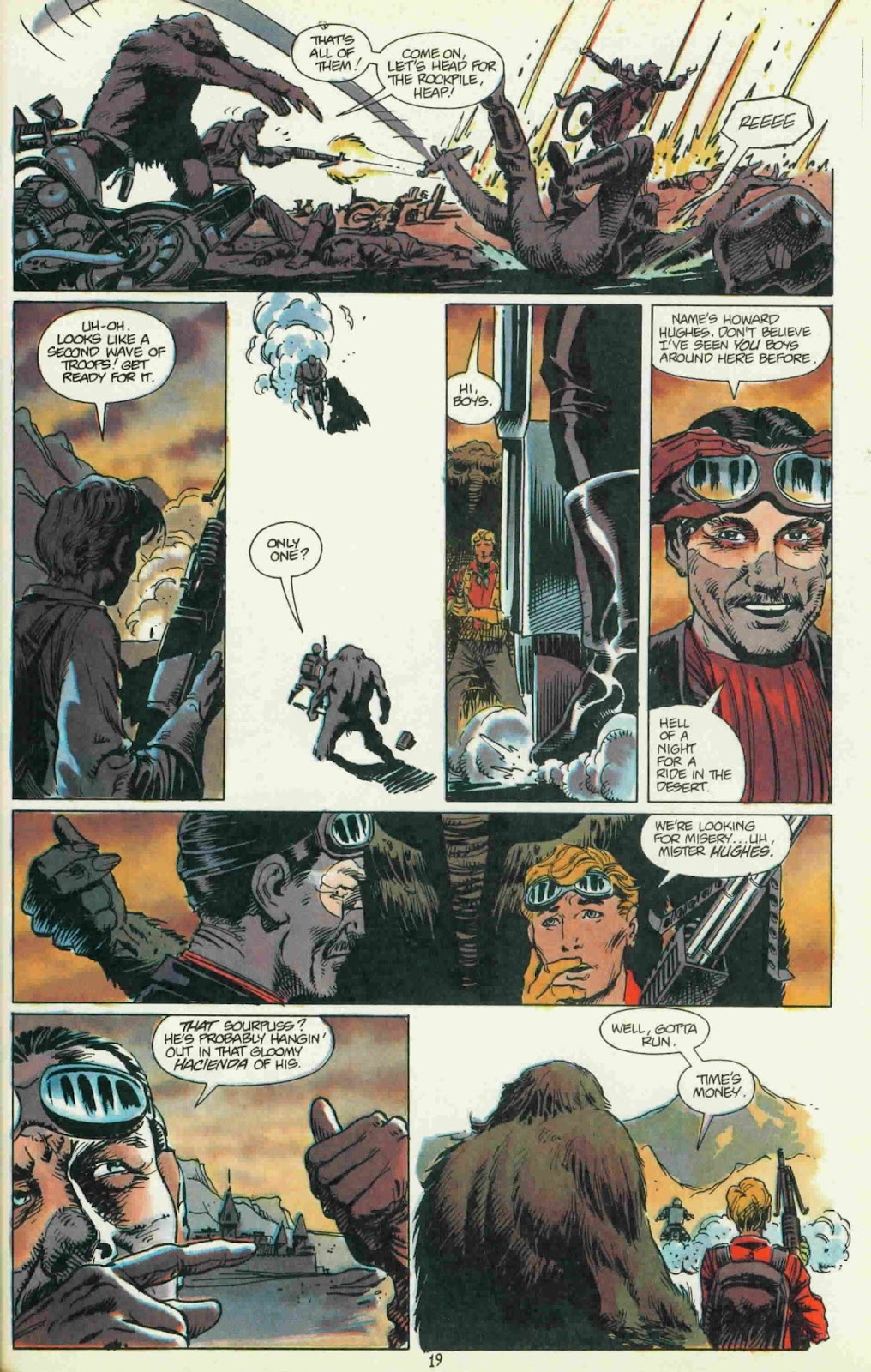 Howard rides off before Davy can ask him if he put Melvin Dummar (Chuck says Melvin Dupree) in his will or not. They start to continue to the fortress, when the Airtomb flies over. it lands by the fortress and Davy and Heap follow. heap busts open a doorway and they go inside, where they find cells filled with souls, feeding Misery's hunger. He runs across Manic, who is chained to a wall, the price for failing to kill Airboy. He tries to make a deal, for his freedom. Davy isn't buying and moves on, while Manic sings some Hendrix. Davy sets the nuke in place and sets the timer for an hour, but a familiar voice calls to him. He turns and sees Valkyrie silhouetted in a doorway.... 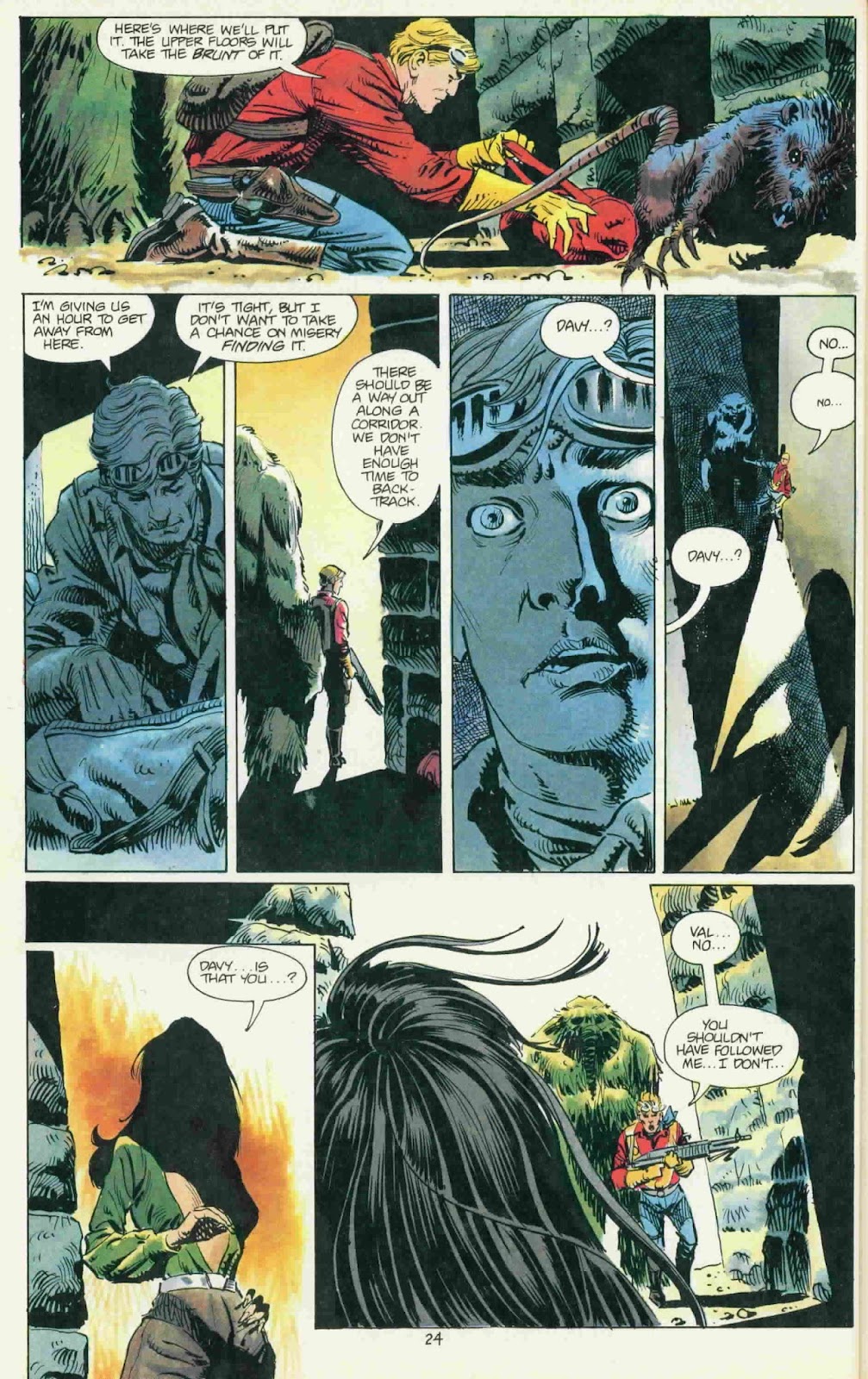 It turns out to be Anna Mahmlan, the Air Maiden who took Valkyrie's place and committed atrocities in the Soviet Union, for which she later confessed, to free Valkyrie from Soviet imprisonment. At the end of that story, she took her own life and was claimed by Misery. The walls reach out and attack the Heap. Davy smashes Anna in her decayed face, releasing worms and maggots and shattering the skull and she collapses to the floor, as Davy runs on. He is attacked by Baron Von Tundra, Black Axis and Goro, all enemies of the Air fighters. 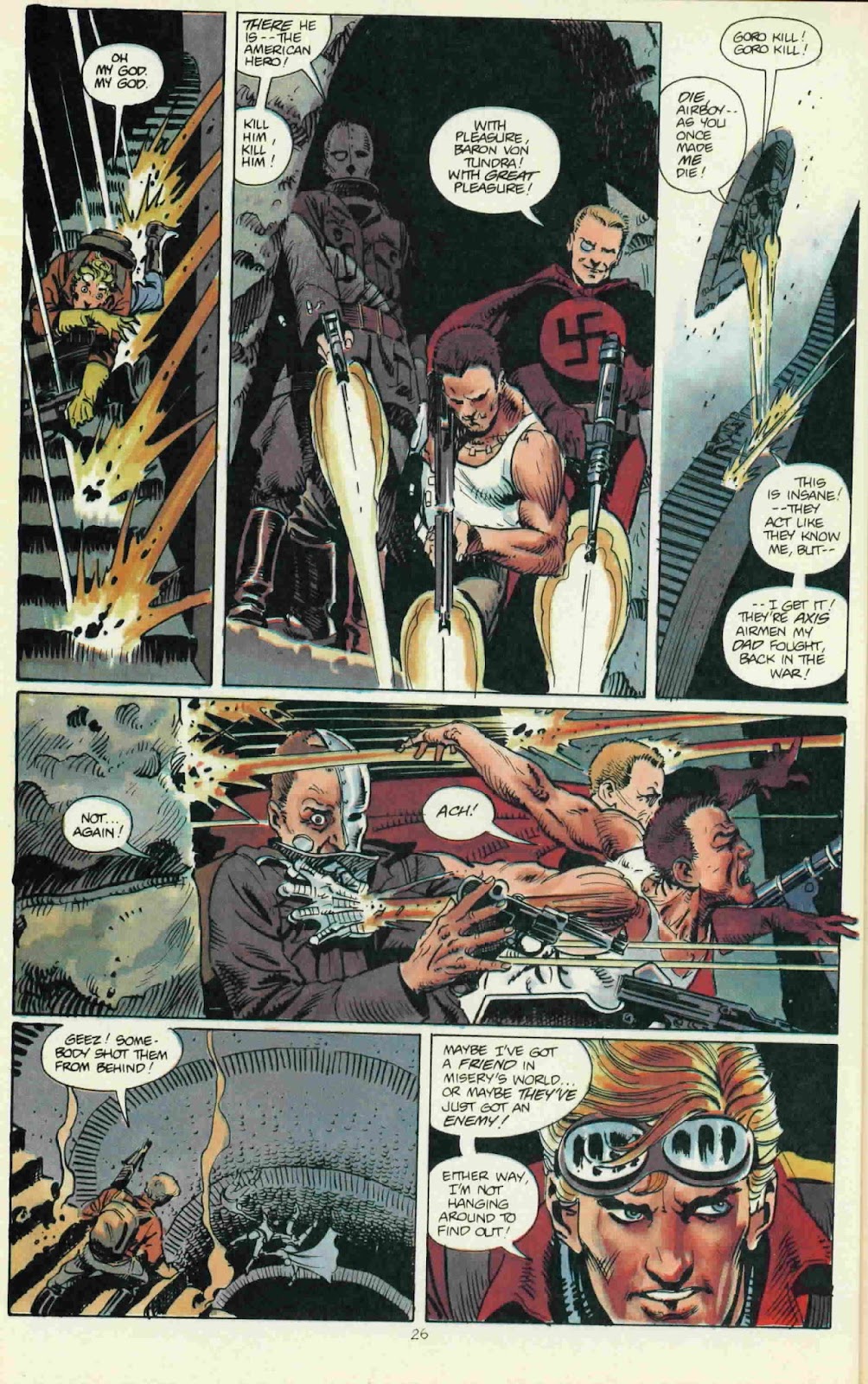 They have Davy pinned down, until they are wiped out, shot from behind by some unseen friend to Davy. he moves on, wondering who his benefactor is. Out of the shadows steps the Flying Dutchman, holding a tommygun, who watches as Davy runs the other direction. Davy encounters a horde of rats and fights through and finds himself in the center of Misery's domain... 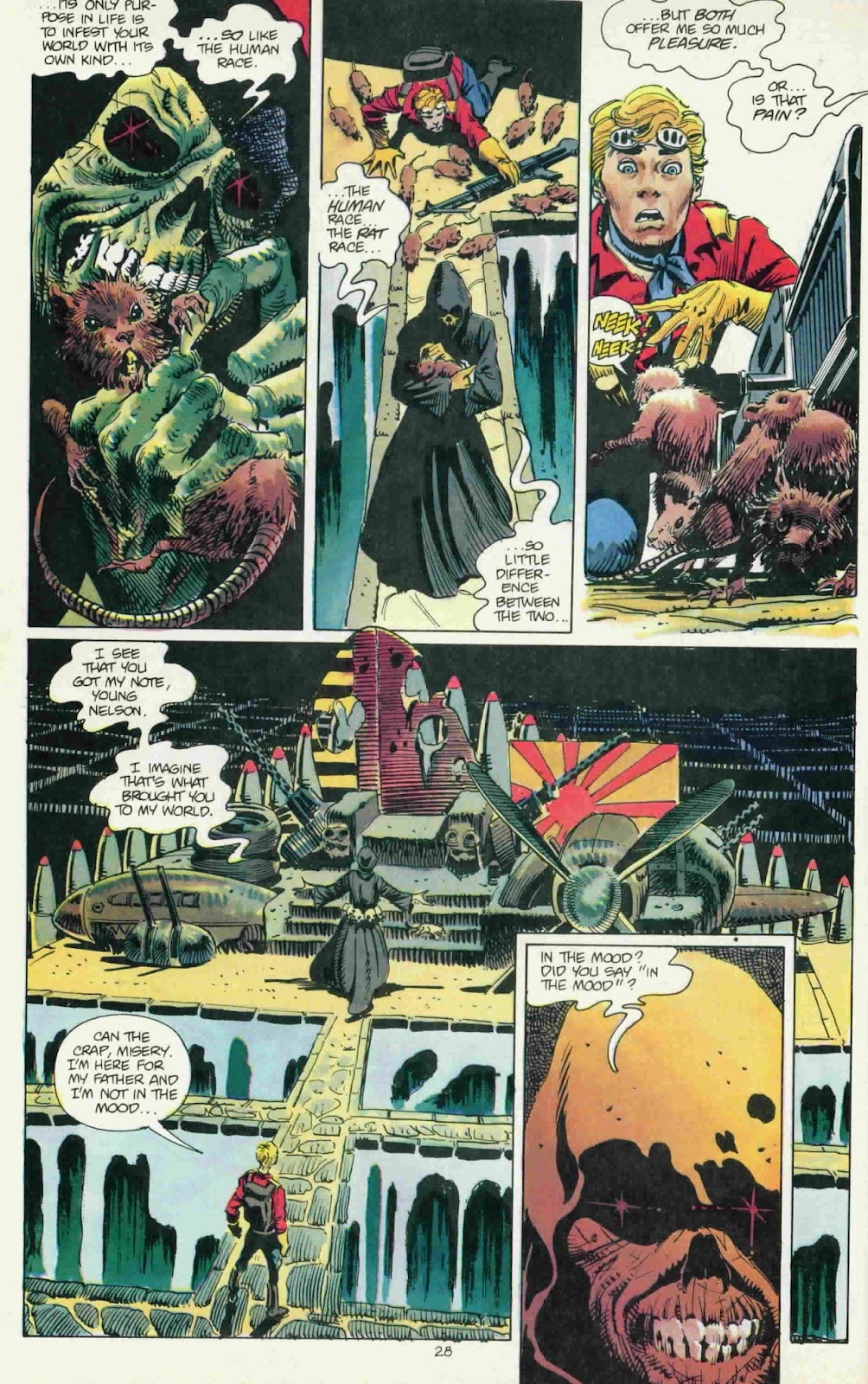 He forces Glen Miller and his band to play, as he monologues. He feigns innocence at taking Davy's father and Nelson Sr appears and tells his son that he came of his own volition. Davy tries to reason, that Valkyrie is not a prisoner there, and Davy Sr was not a failure, as a father. It doesn't work and Misery cackles and tells Davy Sr he must shoot his son, so that he can join them and gain guidance. He is about to pull the trigger, when help arrives... 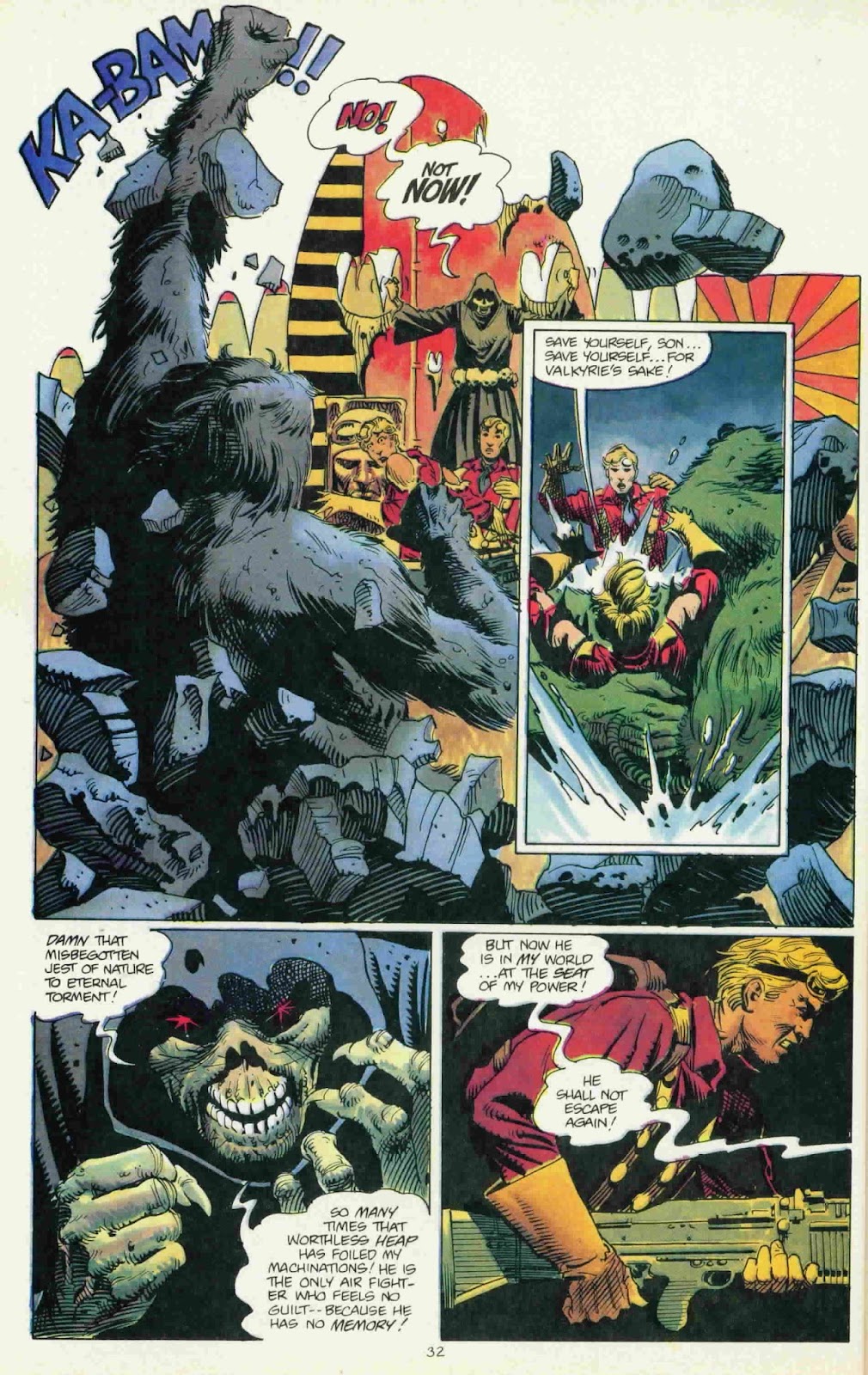 Heap grabs Davy Sr and pulls him away, plummeting into a lake. Davy Jr fires on Misery and battles him, stopping him from pursuing. The Heap is able to pull Davy Sr's soul inside himself, to return him to the life cycle. Davy and Misery battle and it goes bad for Airboy, when the Heap reaches out of the pool and grabs Misery, dragging him in. Misery grabs Davy and pulls him with him, until he is riddled with bullets and Davy meets the Flying Dutchman... 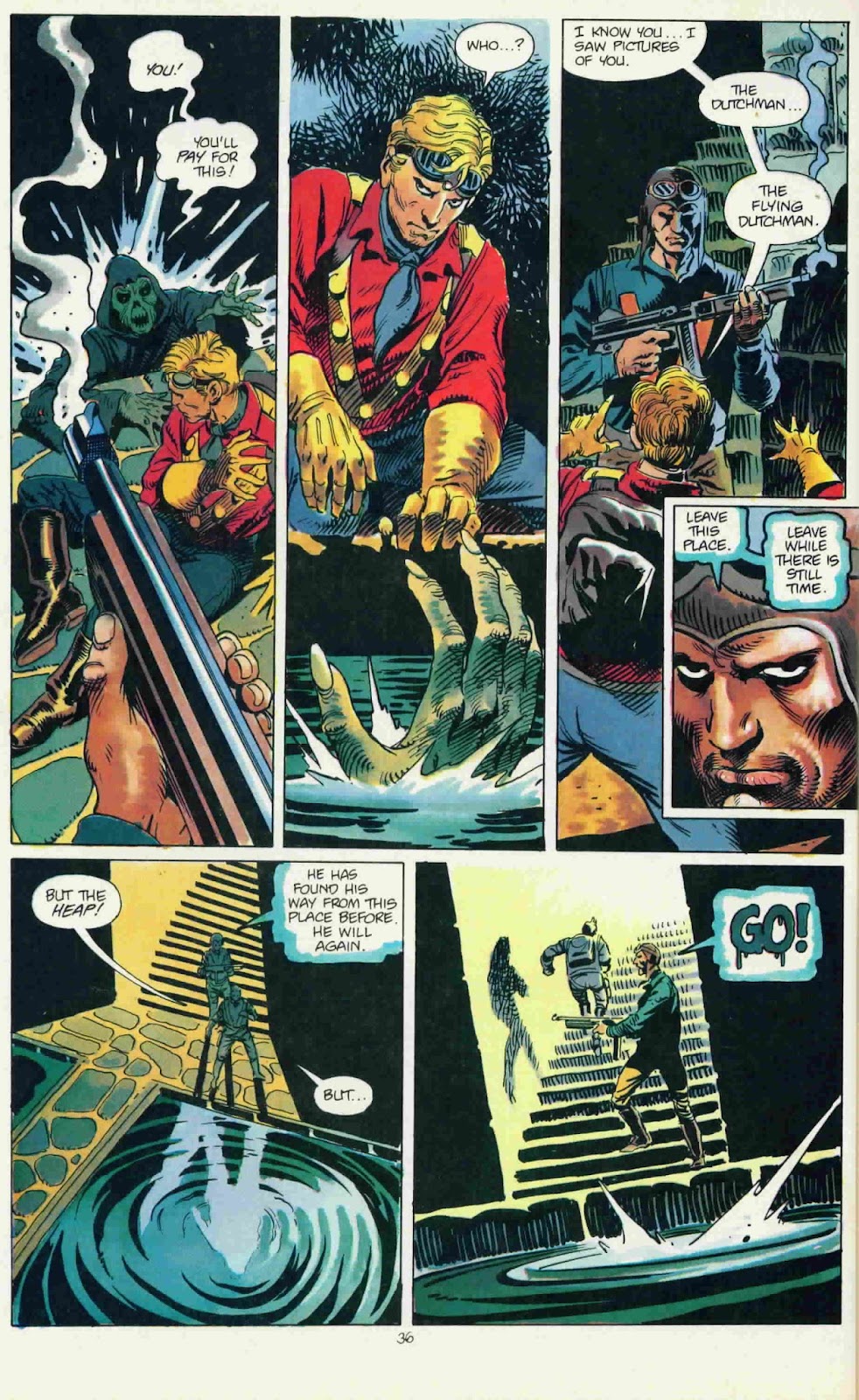 He tells him to go and that the Heap will find his own way out. Davy runs into Mr Hughes, gassing up his bike. Davy borrows it, after assuring Mr Hughes he has had his shots and promises to return it to the Sands Hotel and Casino. Davy heads for the portal asthe nuke goes off in misery's fortress. he is near the portal when he is hit by the shockwave and tumbles through. In Bogantilla, Skywolf and Lupina arrive at the castle and hunt for Davy. They find the shaman. he is dying, covered in radiation burns. he tells them that he held the portal as long as he could, but Davy isn't dead... 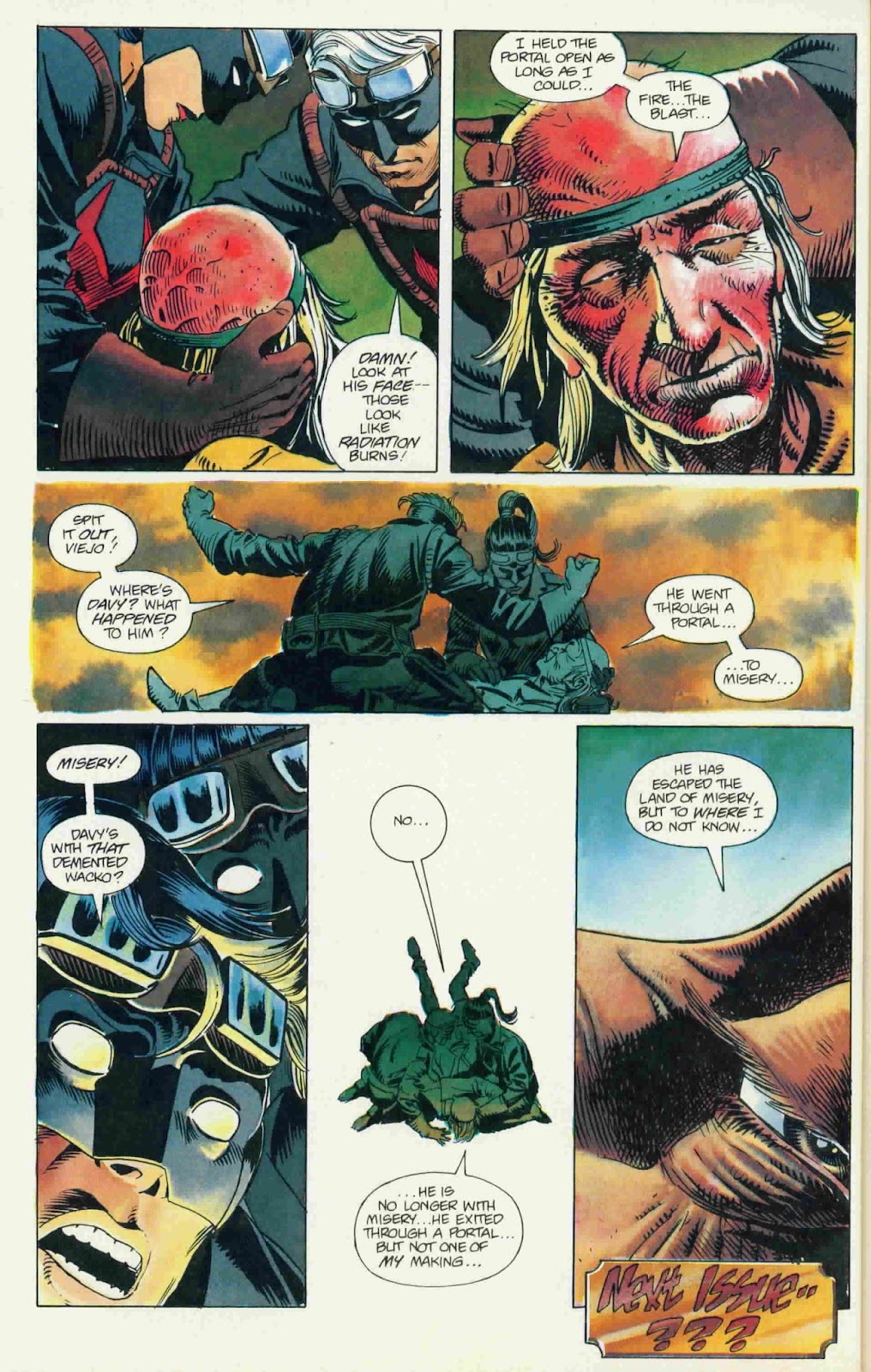 The letters page features cat making the announcement that Airboy is cancelled, with this issue. She cites a lack of a regular artist, chronic lateness, which she blames on Ernie Colon, slipping sales (from said lateness) and basic issues with the concept of Airboy as a youth hero in a real world environment. She also brings up political realism and uses this as an excuse to push their newer ventures, like Brought to Light, their new politically-oriented trading card sets, their upcoming Prestige Format series and graphic novels and the emphasis on such products, including the Black Terror mini and the Hobbit adaptation. She mentions that Chuck had planned another Shywolf period arc, where he would be involved in the Cuban Revolution, on Castro's side (which, compared to Batista, actually looked like the white hats. You'd have to ask Cubans if that was reality or not) She witholds plans about Airboy, saying they might continue in a graphic novel, though one never came and it was unlikely it ever would (see below). Thoughts: You can't get much better than this, for a series finale. The stakes are high and the mission is desperate, as Airboy battles Misery, in his own realm and tries to destroy it. can a nuke really destroy Misery? We will never know, thanks to cat. I'll get to that. Chuck goes out with a bang and this is the series where he really cut his writing teeth, though he had already been earning his bones on Evangeline, before this. From here he went on to be one of the more reliably entertaining writers in comics, at both DC and Marvel, writing everything from Batman books (including launching Tim Drake, as Robin), to creating the Birds of Prey series, to dabbling more in Men's Adventure pulp, with the Punisher. The book is gorgeous, with the Kubert Brothers just going to town with things, looking like chips of the old Pa. At this stage, their work was very much in the style of their father, especially Adam. Andy was a bit more individual in style and this grew as he moved into the X-Men world and added Imagey touches, though with a far better grasp of anatomy and storytelling (and fewer molars). Adam seems to be the one for the textures to their joint material, as he worked with his brother on DC's less than beloved Adam Strange mini (Thank Broom that James Robinson rehabilitated that, in the pages of Starman). Howard Hughes is a nice touch, as another dead aviator, forever at his vital age, riding in the desert. Chuck adds nods to the film Melvin and Howard, based on Melvin Dummar's claims of meeting Howard Hughes in the desert and a will naming him an heir. Sadly, we will never know where this would have gone. Cat's excuses on the letters page don't hold water. In interviews and the Airboy Archives, Chuck states that he an cat started to butt heads during the Afghanistan storyline, as she took issue with the mujahideen being portrayed as heroes. She insisted in putting in material about their attitudes towards women. Given that some of them went on to form the nucleus of the Taliban, there is merit to that; but, that is a case of cat imposing her own political viewpoint on an adventure series, because she had the power. Chuch was and is a Goldwater Conservative (his words), while Tim truman considered himself a lefty, as was Tom Yeates (whose Reagan autographed picture joke panel caused no end to grief with Reaganite readers). Tim was more concerned with solid pulp adventure, with visual flair and real world situations and the political balance in the series was pretty good and even-handed. The good guys had shades of grey and we saw Guillermo prove to be a better revolutionary than presidente. Davy had to grapple with noble intentions and economic realities. Skywolf consistently showed his lust for adventure led to a life of pain and misery, but he was unwilling to break the cycle. It was a rich world of characters, with Les Mansfield adding another fun aspect. Cat threw Ernie Colon under the bus, saying he was chronically later and held up the series, causing sales to drop, while this issue was already in house. According to the release data at Mike's Amazing World, there was only one delay during Colon's run, between issues #48 and 49, a period of 4 months. the other 3 issues were all published with the regular monthly frequency. That doesn't explain why there was another 4 months before this book, allegedly complete and in house, was published. the truth of the matter, from interviews and my conversation with Mike Grell was that Eclipse had serious cash flow issues and had bounced too many checks with printers and other suppliers. They were requiring cash in advance to print books for Eclipse, which greatly affected Grell's James Bond mini (all work was in house, yet it took over a year and a half after the first issue for the third and final to be published. Eclipse had tried to go with newsstand distribution, to compete beyond comic shops and failed, just as Comico and First Comics had. Newsstand distribution requires being able to sell to clients and speculating on print runs. Unsold copies are returnable, traditionally, which leads to higher losses. Eclipse was trying to sell through Waldenbooks and B Dalton, who saw a demand for comics and graphic novels; but who had trouble reaching beyond the existing audience, that overlapped with comic shops. Everyone failed in this realm, with only Archie weathering the storm to continue to sell in grocery stores and elsewhere, as the direct market had proved hostile to their books (the shop owners that is, not necessarily readers). They continued to make do with checkout lanes and shrinking newsstands. Eclipse was a mess, financially, and was chasing prestige dollars, in the book trade market. they would soon cut a deal with Harper Collins to publish their tradebooks and graphic novels, for the retail book market. However, Harper Collins was the 200 pound gorilla in the arrangement, with terms greatly favorable to them and a reputation for treating little people like dirt (they are part of the Murdoch empire) and they were chronically slow in paying Eclipse their royalties. They also didn't exactly put a lot of money into promotion for these books, apart from a select few, like Dave Wenzel's The Hobbit adaptation. That thing sold for years, even after Eclipse's demise (as it was a licensed adaptation and property of the Tolkien Estate). They were also chasing name projects, with their new Clive Barker projects, as well as similar things, with prestige trappings, like Jon J Muth's adaptation of Fritz Lang's M and new collections of P Craig Russell's opera works. All of this would come tumbling down, as eclipse became more and more erratic with their release schedule and creators stopped working with them. series went unreleased or unfinished, as payments to creators fell behind. When Dean and cat's marriage fell apart, it was the final blow, though the company was pretty much in hospice for months, before that. Chuck never got to finish Airboy and the property seemed to end up with Todd McFarlane, except Eclipse didn't own the characters, just their versions of them, as they were in the public domain. Moonstone did an Airboy project and then James Robinson came out with his gonzo Airboy thing. IDW reprinted Airboy in Archive books, bringing things sort of full circle, as Dean Mullaney was working with them on their Library of American Comics releases, as well as stuff like Corto Maltese. Airboy was a terrific adventure series, with layered characters, exciting plots, outstanding gritty art and more than a bit of humor. The Skywolf strips were my real favorites, as Chuck and his collaborators took us on a jounrey through post-WW2 America's shadow wars and other murky playing fields, as the flying soldier of fortune got into more trouble, at every turn. He even found himself in suburbia, in a marriage that quickly fell apart. It would have been nice to see the modern Riot reunited with Sky, even for just one adventure. So, this closes the Airboy chapter on the book of 4Winds. However, we aren't done, as Scout: War Shaman still has 4 issues to go and we have Tim Truman's historical graphic novels, as well as the international ones, from the Argentine crowd, and one close to home, from Sam Glanzman.
|
|
|
|
Post by codystarbuck on May 26, 2021 18:32:49 GMT -5
Scout: War Shaman #13 Beau La Duke vs Ninjas! That's like John Wayne battling Sho Kosugi! Creative Team: Beau Smith-writer, Tim Truman-co-writer and finishes, Todd Fox-layouts, Tim Harkins-letters, Sam Parsons-colors, cat yronwode-editor Not only isn't Truman the main writer, he also isn't doing the initial drawing. I suspect this is related to his workload, from other projects, as I think, he was working on volume 1 of Wilderness and/or he was definitely working on Hawkworld, which would come out in June 1989 (this is April '89). Truman was doing story and pencils on Hawkworld, plus painted covers, while doing story and layouts on War Shaman. Also from Eclipse: Appleseed Bk II #3, Cyber 7 #2, Dirty Pair #4, Dr Watchstop HC, James Bond: Permission to Die #1, Total Eclipse #5, Weasel patrol #1, Zot #26. Eclipse continues to decline in quantity, on average, with Scout and the manga titles being the only really regular books, though Zot was keeping a relatively consistent bimonthly schedule, at this point. Dr Watchstop was the hardcover edition of the previous trade release, collecting the back-up stories from Fusion. Weasel Patrol was a one-shot spin-off of Fusion, starring the popular animal characters from the book. These guys were both cute and entertaining and Fusion was a pretty decent indie comic. Probably could have been a pretty good animation property, if they had had an agent, like Eastman & Laird. By the 90s, everyone was getting a cartoon, even Xenozoic Tales (aka Cadillacs & Dinosaurs)! Total Eclipse was waaaaay late, summing up both that series and Eclipse's financial state (nearly a full calendar year to publish 5 issues, intended to be monthly). I sometimes wonder if anyone besides me was there, at the end. James Bond was the highly anticipated and marketed James Bond mini-series from fan and fan-favorite writer/artist Mike Grell, who had done several homages in Jon Sable. now, he got to tackle the real thing, mixing in elements of both Fleming and the film series, plus a few touches from the then-current John Gardner series of novels (like Bond's ASP 9mm pistol). Sadly, Eclipse's financial issues derailed this series, too, causing massive delays between issues. That led to an end of the deal with Acme, who took the Bond license to dark Horse, after Eclipse only published the 3 issues of this series and a one-shot adaptaion of License to Kill, from grell and Tom Yeates. Synopsis: When we last left Beau La Duke, his squad had been ambushed by ninjas, along the US Canada border and he was on foot, trying to get across the border. we pick up the action, as he meditates on new vs old snow... 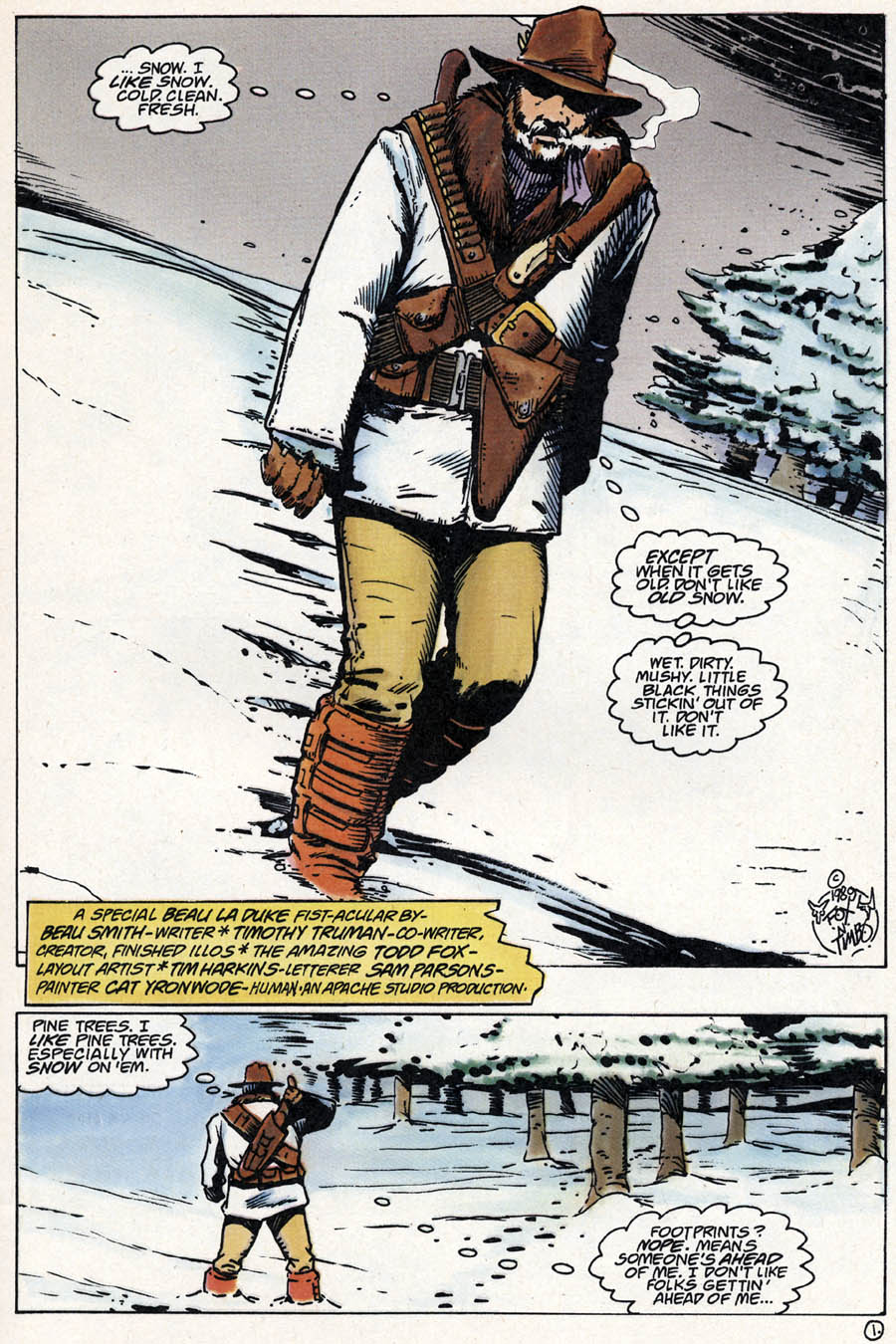 Who says Beau isn't a deep thinker? Footprints point to a grove of pine trees and Beau is wary, since they are in front. However, the ninja is above, as he drops out of a tree. Beau teaches him a few dances and then adds some buckshot, for his friend... 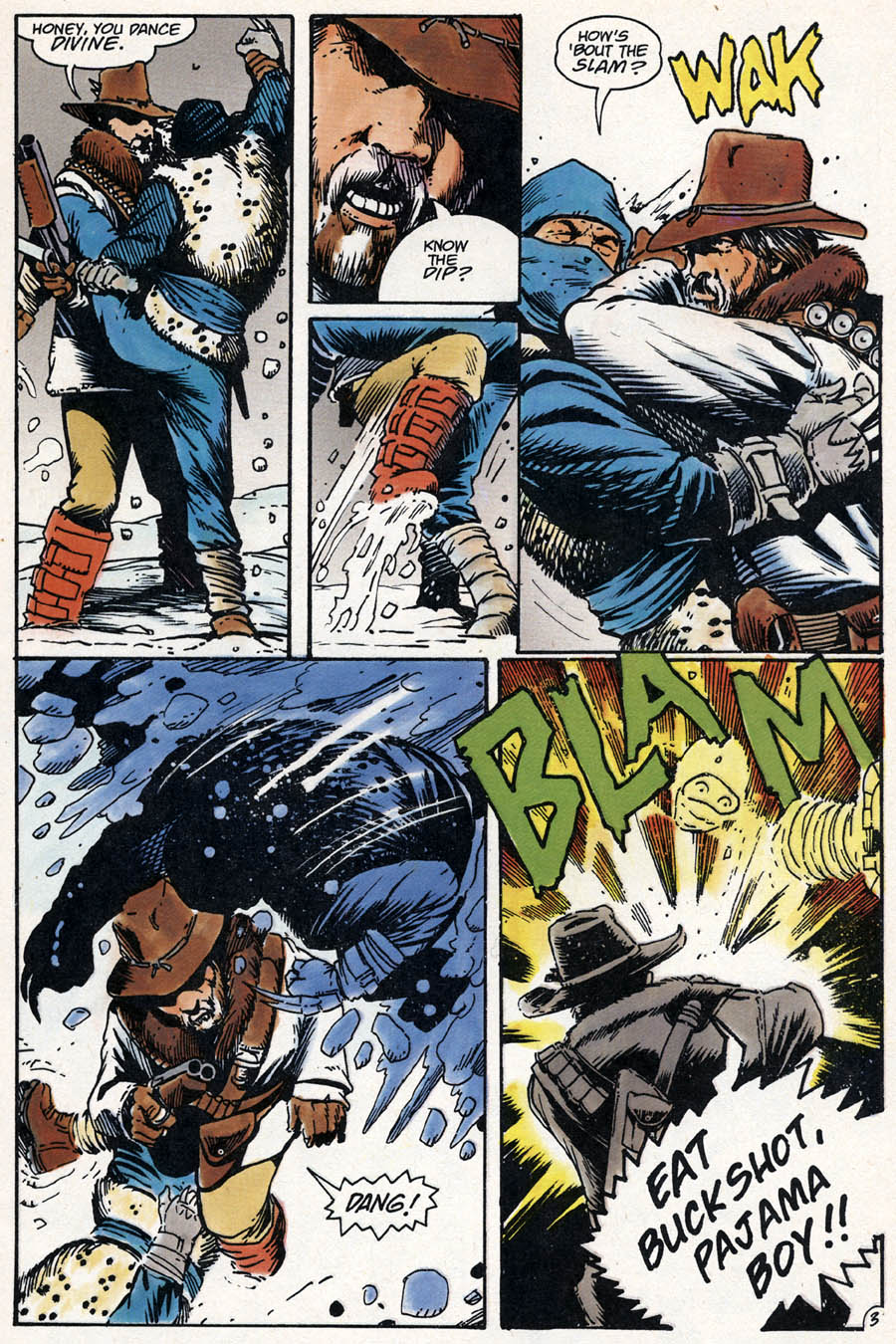 You know, Kurt Russell would be perfect for a Beau LaDuke movie. Just saying. It's ninjas vs cowboy for a few pages and Beau gets POed when one of them slashes his face with his Lee Press-On Claws Official Wolverine Home Kit. Turns out that Sho Kosugi is more of a Mie Hama (a lady). Beau just shrugs her off when he runs into Black Jacques Shellacque, a Canadian killer... 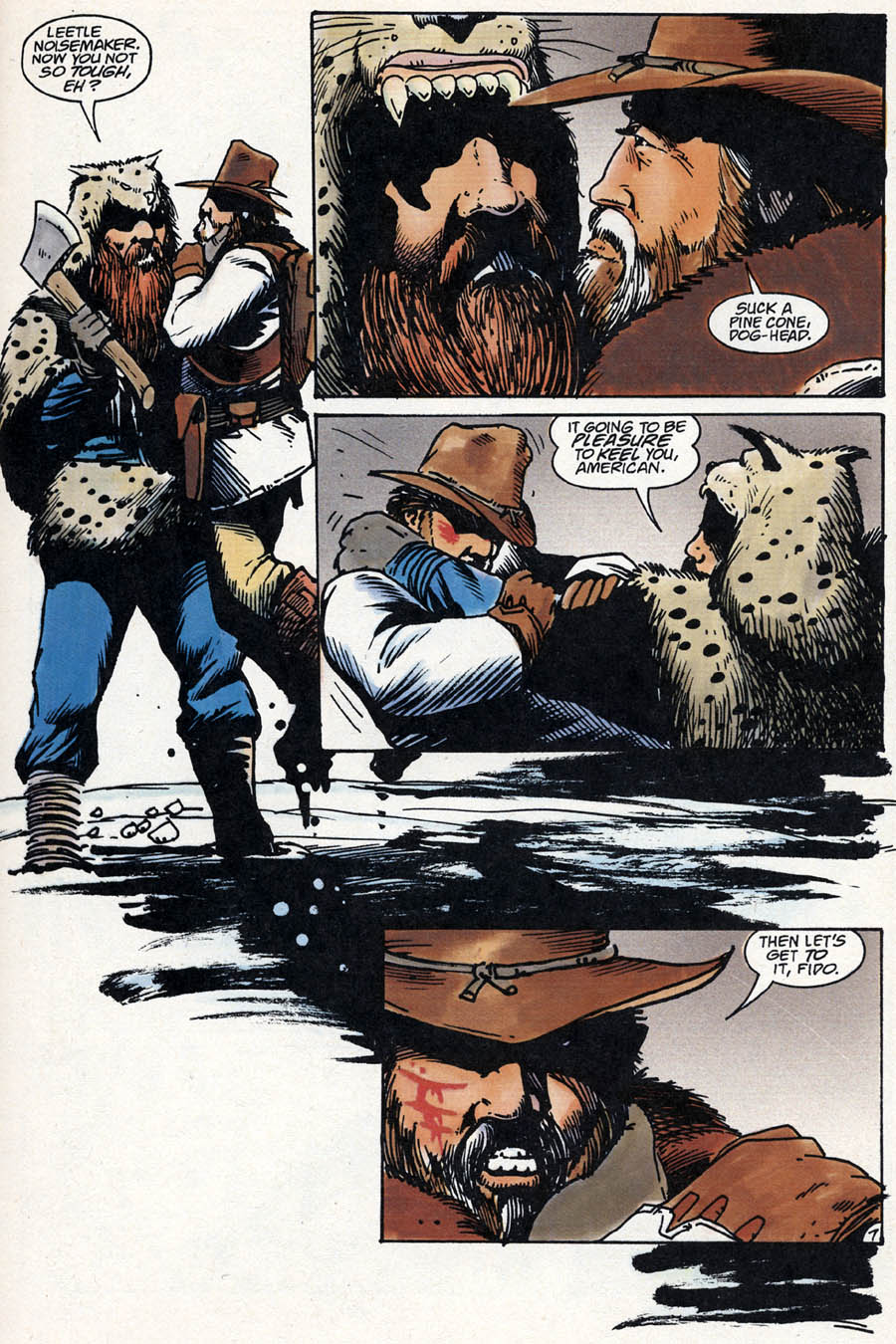 Beau takes the Canuck down rather easily, then turns his attention back to the Ninjette, who has amscrayed. Beau finds a Chevy pickup nearby and heads off in it, when Ninjette returns and attacks. She talks for a bit, then backflips off the hood of the truck before Beau can shoot her and disappears again. She was part of the group that ambushed Beau's squad. Beau goes hunting and ends up snared by none other than RW Hardin, tremayne Wayne, Ninjette, and some other goon (big feller). 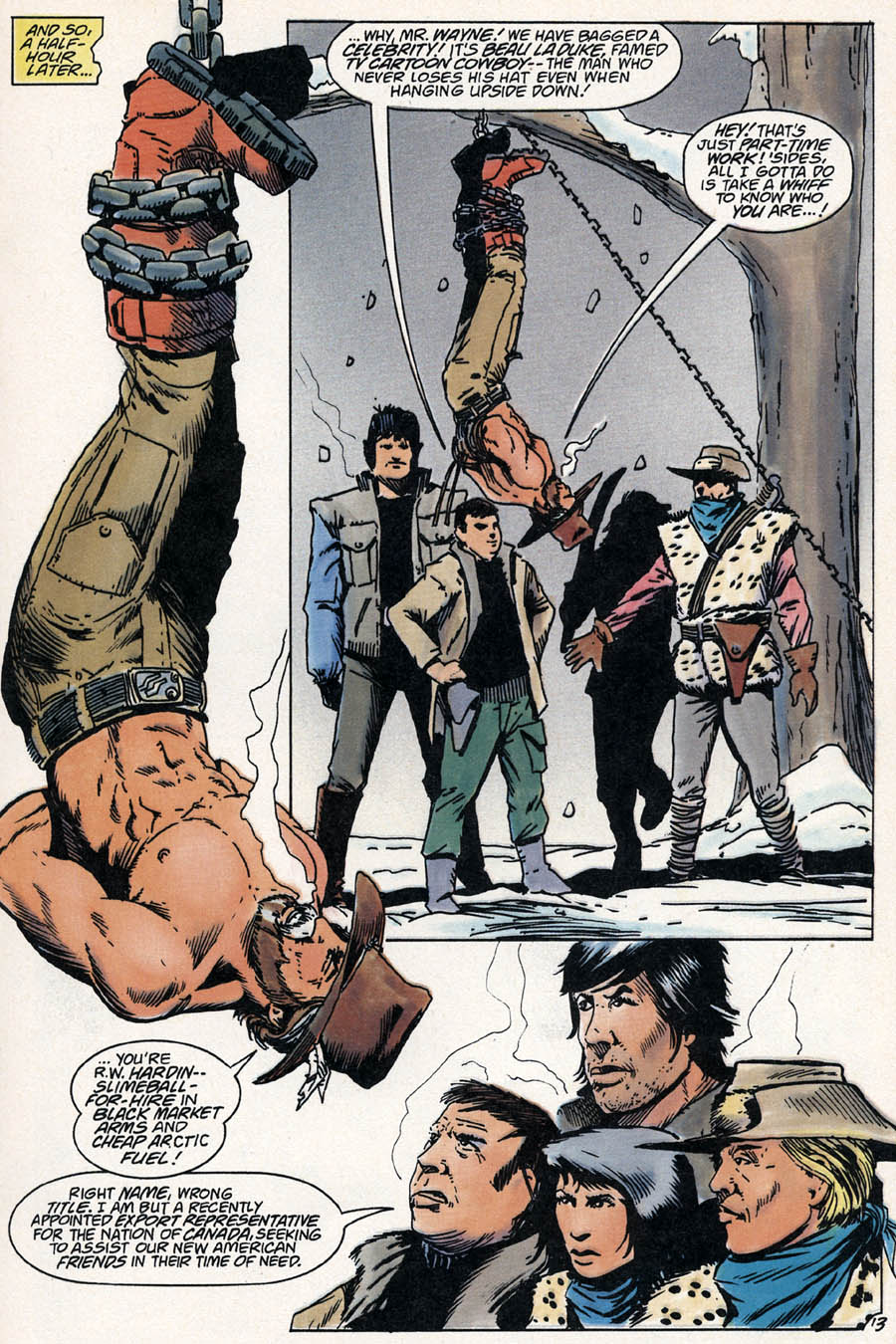 The big fella turns out to be Boomer, the brother of Jacques (he actually was named Jacques, even before I tossed out the joke). Hardin leaves Beau to the fun of the stooges and they argue who gets to kill him. Tremayne cuts him down and shoots the chains of his legs, then tells Boomer he gets first crack, for Jacques. Boomer goes to stomp him (oh, he's Archie Gouldie!)...  (Archie Gouldie, aka The Stomper, aka The Mongolian Stomper) ...but Beau blocks him and kicks him in the face. Ninjette attacks and Beau blocks her sword stroke with a length of chain and an elbow to the back of the head. He then breaks her katana across his knee (uh, no....). tremayne eggs him to attack and Beau throws him off balance by hurling the broken tip of the katana at him, then tackling him when he jumps aside to avoid it. Ninjette grabs Beau's leg, to interfere. Beau and Tremayne go tumbling down the mountainside and end up by Hardin's factory, below. He grabs a loose MP5K submachine gun and RW Hardin tries to attack with what looks like a combine harvester, repurposed as a tank... 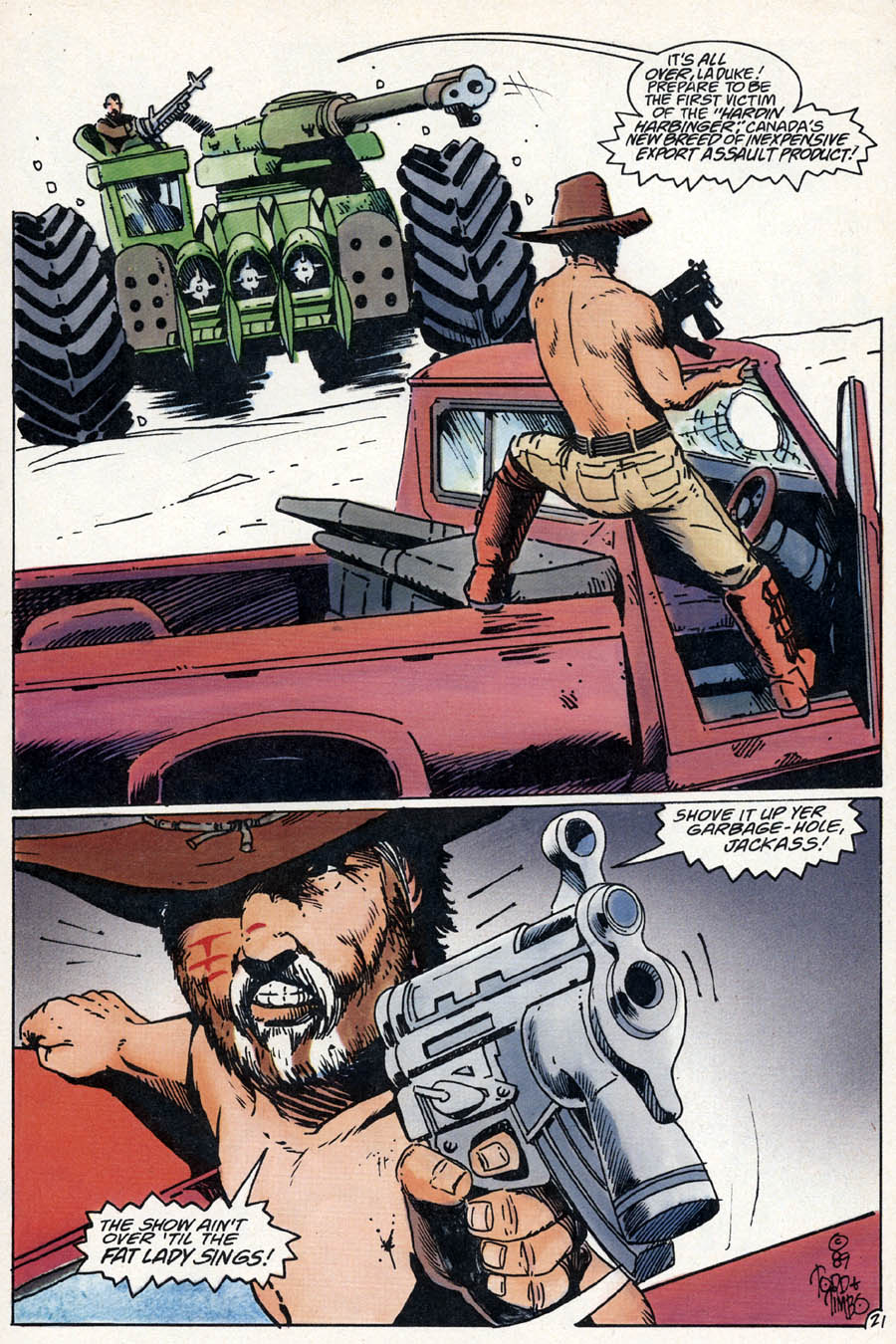 Beau lets fly with the weapon and kills the driver, then disables the tank with the truck body. Hardin, in the gun tub, fires Tremayne, who goes Johnny Paycheck on his hinder... 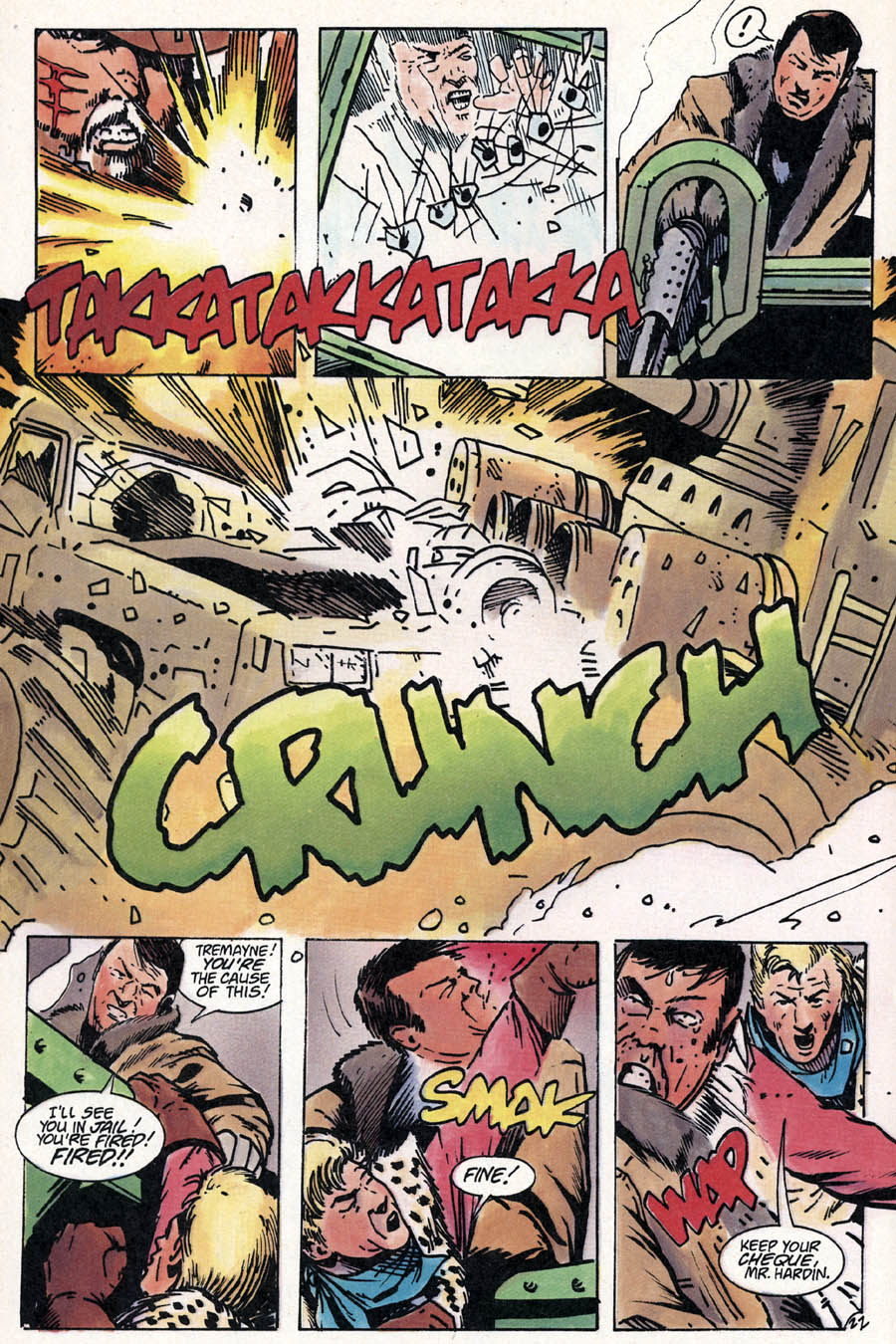 ...but it is broken up by Hardin's men. That is, until Beau sprays a magazine into the crowd. Tremayne and the Ninjas (sounds like a 60s surf guitar band) help out and take Hardin prisoner, destroy his factory (for money owed) and leave him tied up, hanging upside down from the tank's gun. Beau advertises his upcoming mini (Smith, that is) and we wrap up the issue... 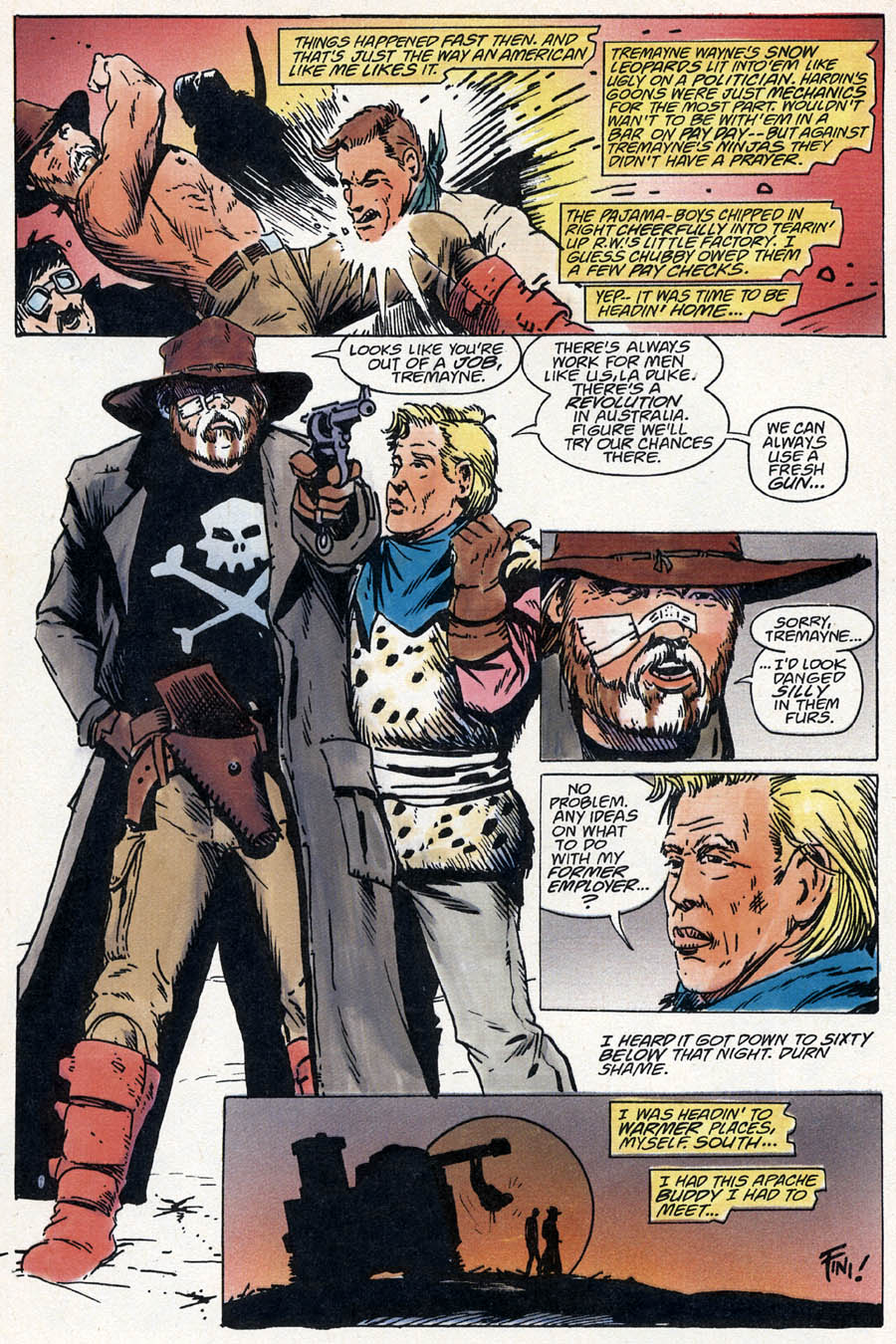 The letters page is handled by Beau, who reminds us of the Scout display contest and shows us the winners 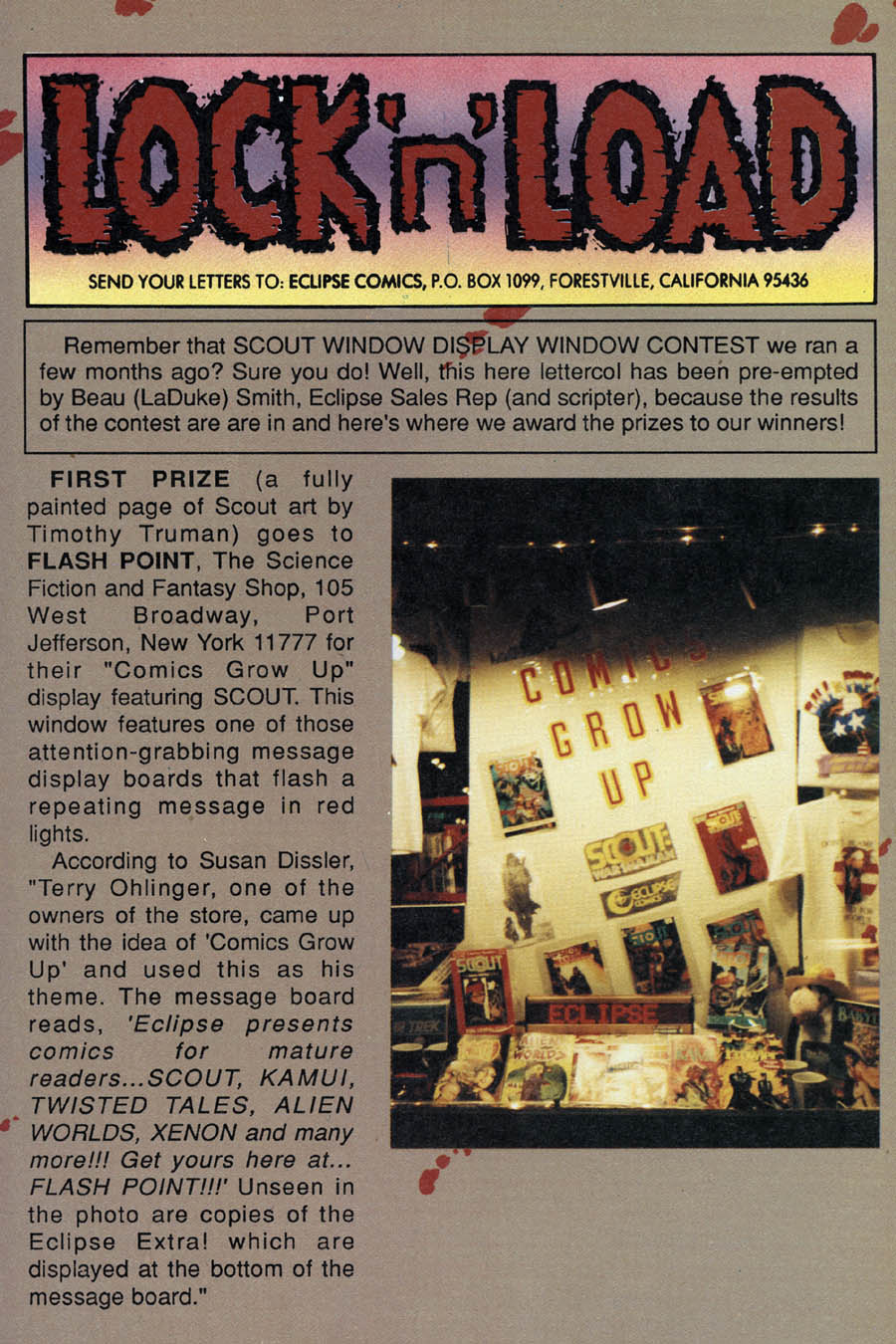 Thoughts: Thoughts: Fun issue that acts as a bit of a palate cleanser, after the Redwire stuff and the attack on the train, last issue. Not a whole lot of plot, but plenty of over-the-top mayhem for action fans. Of course, it is all from Beau's point of view, so the fight might have been a little tougher than he lets on. Todd Fox was Beau's find, at the Chicago ComiCon (the name of it before Wizard World sucked all the life out of it). he was actually a radio DJ and sound man at an Evansville, IN tv station, who dabbled in art; and, who, according to Beau, was the spitting image of Airboy. Beau remarks to the ladies out there (in a 1980s gun-toting adventure comic? Not many!) that he is 6 ft, blonde and single. The fight is nicely staged and Truman makes it look like his stuff. I, personally, love the combine-turned-tank. My grandfather was a farmer (both were, at one point, but my paternal grandfather spent his whole life as one) and my uncle farmed nearby (and worked for GTE Telephone) and some of my best childhood memories are of having the run of the farm, playing with my cousins (my cousin Steve and I are only two weeks apart, in age), using the outbuildings and equipment to stage elaborate adventure fantasies (usually involving large quantities of toy guns). My uncle had a big combine (either an International harvester or an Allis Chalmers, I think) and that became our super vehicle, when it wasn't in use (if it was, an old derelict tractor would stand in for it). So, imagine my delight at seeing a great big gun turret mounted on a combine base? Sheer heaven! Beau is always fun (well, the back-up story in swords of Texas wasn't that great; but, neither was the lead feature), as it is a big ol' John Wayne gonzo mess of violence and humor. Like I say, Kurt Russel, playing it like Jack Burton, in Big Trouble in Little China (with a bit more twang) would be just perfect (maybe Dennis Quaid, if he felt like having fun). The female ninja isn't given a name, hence the Ninjette name. I concocted a mercenary character for a potential YA adventure series, called Ninjacques, who would be a French ninja chef. One of these days..... I get the feeling, based on the dialogue at the end, that Beau anticipated using Tremayne Wayne in another feature, as he mentions a rebellion, in Australia (I assume by the hat that Tremayne is from Oz). The character (along with RW Hardin) was credited to Beau and Todd Fox, in last issues credits, so it was someone they concocted. Seems like they intended more than what we see here. To my knowledge, it never came about. Tim was involved in another series, Newstralia, with Stephen Sullivan, which was published at Innovation and featured a rebellion in Australia. That book was conceived by Tim, as part of an assignment at the Kubert School. He met Sullivan at TSR (Truman illustrated game books, while sullivan wrote them) and they worked together to flesh it out. It was pitched to first Comics, when Tim started working on Starslayer, but First, who liked the concept, already had Mars going and didn't want to overload the line with sci-fi titles. Their careers took them in separate directions, though Sullivan shopped Newstralia around again, after finishing on Now's Racer X. He hooked up with Kevin Vanhook and they sold it to Dave Campiti and Innovation. It lasted 5 issues, and prominently used Truman's name to help sell it. So, now, we turn to the finale of this book, as we have 3 more issues, which will bring the battle of Scout, Rosa and Redwire to a head. Meanwhile, Beau tells us that Beau LaDuke will be featured in back up stories, over those 3 issues. Almost forgot, at the end, Beau LaDuke is sporting a Black terror Skull and crossbones t-shirt. Beau Smith teamed up with Chuck Dixon and rookie artist Dan Brereton to publish a 3-issue alternate history/crime fiction/superhero/vigilante series, based on the original Nedor Black terror character, who was in the public domain. The world features Al Capone as the power behind a corrupt government and the terror as an undercover agent, trying to bring him down. His cover is as an enforcer for a mob family, while the masked persona allows him to attack Capone's mobs. Brereton gave it that nice pulp look. It was published in the Prestige Format (aka Dark Knight Format), with Brereton's signature painted art. That book led to bigger things for the artist, with Psycho, at DC following, then his own Nocturnals, at Malibu's Bravura imprint. Beau was also Eclipse's sales director and he continued in that capacity until going to work for Todd McFarlane, at Image. he was instrumental in setting up Todd's bid for eclipse's assets, in the wake of their bankruptcy. The court accepted the offer (despite greater combined offers for various properties from their line) and the rest is history, not that it amounted to much. Mcfarlane's real aim was to acquire Miracleman; but, in the end, it was ruled that Eclipse never owned a stake in it as Dez Skinn didn't actually own any rights. If memory serves, McFarlane only used the Heap and maybe Black Terror (there was something related to him, as I recall). He didn't even own the Heap, since that was in the public domain before Eclipse picked up the characters. Oh, the Archie Gouldie photo. Archie Gouldie was a big, tough Canadian, from Alberta, who played for the Saskatchewan Roughriders, in the CFL. After or while playing football, he went to Stu hart's place to become a wrestler, training in the infamous "dungeon," the Hart's basement gym. He became one of Stampede Wrestling's (Stu harts promotion, in Calgary, with matches at the Calgary Stampede) most notorious villains, known to tear up the ring in wild brawls with the babyfaces, including Stu (while he was still an active wrestler) and his sons, Bruce, Keith and Bret. There, he was Archie "The Stomper" Gouldie and one of his signatures was stomping his big feet down on an opponent. He wrestled beyond Canada, working for the Kansas City promotion under his own name, then eventually shaving his balding head and becoming the Stomper, a supposed Mongolian monster who terrorized rings in the southern territories (Tennessee, Florida, Georgia, Alabama) as well as San Francisco and Puerto Rico. After partially retiring from the ring, he went to work as a sheriff's deputy, in Knox County, TN. To stay in shape, he often cycled the mountain roads to and from work and also worked part time for Jim Cornette's Smoky Mountain Wrestling, in the mid-90s. He used to cycle to the tapings and matches, to the amazement of the younger talent. Gouldie was pure iron, covered by muscle and skin, one of the legit tough guys in the business. As Archie Gouldie, he cut terrifying promos that even scared the Hart children, fearing the madman, then later meeting him at the house, for dinner, while he was mute, as the Mongolian stomper, in the US. Mute or growling, he would have made a great addition to Scout.
|
|
|
|
Post by codystarbuck on May 26, 2021 18:51:00 GMT -5
ps Around this time, eclipse marketed some t-shirts, via mail order. There were three designs available: The Black Terror, Miracleman and Zot, all with the character symbols, designed to look like their costume shirts. I ordered the Miracleman and Black Terror t-shirts. I wore ou the Miracleman one first, but had the Terror shirt for about 10 years or more, before it was worn out. Loved that shirt.
|
|
|
|
Post by codystarbuck on May 30, 2021 21:08:41 GMT -5
Scout: War Shaman #14 Scout saying hello to the neighbors! Creative Team: Tim Truman-story & pencils, Ricardo Villagran-inks, Tim Harkins-letters, Sam Parsons-colors, cat yronwode-editor Beau La Duke: beau Smith-writer, Todd Fox-pencils, Villagran, Harkins, Parsons same jobs. Truman edits. Also from Eclipse: Air Fighters Classics #6, Appleseed Bk II #4, Cyber 7 #3, Fusion #15, Stormwatcher #2, Tales of the Beanworld #13, Tapping the Vein #2. Air Fighters Classic is the final issue of b&w reprints of Hillman material, given that Eclipse was going to pull the plug on the series with issue #50. Some manga, some Barker and a couple of old favorites and not much else from Eclipse. Their releases would be far sparser from past days. Synopsis: Redwire and Capt. Atuma Yuma (the river pirate, from issue 3 & 4) are testing out some new firearms, by making a Native American run like a rabbit. 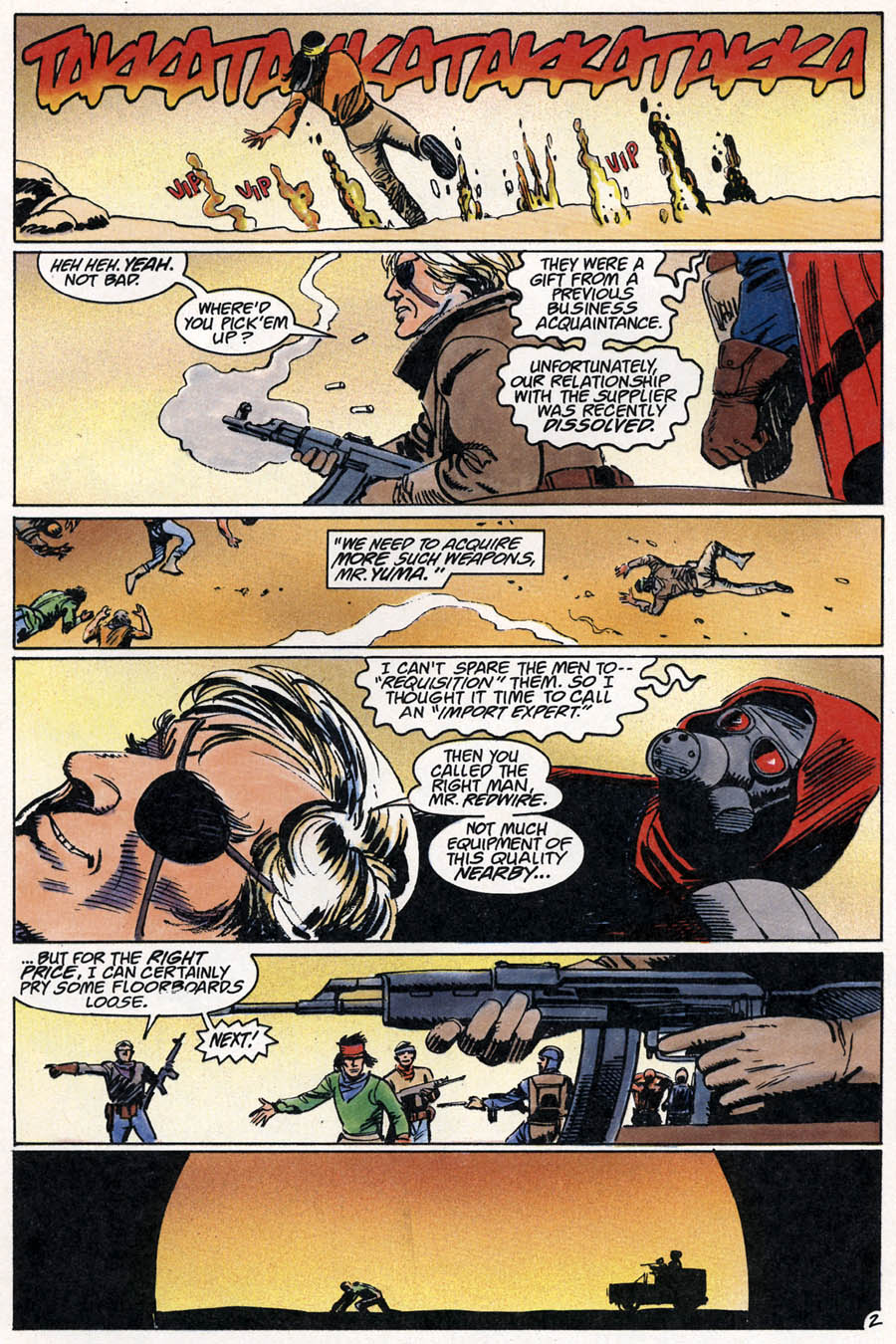 They are pelased with the weapons and Redwire wants more and hires Yuma to get them. From a distance, Scout, Rosa and Beau La Duke watch. Santana has had enough and calls for a clip of .303 ammo for his Enfield. Rosa says to forget it, but the discussion is rather loudly interrupted by the rev. Sand Dog Yuma, an old acquaintance of Beau (from his back-up tale, in Swords of Texas) and he alerts them to another issue, on another ridge. Scout trains a telescope on it and sees a mobile missile battery and soldiers. Sand Dog says the trops wiped out most of the Hopi village and are trying to entice the survivors out to be slaughtered. however, he knows where they can get some weapons and ammunition. beau goes to purchase the weapons while the rest go to Walker's hidden caves. Scout is reunited with Victor and Tahzey and Victor remarks that he could feel his father coming home. Rev Yuma and Father Robillard have a discussion in comparative religion, along the lines of calling each other heathen unbelievers and servants of Satan. In the night Rosa comes to Scout to relive old times (aka the horizontal mambo), while Victor is off testing his abilities by levitating large rocks, with telekinesis. Robillard watches, in secret (though probably not to Victor). Later, after darkness, a surprise visits the ridge with the soldiers and Hopi captives.... 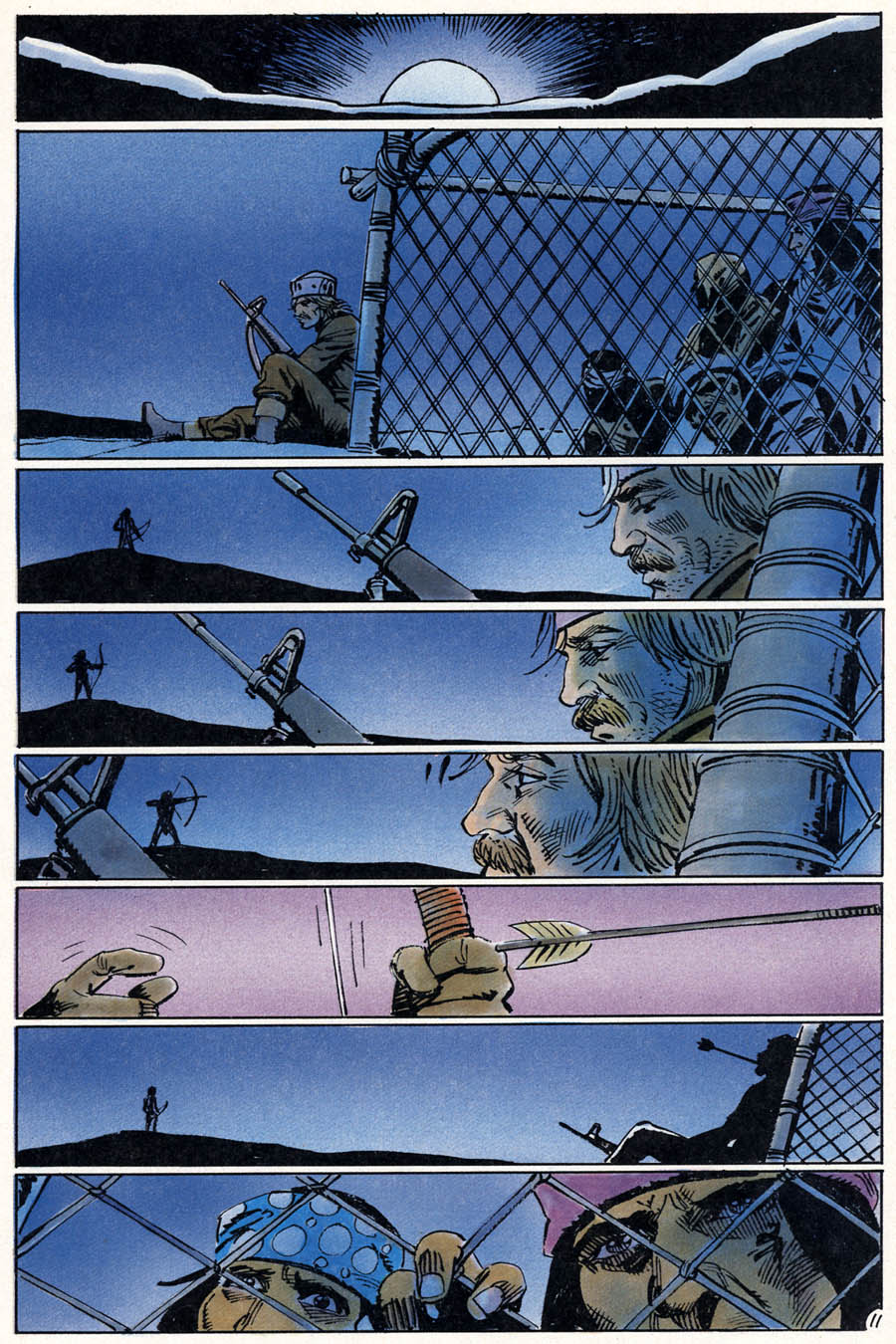 They lure out the soldiers and steer them into an ambush, then hit their weapons stash. Scout notices an owl flying above and halts. It is a bad omen. They search the stores, but see no sign of Redwire, until he surprises them... 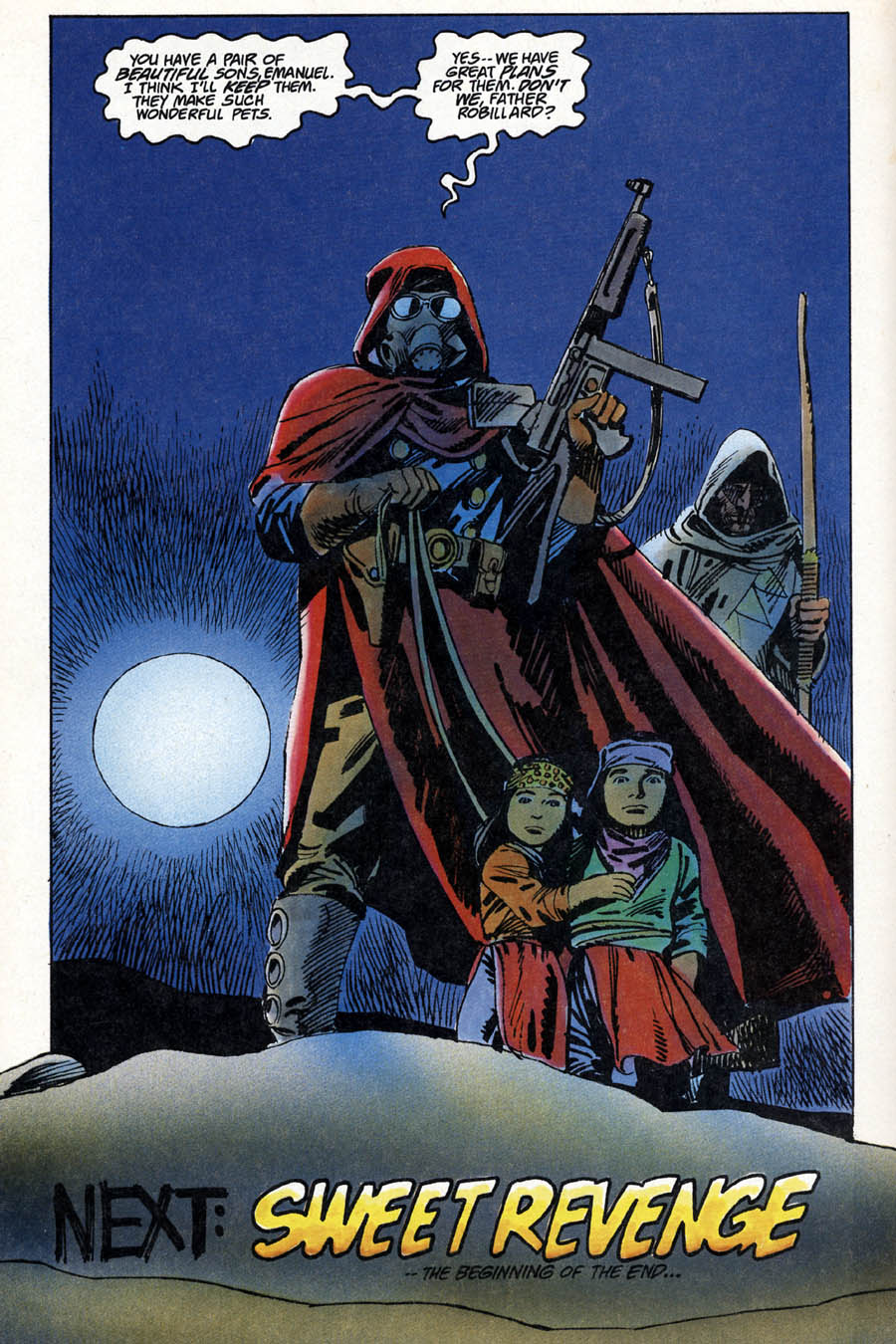 ...with Tahzey and Victor as his prisoners. The back-up tale follows Beau as he goes to purchase the arms. Beau walks into a bar........................ not making a joke, just Beau walks into a bar, to find McTaggert, the man with the guns. They discuss Beau's bar tab and Beau offers cash, in advance. The walls have ears... 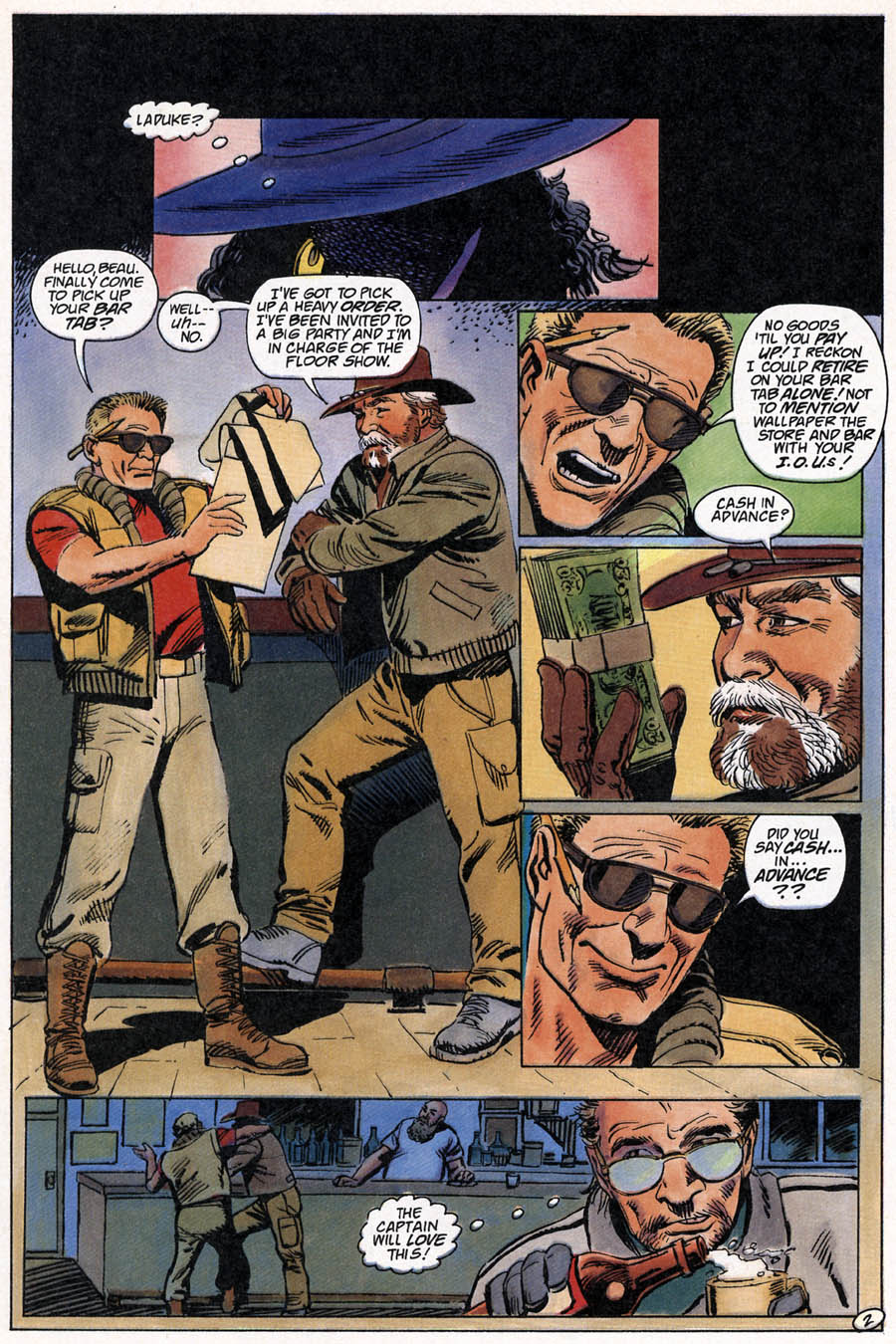 The ears have matching feet and they go of to alert Captain Atuma Yuma, who lays an ambush, to steal the weapons from Beau. However, Beau gets a little help... 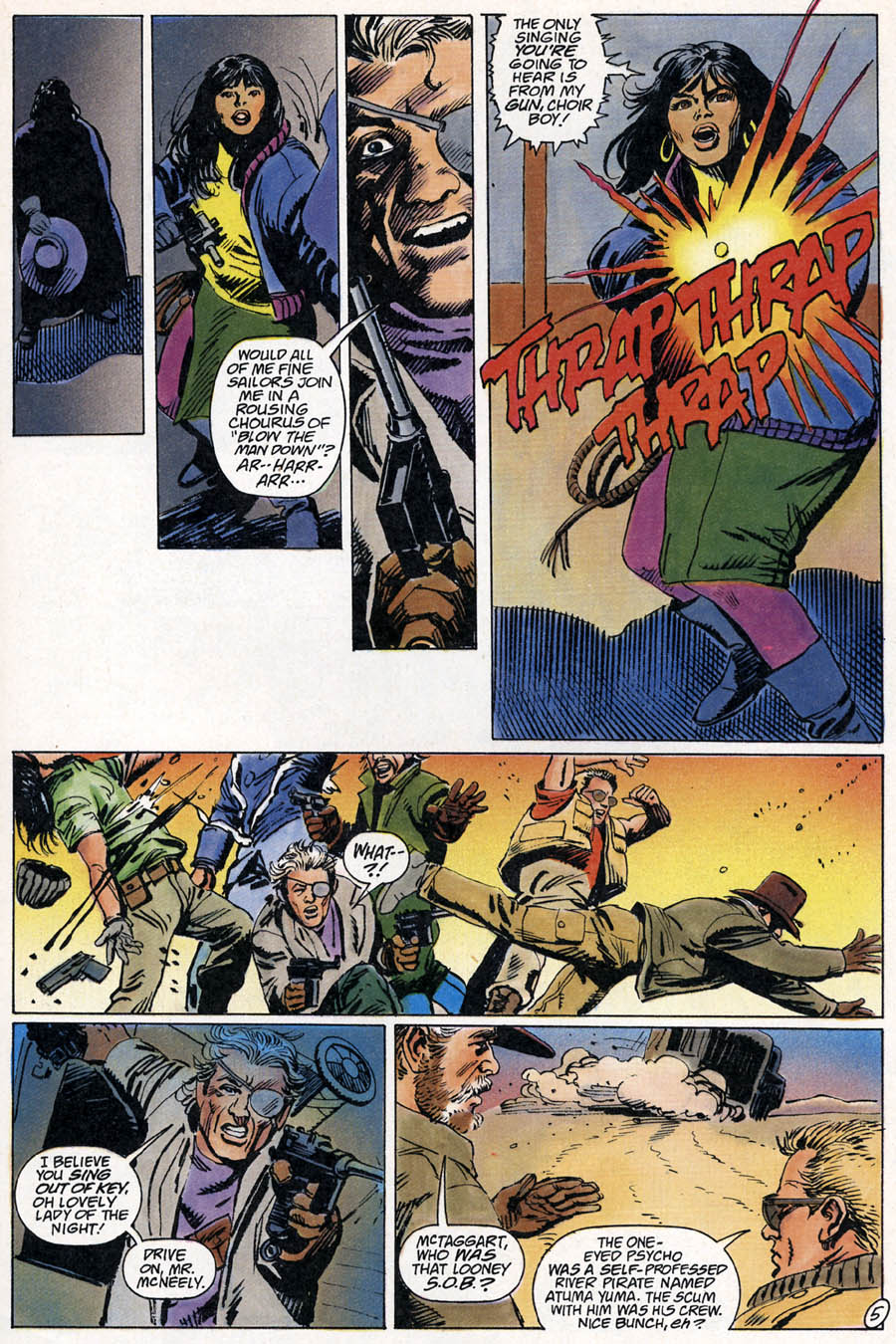 Yuma skedaddles and McTaggert introduces Rita Rodricho, a bounty hunter, after Yuma. Beau tries to borrow her bike and she declines, in a slightly testicular impacting manner. When he recovers, Beau goes after. Rita is down by the dock, sighting in on Yuma, when she is rustled by some of Yuma's pirates. She's hauled before him and about to be in real trouble, when Beau returns the favor.... 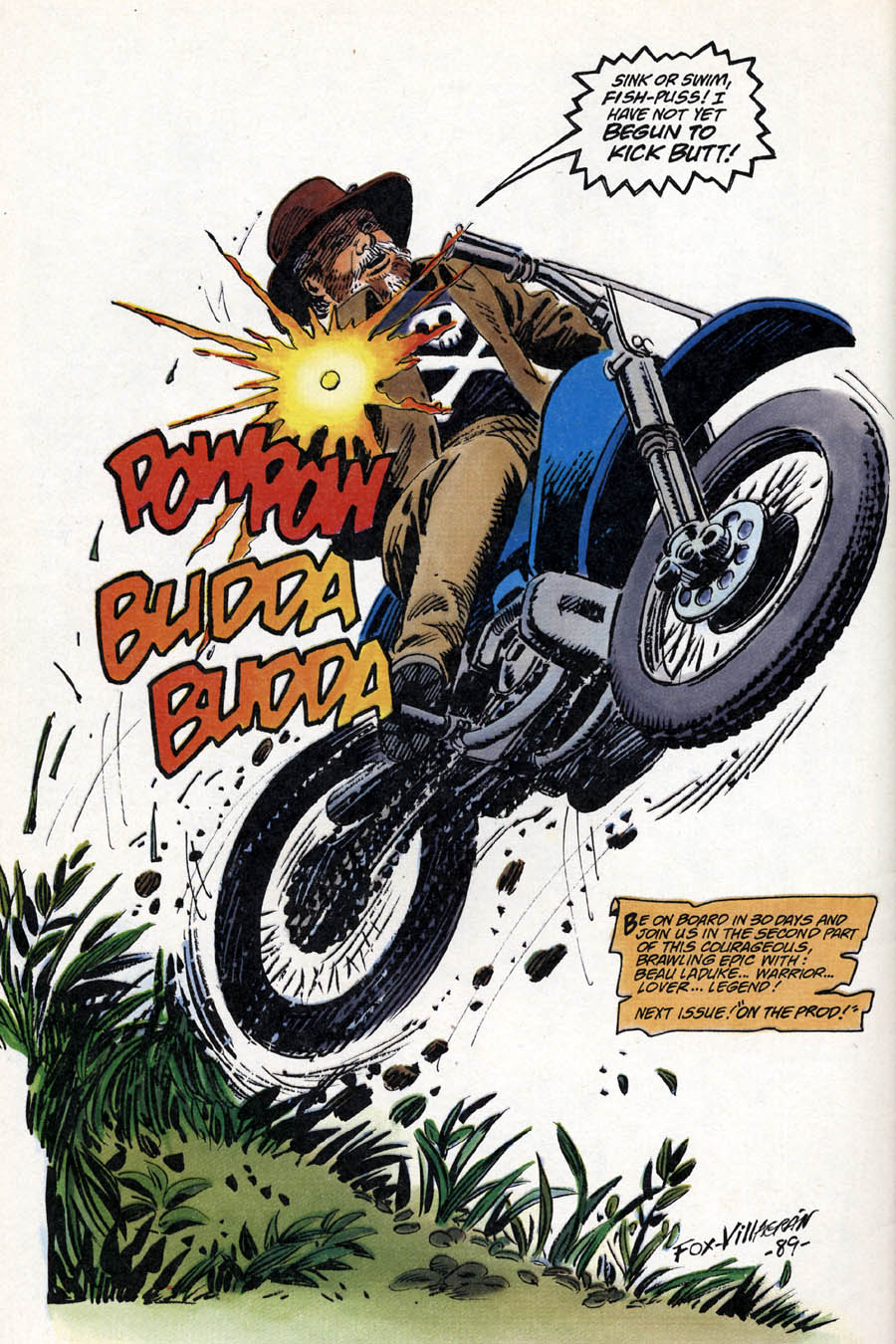 Thoughts: Thoughts: Lots of twists and turns and nastiness, as we build to the climax of this volume. Redwire has decimated the Hopi villages and is looking to hit Walker, if he can entice him out. He needs guns and so does Santana. beau goes for the guns and Rosa and Scout go for Redwire. Redwire has a surprise and accumulates more children of his enemies (he has Laura, already). Meanwhile, Beau faces Atuma Yuma, river pirate, while his brother the Rev sand Dog Yuma aids Rosa and Scout. Old home week for a lot of characters here. something big is about to happen. Not much character development as much as continuation. Victor's ability is growing; is that good or bad? Rosa turns to Scout for more than aid; is that a mistake on his part? Lots of intriguing things to get you back, next issue. The Beau La Duke story is fun, if a bit brief and a better representation of the character than the Swords of Texas storyline. He'll be back for more next issue, then issue 16 is the end, with everyone. You can sense that this is going to be a major event in the Scout series, even more than the end of the first series. Truman is back on art, with Villagran inking, likely due to his other commitments. They are a good match and Todd fox and Ricardo work well on Beau's story. 4Winds has been pretty consistent with the quality of illustration in their books, with similar artistic sensibilities, with John K Snyder III being the biggest outlier.
|
|
|
|
Post by codystarbuck on Jun 4, 2021 22:57:54 GMT -5
Scout: War Shaman #15 Creative Team: Creative Team: Tim Truman-story & pencils, Ricardo Villagran-inks, Tim Harkins-letters, Sam Parson-colors, cat yronwode-editor Beau La Duke: Beau Smith-writer, Todd Fox-pencils, Villagran et al same duties, Tim Truman-editor. Also from Eclipse: Airboy #49 (late), Appleseed BkII #5, Cyber 7 #4, Dirty Pair II #1, License to Kill, Return of the Valkyrie TPB, Zot #27. The manga titles, apart from Scout, were about the only things keeping close to a schedule. I suspect Eclipse was prioritizing their cash for whatever was doing well for them, sales-wise. License to Kill was the adaptation of the new Bond film, from Mike Grell and Tom Yeates, which is one of my least favorite Bonds. Taking down a drug lord should be like kindergarten, for Bond. Return of the Valkyrie reprinted the first storyline in Airboy and had a sweet Steranko cover. Steranko had done a whole chapter of his comic history on Airboy and Hillman. Zot is still chugging along, but coming out quarterly. It had a few brief moments where Scott McCloud managed a monthly schedule, but never for more than about 3 issues. For the same month, over at DC, they had an adaptation of some movie, based on one of their characters....wonder how that worked out? Penultimate issue; get ready.... Synopsis: Redwire has Tahzey and Victor. Father Robillard betrayed Santana again and he isn't happy about it.... 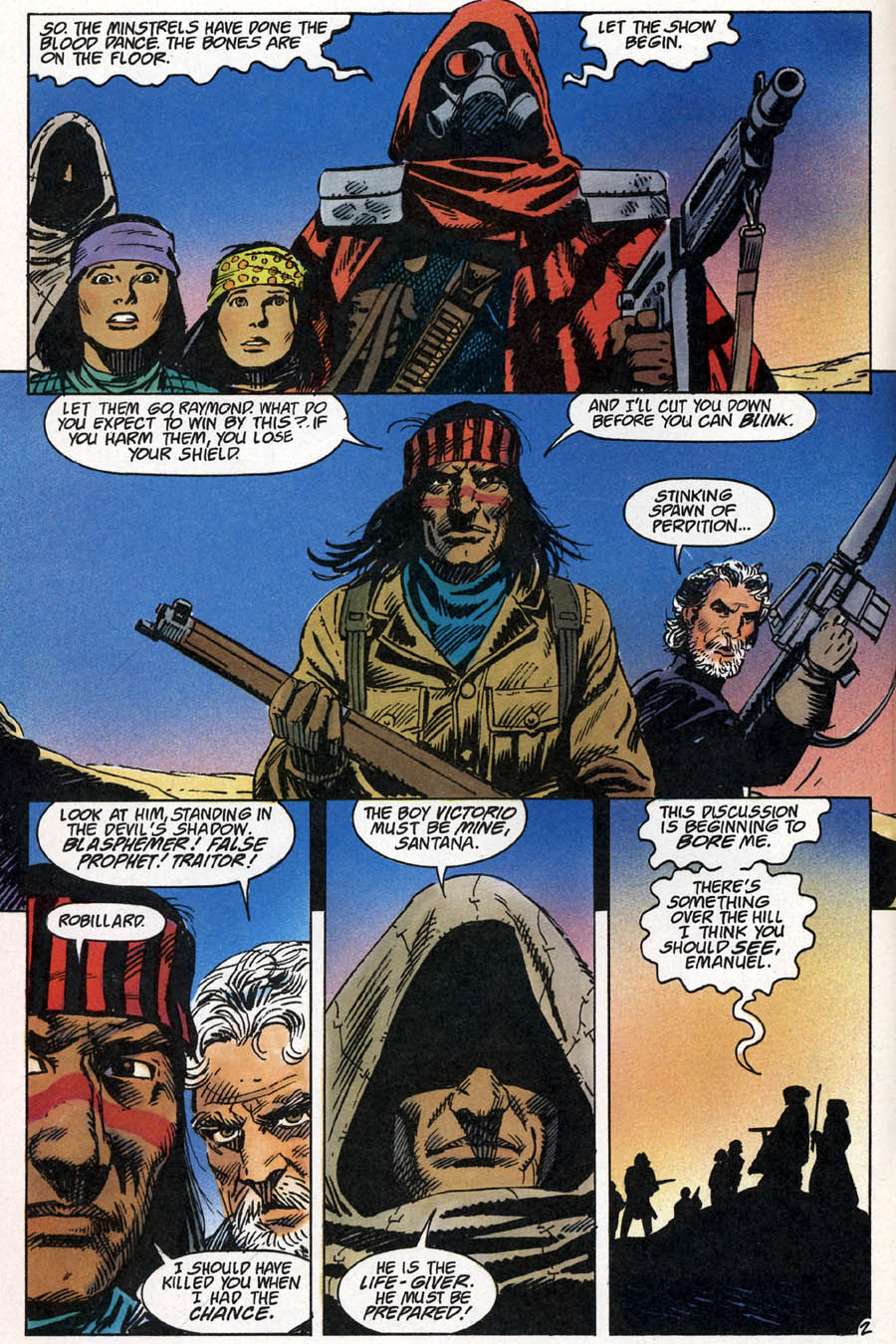 Redwire reveals that he has taken the Hopi village and shows the body of Walker hanging upside down, having given away the secrets of the cave system. They fought to protect Victor, but it wasn't enough. Scout throws down his weapons, as do Sand Dog Yuma and Rosa. He calls out Santana for a one-on-one fight and extends blades from his gauntlets. 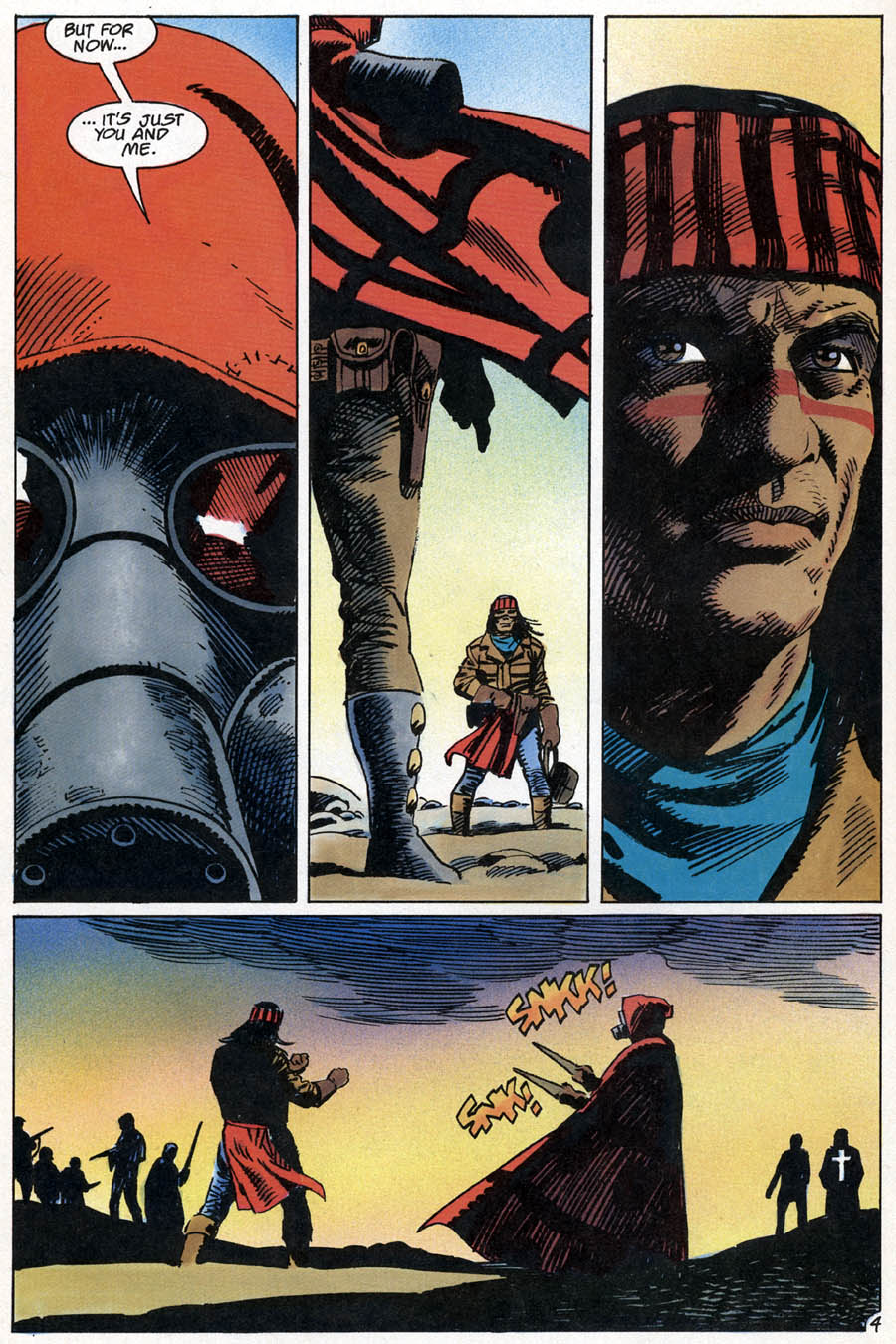 Redwire is all slashing movements and gets close, but Scout dodges and weaves and fights close in. He gets under the blades and decks Redwire with an uppercut, now calling him Vaughn and Ray. Vaughn was good, Scout was better; but Vaughn fights dirty and stabs Scout in the thigh when he backs off. Tahzey cheers on his father, but Walker, still alive, calls to Victor and tells him he knows what he must do. Ray taunts Santana, but he still has fight in him. However, as I said, Vaughn fights dirty and produces a pistol and says that he has no intention of letting Santana get back to his feet. He draws a bead on Santana's head and Victor calls out to him to get up. Scout surprises him by hitting him with a rock and gets a few more shots in. walker speaks to Victor telepathically and continues to tell him to focus on the gun.... 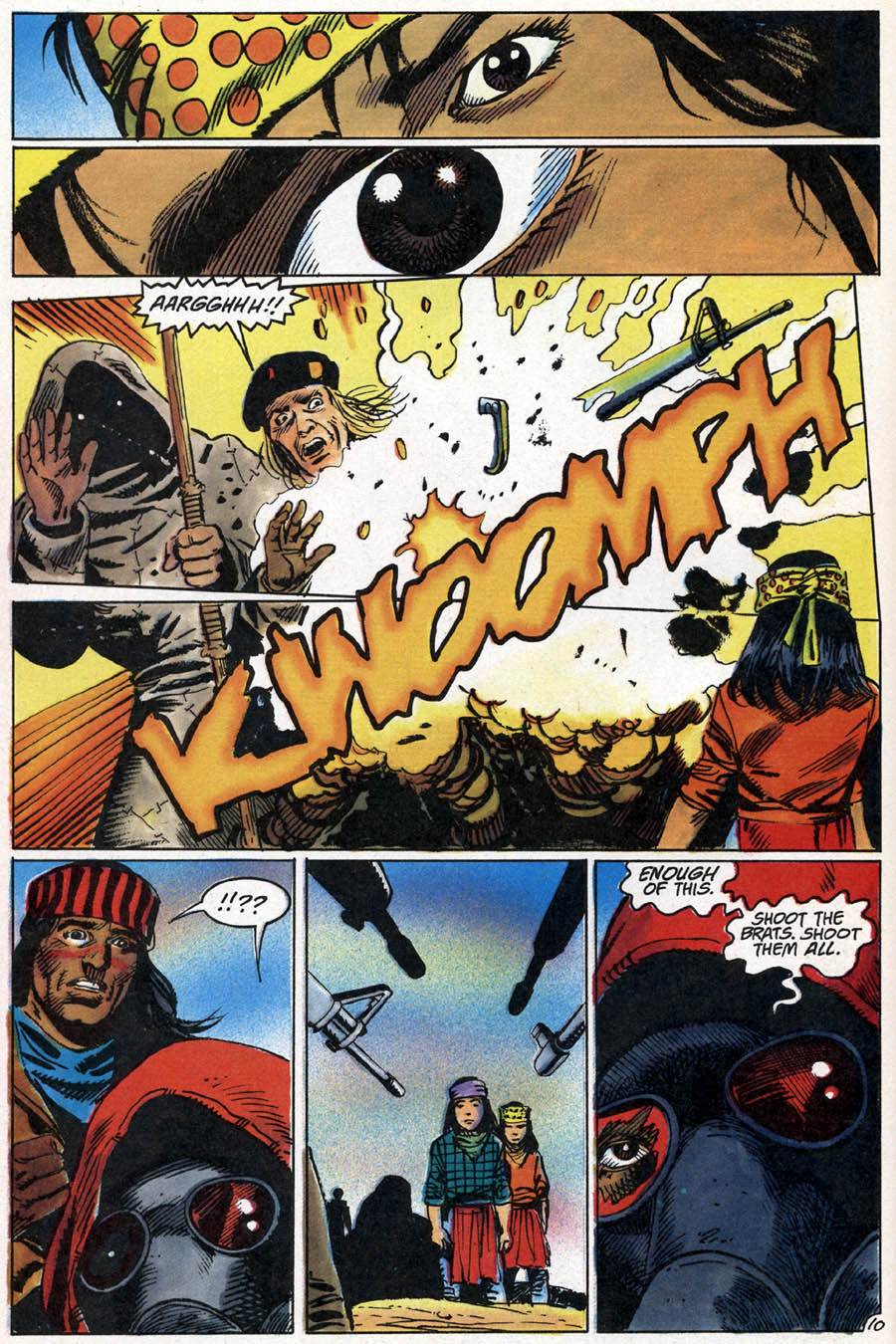 It explodes and the odds are evened, but Vaugh orders the boys to be killed. Scout isn't close enough, but Robillard leaps into the path to protect them and is gunned down. Scout yells for them to run and is struck from behind by Vaughn. Tahzey tells Victor to run, but he stands over Robillard and looks down at his bloody face. He turns to go, but Redwire is in the way, pistol ready. Victor asks Tahzey if their father is dead. tahzey tells his brother to get behind him. Yuma curses Redwire. Victor is agitated, believing that his father is dead and he does what he must... 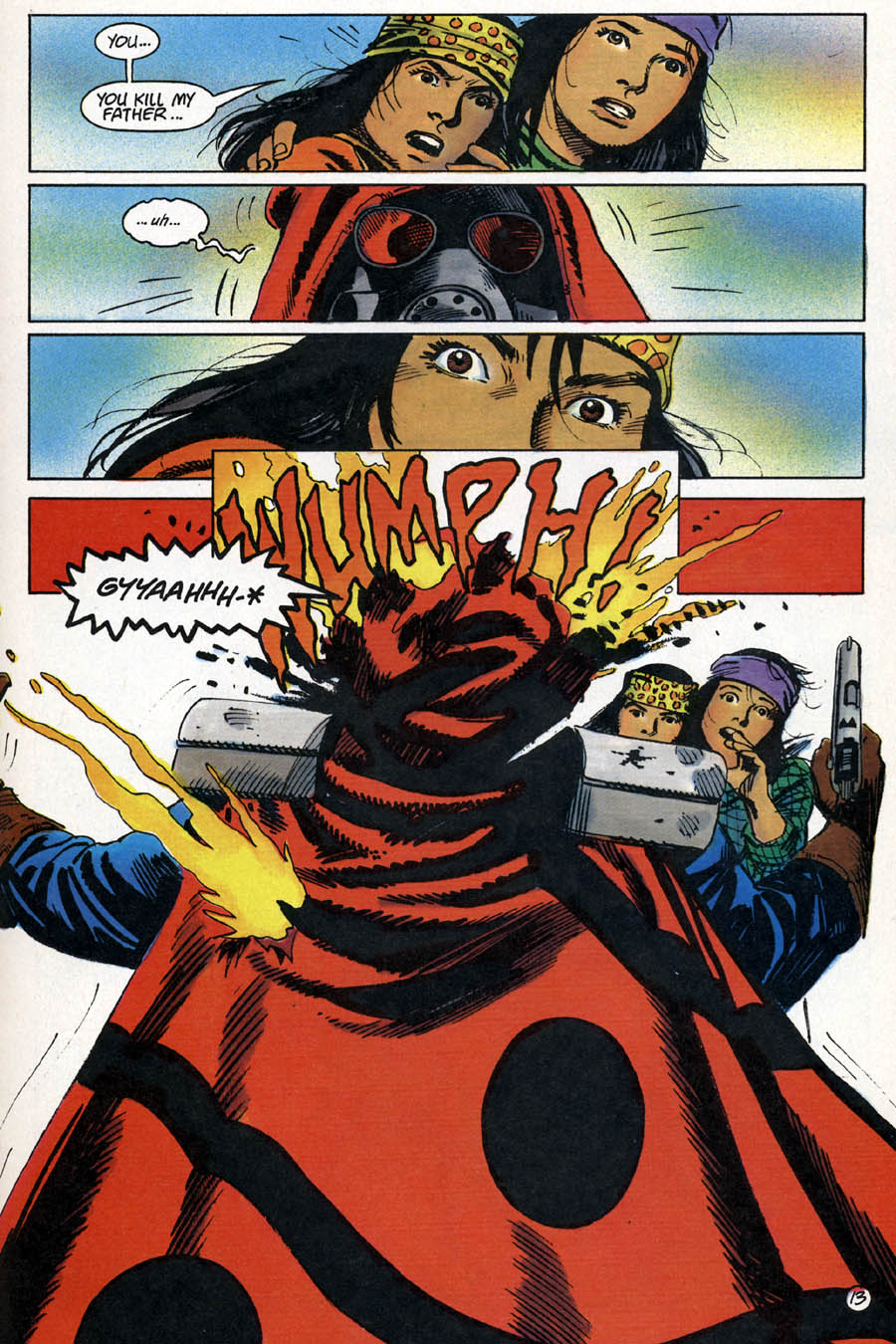 Ray Vaughn falls to the ground, truly dead, his head exploded. Tahzey is stunned by what his brother did. The boys see their father, alive and run to him. All is well. Then, Rosa speaks to Vaughn's troops and wins them to her side.... 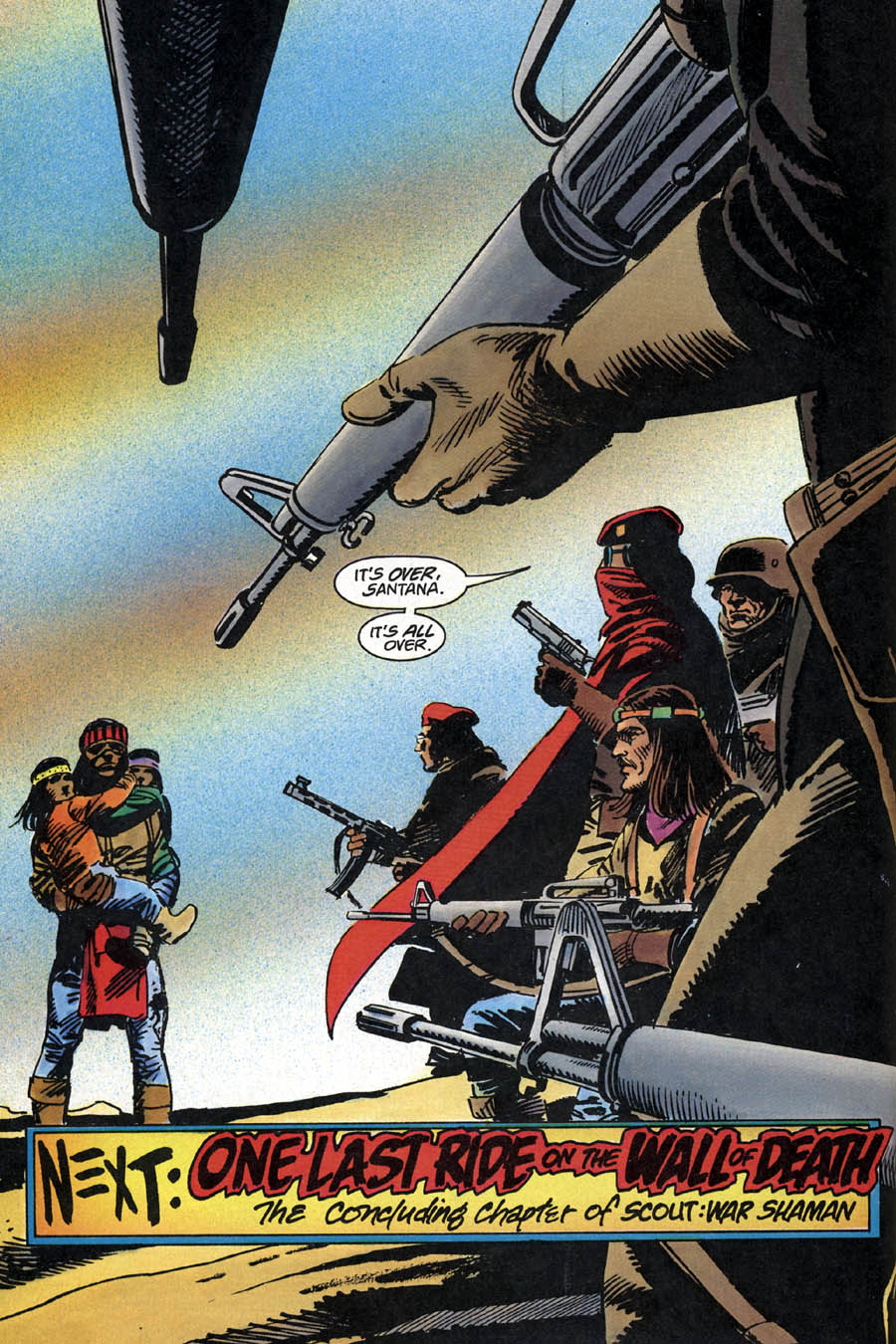 She tells Santana that the fight is over. Beau La Duke- Beau covers Rita so she can escape Atuma Yuma and his pirates, but a pair of them pull a Steve McQueen (in The Great Escape) and knock him off his motorcycle (luckily they have rope, at chest hight, and not wire, at neck height). Yuma is about to shoot him when Rita snaps her whip... 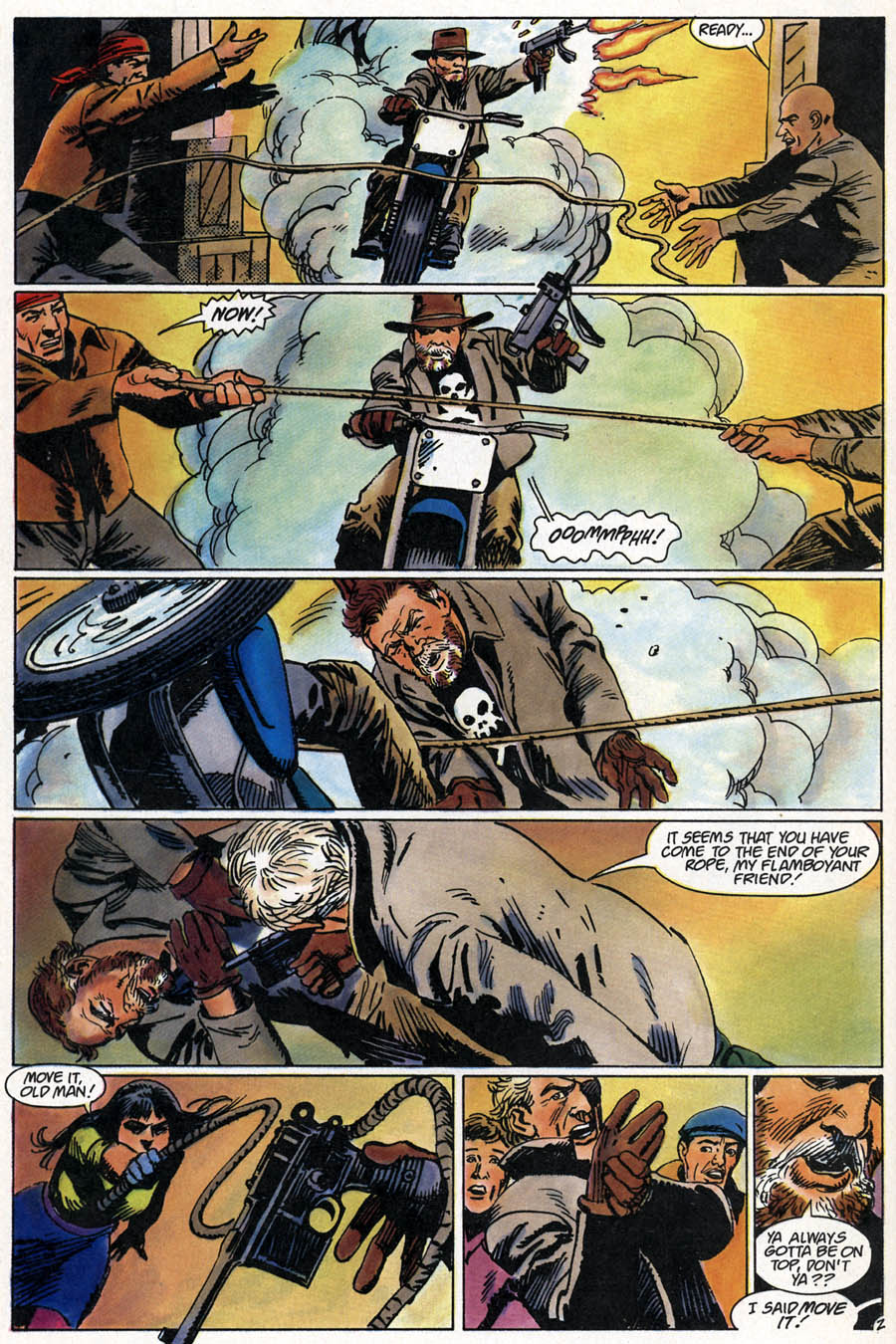 Yuma retreats to his ship, but Beau follows, with Rita covering him. She holds off the pirates, while beau chases their captain. he catches him in the wheelhouse and they battle, unitl Beau is distracted by a radio transmission from Redwire's group. Yuma decks Beau with a lantern and escapes. Rita is holding off the pirates, but one charges through, despite getting hi and has her by the throat, when something bursts through his chest. It's Beau, with a stake. He and Rita grab grenades and toss them at Yuma and dive off the boat. beau and Rita drag themselves onto shore and hear Yuma, still alive taunting them, as he goes off to raid the canyons for more plunder and rebuild. Rita loses her bounty and Beau hus munitions. they decide to grab a beer and some lovin', figuring that another day won't make a difference. Thoughts: Okay, wow.....the final showdown between old rivals, Ray Vaughn, aka Redwire, and Emanuel Santana, aka Scout. Scout is hobbled by his sons being held prisoner. Redwire has taken the Hopi village and killed the inhabitants or left them to die slowly. He has already died once and isn't as vulnerable to bullets or fists. Santana is human. Santana fights with determination, but, he isn't fighting a human and he still thinks of Vaughn as the human ranger he knew, not Redwire, the monster killing machine. Ray Vaughn had no honor, even when he was human and Scout continues to make the same mistake with him. He also makes the same mistake with Rosa. She is not the young soldier he loved, nor even the older soldier who he won over to his side. She has been through fire and hardened into the very thing she fought, from grief and betrayal and loss. She lost her humanity when she slaughtered the family of her adopted daughter, Laura. The more she sacrificed others for what she perceived as her own greater good, the more she pushed away her humanity, until her belief in her mission replaced any feelings of love and loyalty. The road to hell is paved with good intentions and Rosa is a citizen of hell; its leader, in this realm. She is part machine, but she became cold steel long before cold steel became the majority of her body. She understood what Santana did not, because she had made the hard choices and there was no turning back. She would go into the dark places that Scout wouldn't and she knew that and could see that in him and used it against him. Santana still clings to the idea that he can appeal to his old friends, never realizing that those days ended when he chose freedom over them. They resented his escape and the fact that he would conform. Rosa was angered that he left her and continued to leave her behind. She nearly killed his wife and children, when she saw what he had, when she stumbled across them, in the between years. he had what she couldn't give them and any love she had for him died then. She used him for her own ends, to get her daughter back (who is still missing) and defeat Redwire and reclaim her army. Rosa can't fix New America, because she never had a vision for it and is just picking away at the carcass, trying to find a death that does not come. One threat has ended, the final one remains. If this were DC or Marvel, we'd know Scout would find a way out. This isn't DC or Marvel and Tim Truman is doing something beyond their standard fare. next issues is the conclusion of Scout: War Shaman. It is the end of this volume and the beginning of the next. Unfortunately, the state of the industry is changing, as we will see, next time.
|
|
|
|
Post by codystarbuck on Jun 8, 2021 0:27:23 GMT -5
Scout: War Shaman #16 Cover kind of gives it away.... Creative Team: Tim Truman-story & pencils, Ricardo Villagran-inks, Tim Harkins-letters, Sam & Sal Parsons-colors, cat yronwode-editor. Listed as "An Apache Production, for Eclipse Comics" Not sure if that meant a new studio name, or what, as Wilderness carried the 4Winds logo, though Tecumseh did not. "The Living Years"-Beau Smith-writer, Todd Fox-pencils, Ricardo, Tim H and Sam do their thing, Tim T edits. Also from Eclipse: Due, at least in part, to Eclipse's financial problems, this issue came out 6 months after the previous one. So, this is what was published in the interim: JULYCyber 7 #5 Dirty Pair II #2 Fusion #16 Stormwatcher #3 AugustAppleseed Bk III, #1 Black Terror #1 Cyber 7 #6 Dirty Pair II #3 Reid Fleming #4 (published sporadically, based on creator producing material; 8 months since previous issue) Tales of the Beanworld #14 (published roughly quarterly, through 1991) SeptemberAppleseed Bk III #2 Cyber 7 #7 James Bond, Permission to Die #2 (5 months after the 1st issue, despite being in-house, final issue out 13 months later, despite being in-house) Stormwatcher #4 (last issue) Zot #28 (frequency varied, but, more or less bi-monthly, at this stage) OctoberAirboy #50 (6 months after previous issue, despite being in-house before #49) Appleseed Bk III #3 Appleseed: The Promethian Challenge TPB (Book I) Black Terror #2 (3rd and final issue came out 5 months later)) Cyber 7 Bk II #1 Dirty Pair II #4 Dominion #1 Fusion #17 (Last issue) NovemberAppleseed Bk III #4 Appleseed: The Promethian Challenge HC Cyber 7 Bk II #2 Dirty Pair II #5 Dominion #2 Tales of the Beanworld #15 DecemberAppleseed Bk III #5 Cyber 7 Bk II #3 Dominion #3 Scout: War Shaman #16 (last issue) Zot #29 So, only the manga reprints are hitting monthly schedules (on the whole), while Fusion gets shut down, as did Stormwatcher. James bond was in on time, per Mike Grell; but, Eclipse didn't have the cash to publish it, leading to Acme Press taking the license to Dark Horse. Tales of the Beanworld and Zot were critical darlings, with loyal readers, but neither Larry Marder nor Scott McCloud were what you would call "fast." Dominion was a new manga reprint, also from Masamune Shirow (Appleseed, Ghost in the Machine). The manga material was all coming from Toren Smith's Studio Proteus. Studio Proteus was the chief manga translation packager for all comics, at the time, working with Eclipse, Viz (continuing after Viz severed their relationship with Eclipse), Innovation and Dark Horse. Eclipse actually passed on Outlanders, which Studio Proteus then offered to Dark Horse and it became a big hit. After Eclipse was hit with a lawsuit by Studio Proteus, the group gained all translation rights to the material and took it to Dark Horse, for reprinting (some of it). Synopsis: Rosa and her men have their weapons aimed at a defenseless Scout, Tahzey, Victor and Sand Dog Yuma. 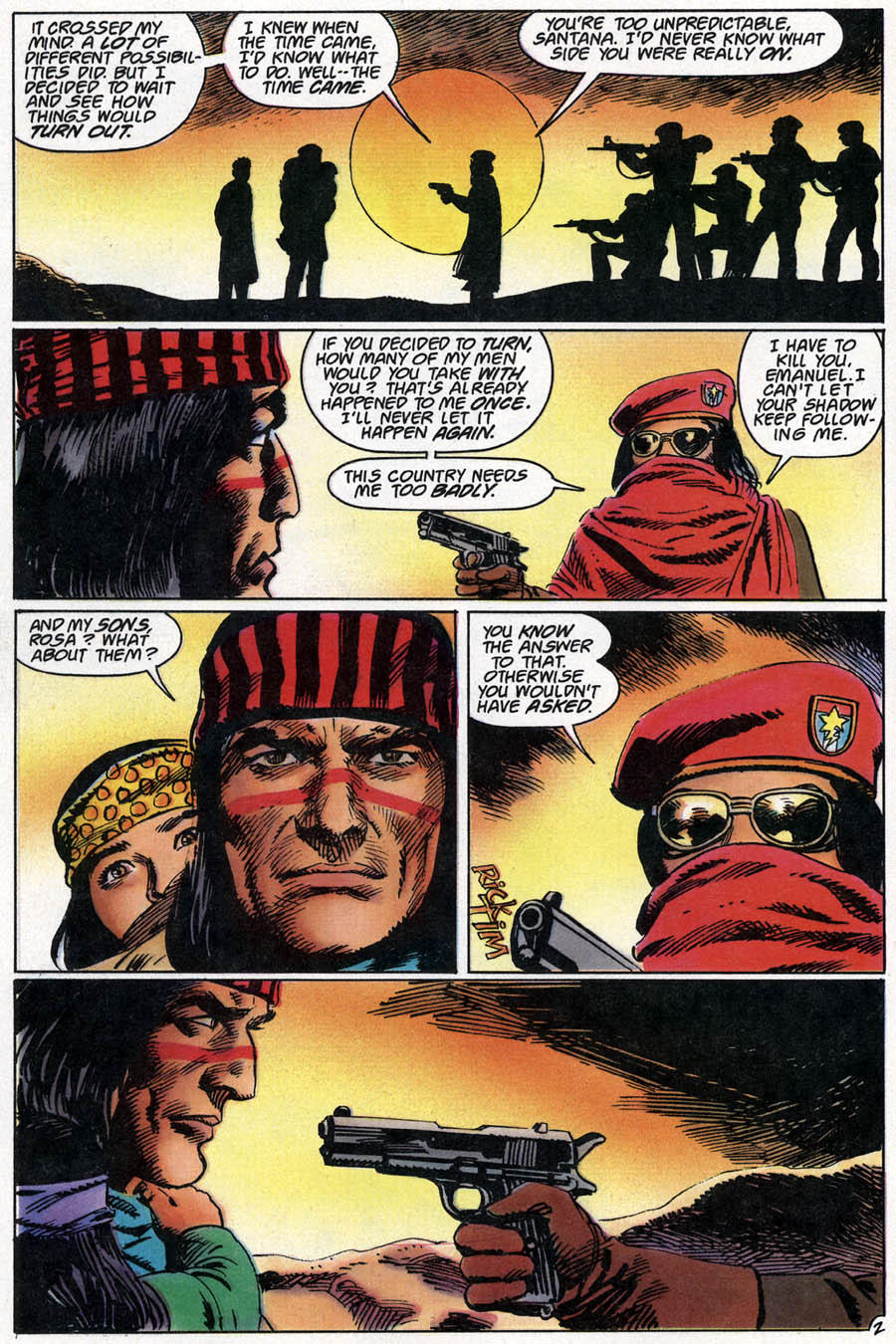 Atuma Yuma turns up and interrupts things and is attacked by his brother. Santana understands what Sand Dog is doing and tells Tahzey to get ready. he then pulls the pins on a pair of grenades and tells Tahzey and Victor to run. Rosa fires but misses. her men recover and she sends them after Santana. She tells the men to kill Sand Dog, but leave Atuma alive, as he is useful. Sand Dog and Atuma go rolling off a cliff. The men carefully edge forward and find only Atuma, with his throat cut and rifle gone. sand Dog is nowhere to be seen. Rosa then orders Walker to be shot and moves on. Scout, Victor and Tahzey are hold up in a crevice..... 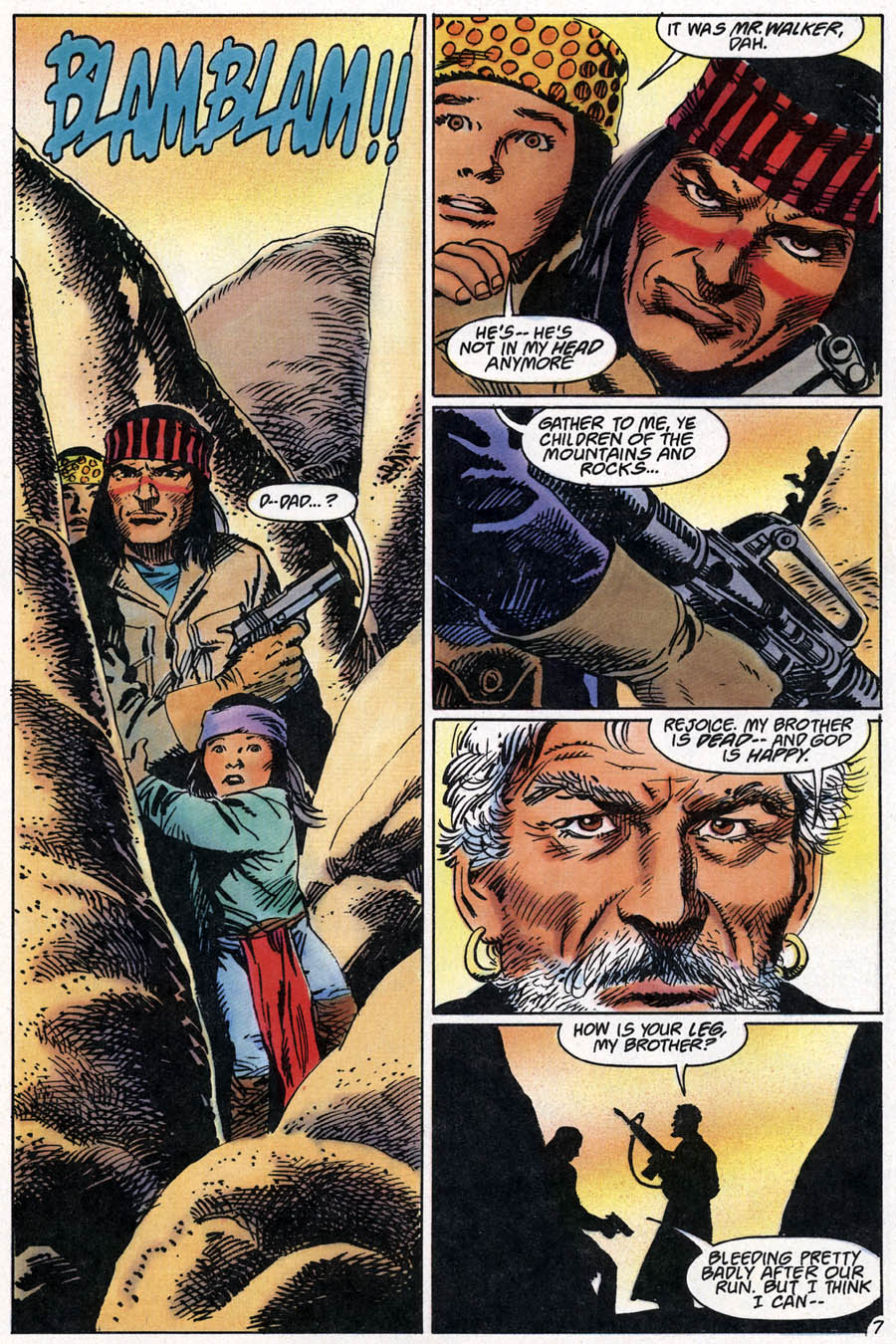 Victor's link to Walker is gone. sand Dog turns up, wounded but alive and says his brother is dead. Scout goes to treat his wounded leg, when Rosa's men open fire, pinning them down. Scout takes a round. He tells Sand Dog to give him the rifle and to take the boys through the arroyo, before Rosa can bring up a squad to block it. Tahzey starts to argue, but Scout stops him and says his goodbyes... 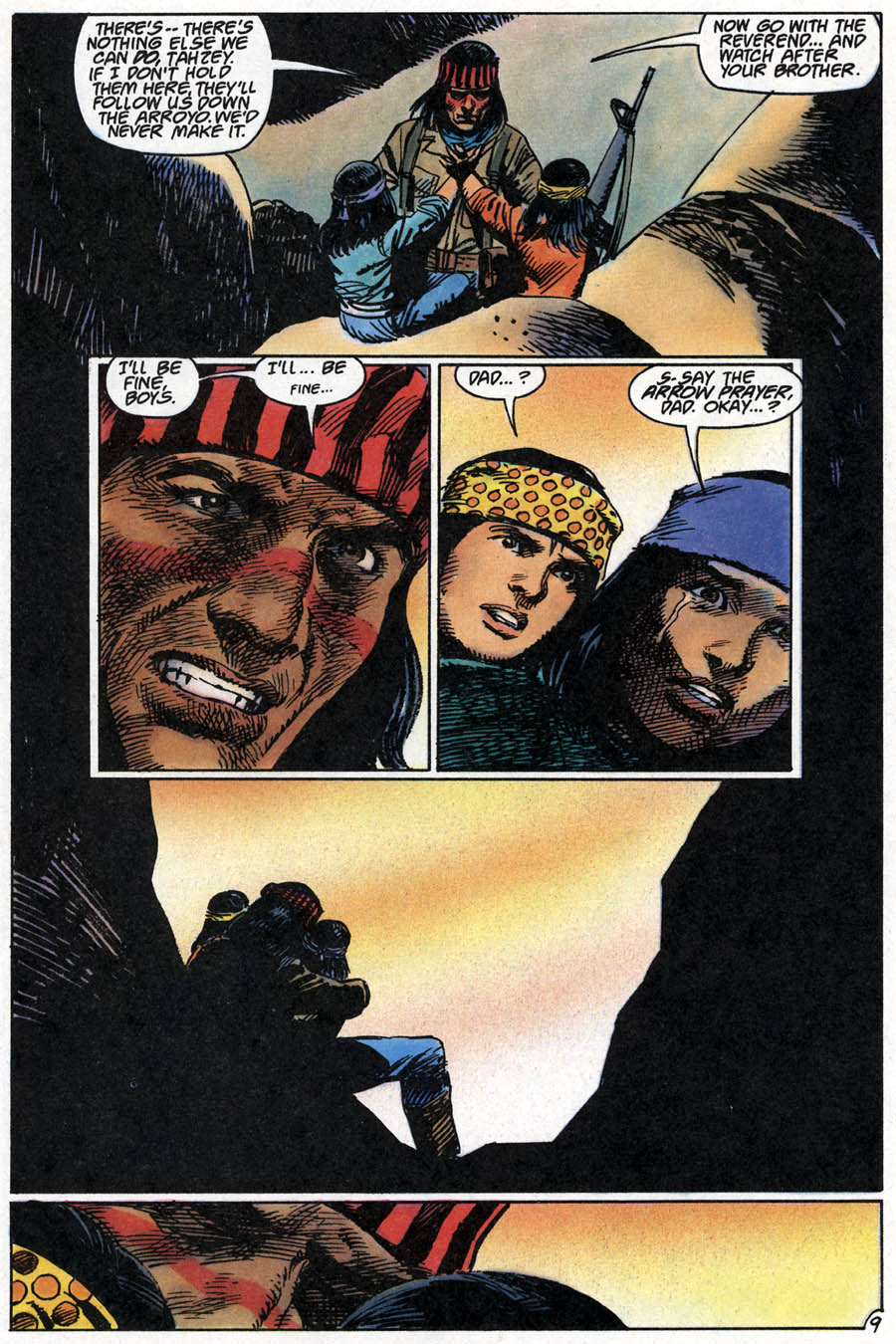 ...SNIFF.......Got somethin' in my eye......... Rosa begins her attack and Scout sends the boys with Sand Dog. Rosa tells him he is surrounded, but Scout opens things up and tells sand Dog to get moving. Explosives go off and rocks come raining down into the arroyo. Scout loses sight of Sand Dog and Tahzey and calls out to his son; Victor is still by him. Scout fires at every available target; but, it isn't enough. More pop up and fire. Scout shields Victor and is hit again and tells Victor they got him good that time... 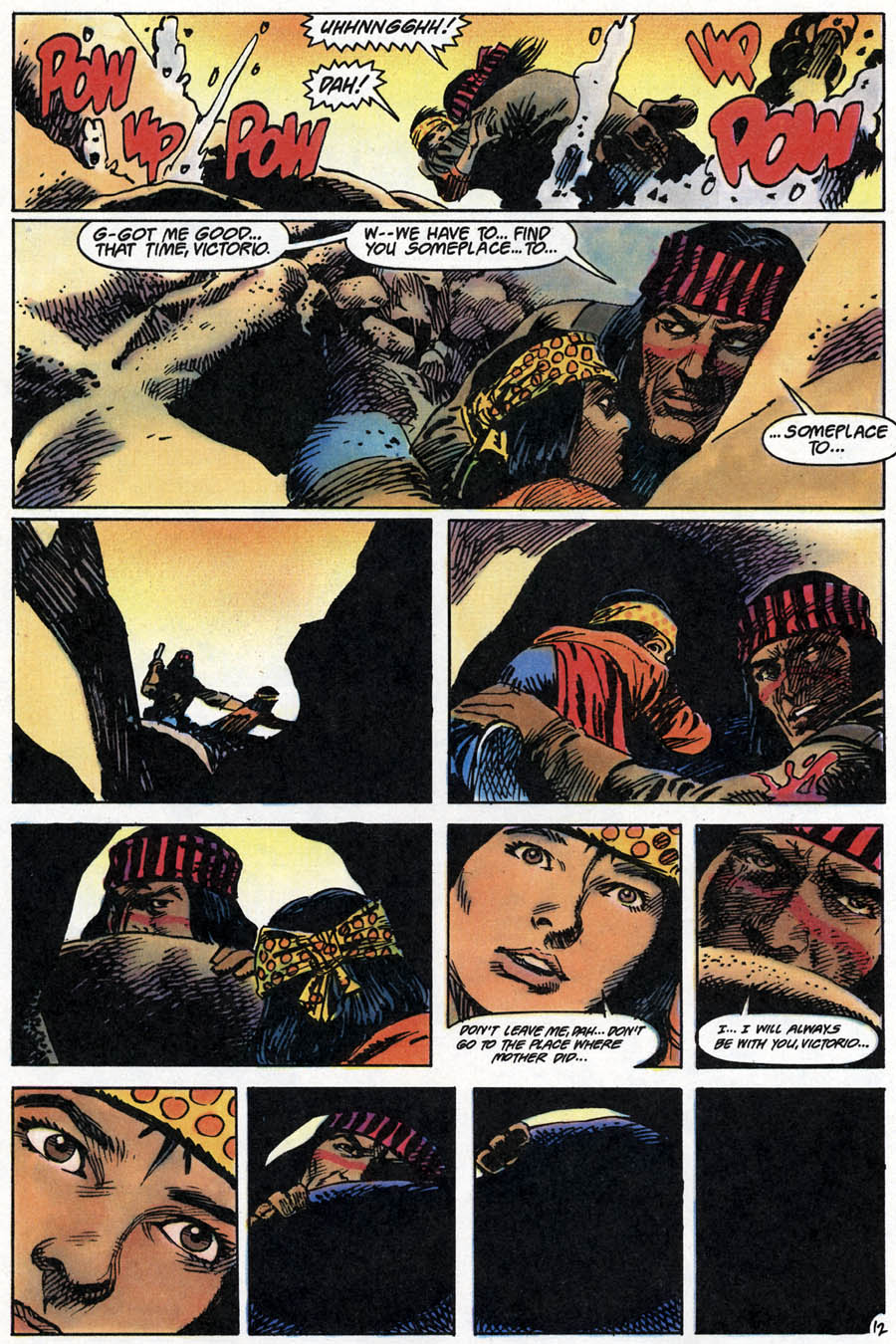 Scout finds Victor a hiding place and covers it, telling Victor he will always be with him. Scout waits and they come. he fires and keeps firing, until there is nothing left. There aren't enough bullets and Rosa's team get to him. Rosa sees the body of her one-time friend and lover. She goes down to check the body, as she has to be sure. Scout has one last surprise for her.... 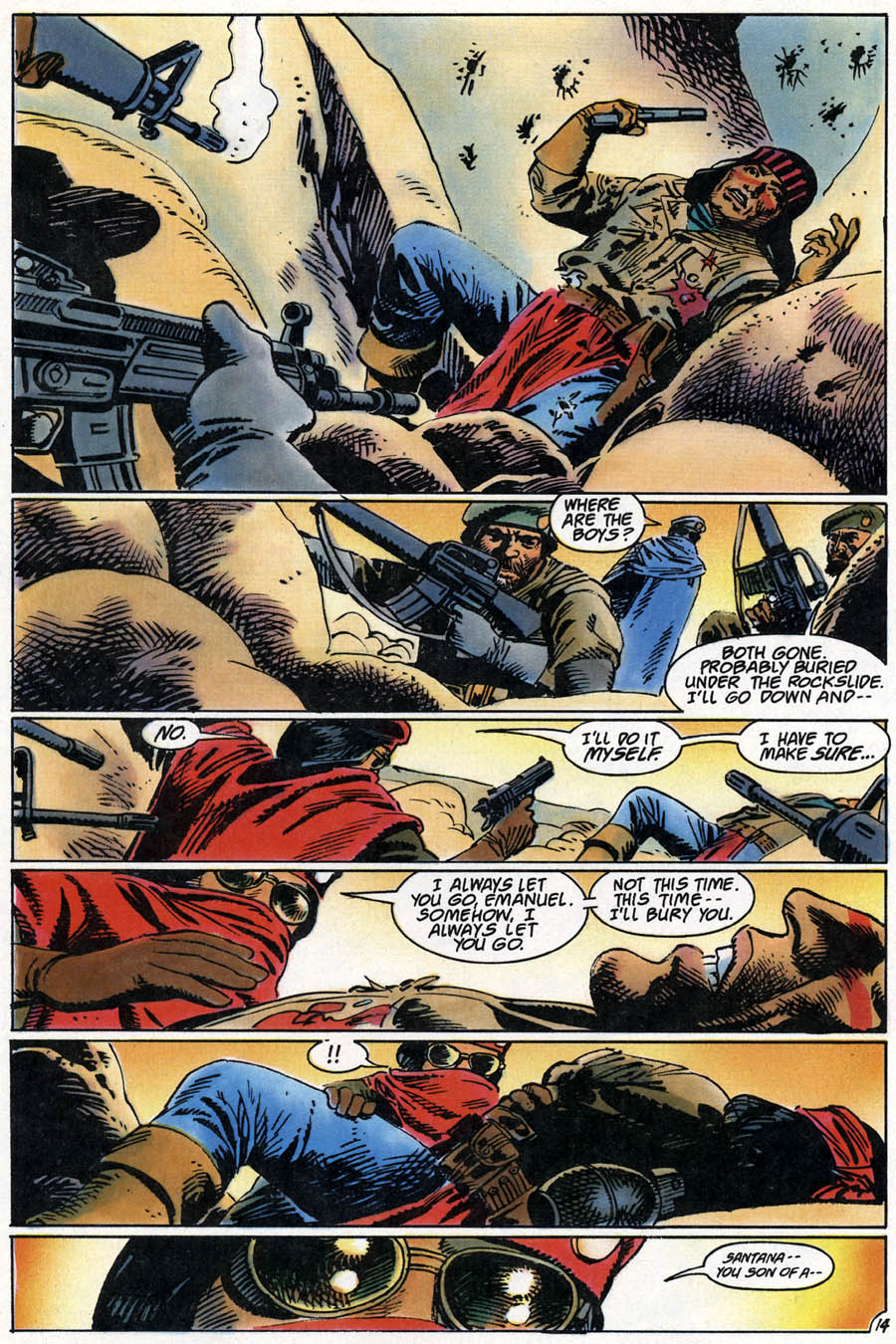 We then see Sand Dog, carrying an injured Tahzey out of the arroyo and into the desert. We hear the words from the future, as sand Dog relates the tale and says they never found Victor. We then see Victor climb out of his hiding place, where he finds Rosa's sunglasses and his father's headband. He dons the scarf and we see that another is watching over the next Scout.... 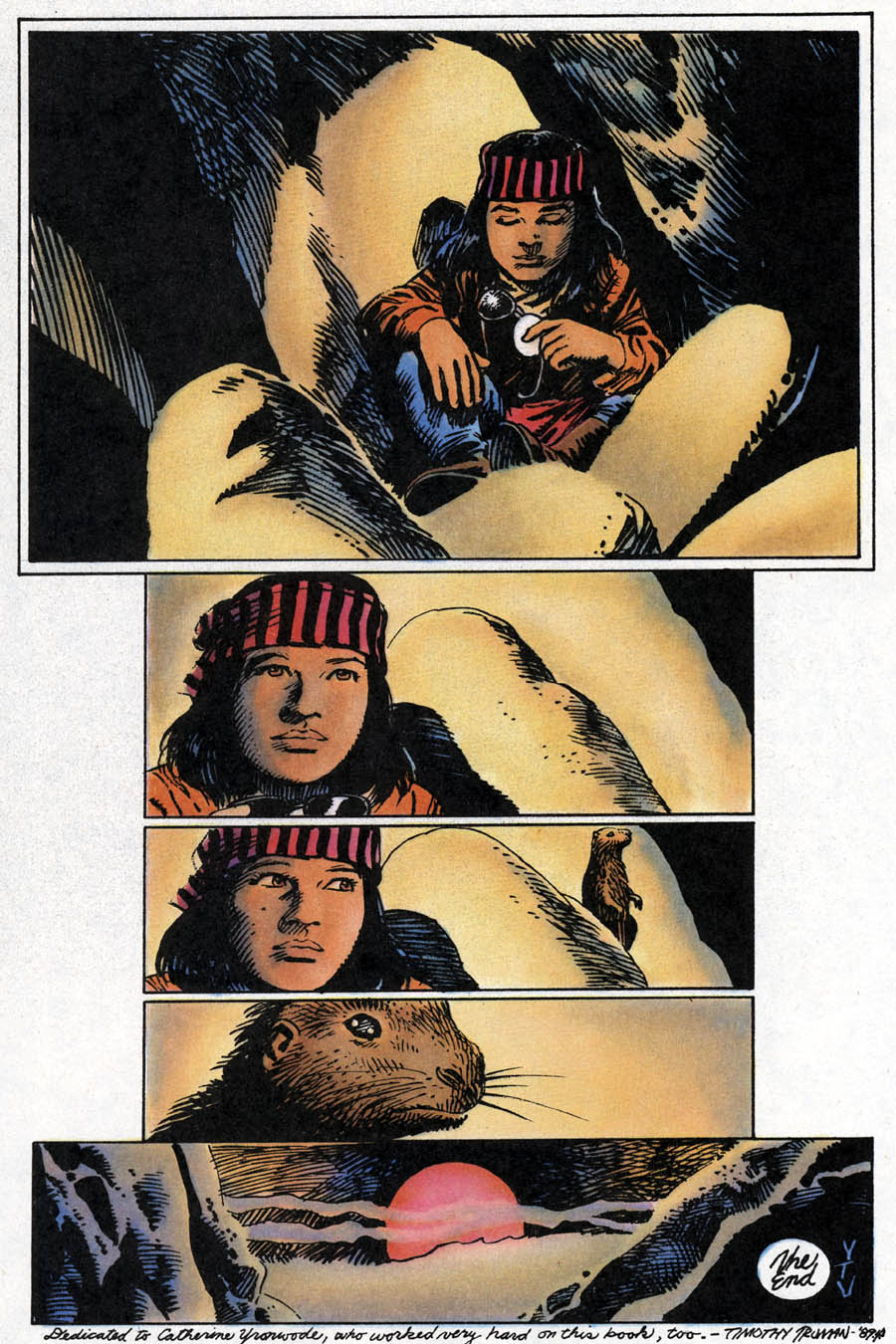 ...the gahn has returned. "The Living Years:" Beau La Duke has finally arrived, too late. He performs one last service for his friend, Emanuel Santana, known as Scout. he thinks back on their past, as beau would tell tall tales, then Scout revealed he knew beau was a Rhodes Scholar and had travelled the world. beau was enamored of John Wayne western and lamented the lack of real heroes. Using his family money, he decided to create one and learned and rtained. he developed the Beau La Duke persona, to help hide who he was inside. Scout saw through it. Beau makes a promise to find the boys and says goodbye... 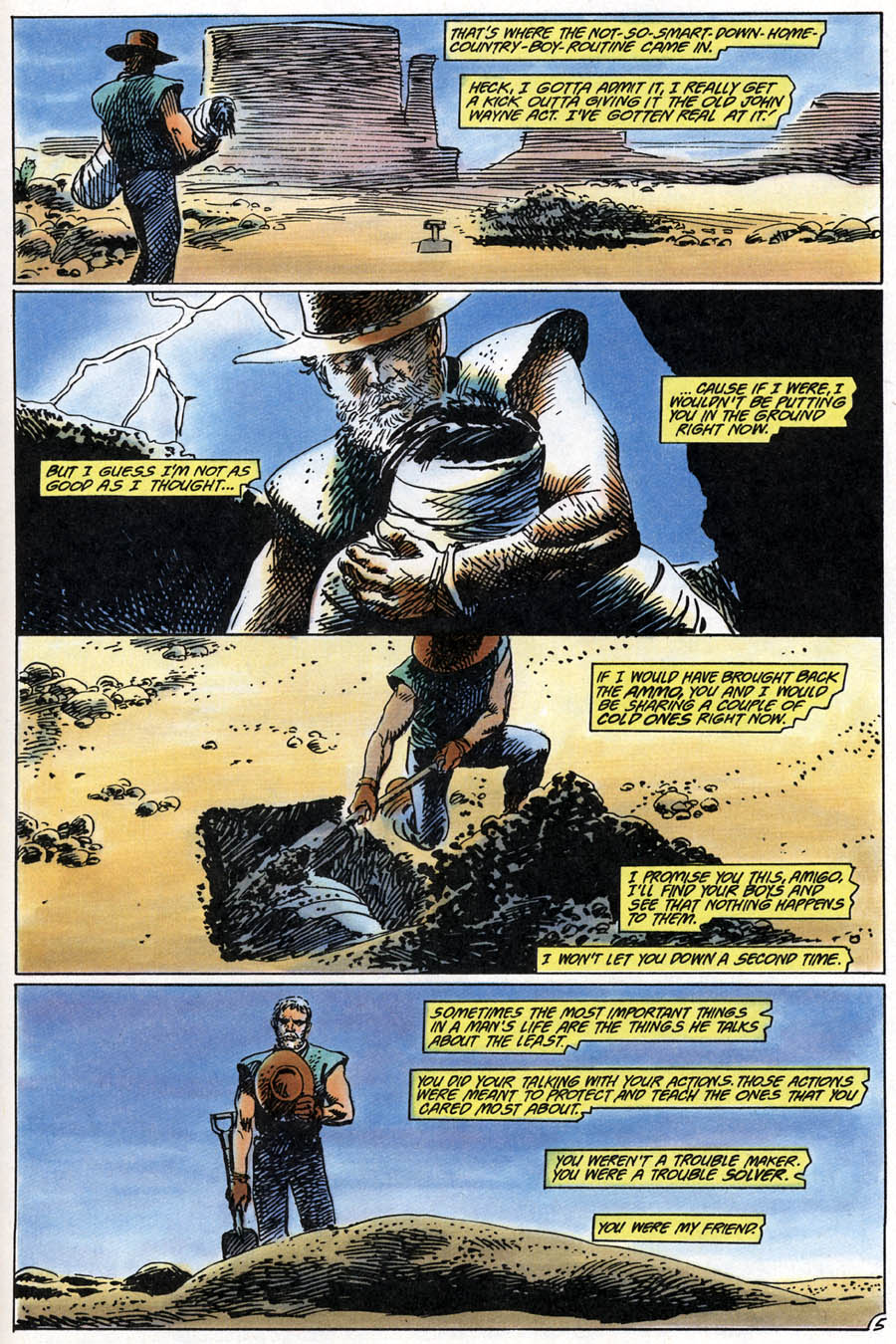 As he leaves, he sees another friend of Scout, watching.... 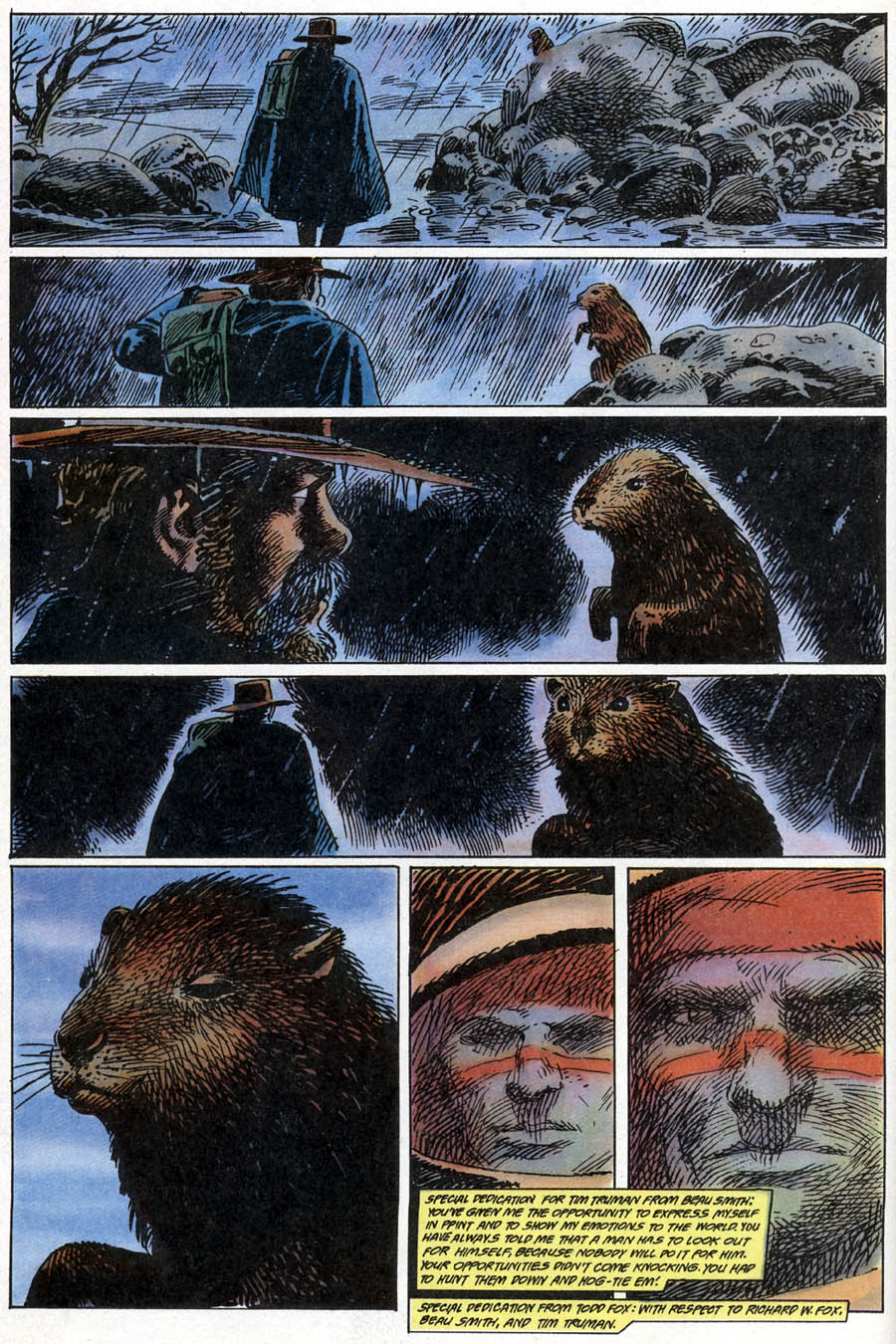 The book ends with a piece from cat, noting that this is the end and Tim is taking a break, to work on other projects. However, she notes two more volumes are planned..... 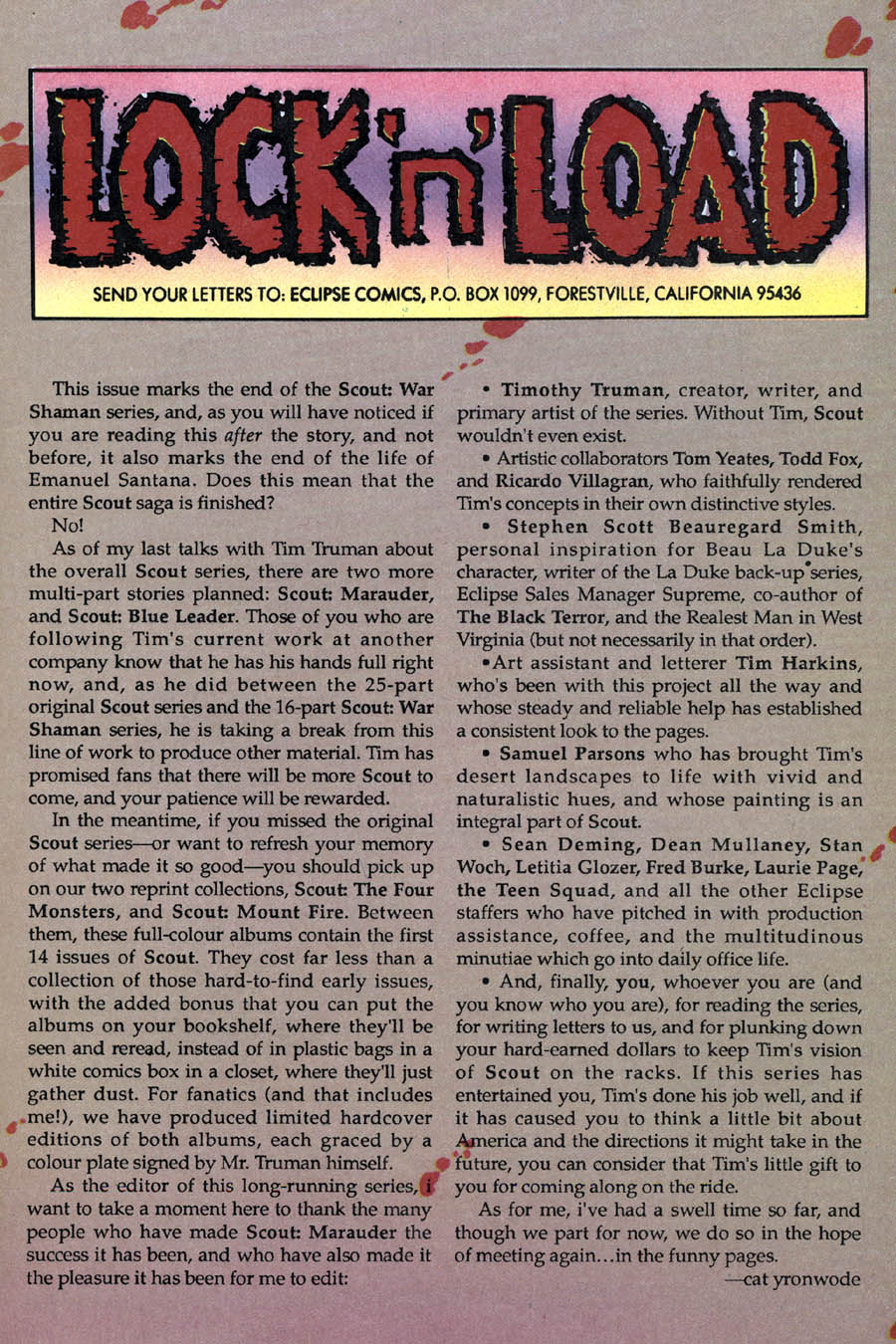 ....Scout: Marauder and Scout: Blue Leader. We still wait, but Scout: Marauder had a kickstart campaign that was successful, to finish it, and we await its release. Son Ben joins Tim on the work. Thoughts: And so Scout comes to the conclusion that we should have probably expected, but didn't want to contemplate. This was no supernatural or super-normal her; just a man, fighting against a far larger and more powerful enemy. it was always a matter of numbers, just as it was to the Chiricahua and other Apache groups, who fought the US government for their freedom, eventually losing. Tim was faithful to their culture and history and is faithful in the reality and power of his ending. Scout goes out fighting, always using the element of surprise to inflict heavy damage. In this case, he took out his enemy, Rosa. He knew she would want to be sure and he made his own body a boobytrap to reach her. Rosa ignored her training, falling prey to her impetuous nature, where Scout was involved. Standard procedure for checking a dead enemy is to probe the body and then roll it over on top of you to check for boobytraps, underneath. As a midshipman, I spent a week at Camp Pendleton and watched a demonstration of these techniques, by a squad of Marines. had Rosa done as she was trained, she would still be alive to be a threat to Tahzey and Victor. She knew Scout and betrayed him, because she knew he would never be blindly loyal to her plans. Scout knew that she would probably betray him for what she thought was a greater good and that too many innocents had been ground under her heel. Rosa wasn't saving America, she was putting it out of its misery. Scout did the same to her, ending her descent into a living, monstrous hell. Tahzey survives, with the Rev sand Dog Yuma. we know nothing of what he will do. we see Victor take up the mantle of his father and meet his father's guide, the gahn. We know from the framing devices that victor would become the new enemy of the government, but one with paranormal abilities. We have seen Victor take two lives, but restore one, as well, all with the power of his mind. Will he be destroyer or lifegiver? Was Doody really a prophet and not just a deluded, mentally challenged, tortured young man? Is Victor the hope for a future, after the darkness? the darkness is there and Scout's vision showed him the world was dying, from poisons and hate; but, his vision also showed that his people would survive and flourish again. Victor seems to be the center of that vision. Beau says tearful goodbyes to his friend, Santana, as he buries his body. We learn that beau is not what he seems, setting the stage for future adventures from Beau La Duke, suggesting he might be a major part of Scout: marauder. Beau is an homage to Beau Smith and the revelations reflect that Smith was more than a crazy John Wayne-loving fan and salesman. he was also a pretty good writer and creative talent, as will be seen in his then-upcoming collaboration with Chuck Dixon & Dan Brereton, on Black Terror, and his own From Parts Unknown. He would go on to work at DC, writing Guy Gardner, and for Todd McFarlane's company and was instrumental in Todd buying up Eclipse's publishing properties, though he did little with it, as he soon found that Miracleman was not up for grabs, his main reason for grabbing them. Beau also worked with IDW, creating Wynonna Earp and Frank Cobb and has worked in the gaming industry, contributed columns and books relating to comics and marketing, and watched a lot of John Wayne movies. Tim Truman became a pretty hot commodity around this time. he produced book covers for the Wild cards series, edited by George RR martin, featuring a world of super powered individuals and deformed freaks, the end result of an alien genetic weapon. Truman produced covers for the original Bantam run (I want to say he started with Book 6, Dead Man's hand, and then provided covers for reprintings of the earlier volumes, as he wasn't the original cover artist). he did a bunch of work at DC, including Hawkworld and the subsequent regular series, the Jonah Hex collaborations with Joe Lansdale (and the lawsuit brought by the Winter Brothers), The Kents (with John Ostrander), Creature Commandos, and the thoroughly awesome Guns of the Dragon (with Bat Lash, Enemy Ace, Biff Bradley, Chop-Chop, Vandal Savage and Miss Fear). He provided covers and stories for Grateful dead Comix, adapting the songs of the band into visual form. He contributed to the ray Bradbury Chronicles, wrote Star wars, as Dark Horse, handled the Lone Roanger, at Topps, Turok, at Valiant, and Conan, also at Dark Horse. That brings an end to the 4Winds comics at Eclipse; but, we still have the graphic albums to discuss and will begin with Tim's next project there, Wilderness, a two-volume series about the notorious Simon Girty.
|
|
|
|
Post by chaykinstevens on Jun 8, 2021 15:57:15 GMT -5
Creative Team: Tim Truman-story & pencils, Ricardo Villagran-inks, Tim Harkins-letters, Sam & Sal Parsons-colors, cat yronwode-editor. Listed as "An Apache Production, for Eclipse Comics" Not sure if that meant a new studio name, or what, as Wilderness carried the 4Winds logo, though Tecumseh did not. "The Living Years"-Beau Smith-writer, Todd Fox-pencils, Ricardo, Tim H and Sam do their thing, Tim T edits. According to the credits, Truman and Fox were doing layouts, not full pencils. Villagran was credited as ink artist for the first story and finisher for the backup. Dominion was a new manga reprint, also from Masamune Shirow (Appleseed, Ghost in the Machine). I think you mean Ghost in the Shell. |
|
|
|
Post by codystarbuck on Jun 8, 2021 19:31:12 GMT -5
Creative Team: Tim Truman-story & pencils, Ricardo Villagran-inks, Tim Harkins-letters, Sam & Sal Parsons-colors, cat yronwode-editor. Listed as "An Apache Production, for Eclipse Comics" Not sure if that meant a new studio name, or what, as Wilderness carried the 4Winds logo, though Tecumseh did not. "The Living Years"-Beau Smith-writer, Todd Fox-pencils, Ricardo, Tim H and Sam do their thing, Tim T edits. . Dominion was a new manga reprint, also from Masamune Shirow (Appleseed, Ghost in the Machine). I think you mean Ghost in the Shell. Take it up with my editor; but, give him treats first or he gets cranky and starts yowling at you!  He sleeps 16 hours a day and doesn't pay attention. I write many of these things after a long day dealing with demanding people, a lack of resources and cowardly and illogical corporate masters. That's why he's the editor; he's better rested!  And, yeah, I meant Ghost in the Shell. I'm a huge fan of The Police album and Machine keeps popping in my head when I mean the anime. |
|
|
|
Post by codystarbuck on Jun 8, 2021 19:38:11 GMT -5
ps His typing is crap! He thinks "jk;nsdjklnsdfjhbzsdfjhb dfj" is a word.
He also walks across my head, hollers in my ear, and pokes me in the chest. He's a lot like Mort Weisinger!
|
|
|
|
Post by codystarbuck on Jun 16, 2021 17:49:29 GMT -5
Wilderness, Bk 1 & 2  Creative Team: Creative Team: Tim Truman-story & art, Tim Harkins-letters So, this is going to be a bit different, since this is a biographical work, rather than a comic story. Wilderness tells the story of Simon Girty, a figure on the frontier of the Ohio River Valley, across a span of time the encompasses The French & Indian War, The American Revolution, Pontiac's Rebellion and Lord Dunmore's War. The latter two are the names that whites gave to battles between the native tribes and white settlers. Very little of this material gets taught in schools, as the American Revolution tends to focus on the events that led to the declaration of Independent, the key battles and the Surrender at Yorktown, with little else mentioned. The frontier tends to be glossed through rather quickly, even in my day, when we did out homework by candlelight, carving our essays on stone tablets, and carrying them the 20 miles, uphill, through 30 feet of snow, fighting grizzlies and marauding bandits all along the path. The French & Indian War often gets compressed into George Washington getting into a mess and the British taking Quebec. The frontier fighting gets dumped into talk of Manifest Destiny (in my day) or omitted due to political considerations. Regardless, even the best American History classes can only cover so much ground and the initial frontier expansion tends to get lost in the establishment of the Constitution and the new Federal Government and the War of 1812. Then, we tend to talk about westward expansion in broader terms. even on a local level, the area history tends to be left for field trips or private exploration and study (assuming you can be bothered to turn off your damn cell phones and video games......pull up your pants....get off my lawn....darned ungrateful little hippies!) So, much of where we get this kind of history is through entertainment and mostly Hollywood. That is where much of the trouble lies, as Hollywood has a pretty piss-poor record on historical accuracy, especially when it comes to early American History and tends to play up the same patriotic legends that get substituted for nuanced study. Tim Truman set out to deliberately contrast these depictions in this work. Simon Grity, when he has been portrayed at all, has been shown as a murderous traitor and villain, who turned on whites and betrayed the Patriot cause. Even benedict Arnold tends to get cut more of a break. Truman sets out to portray the man as legitimate contemporary sources indicated, while filling in the less known period, Girty's youth among the Seneca, by using the historical accounts of other whites who came of age within native tribes, after being taken prisoner, on raids. 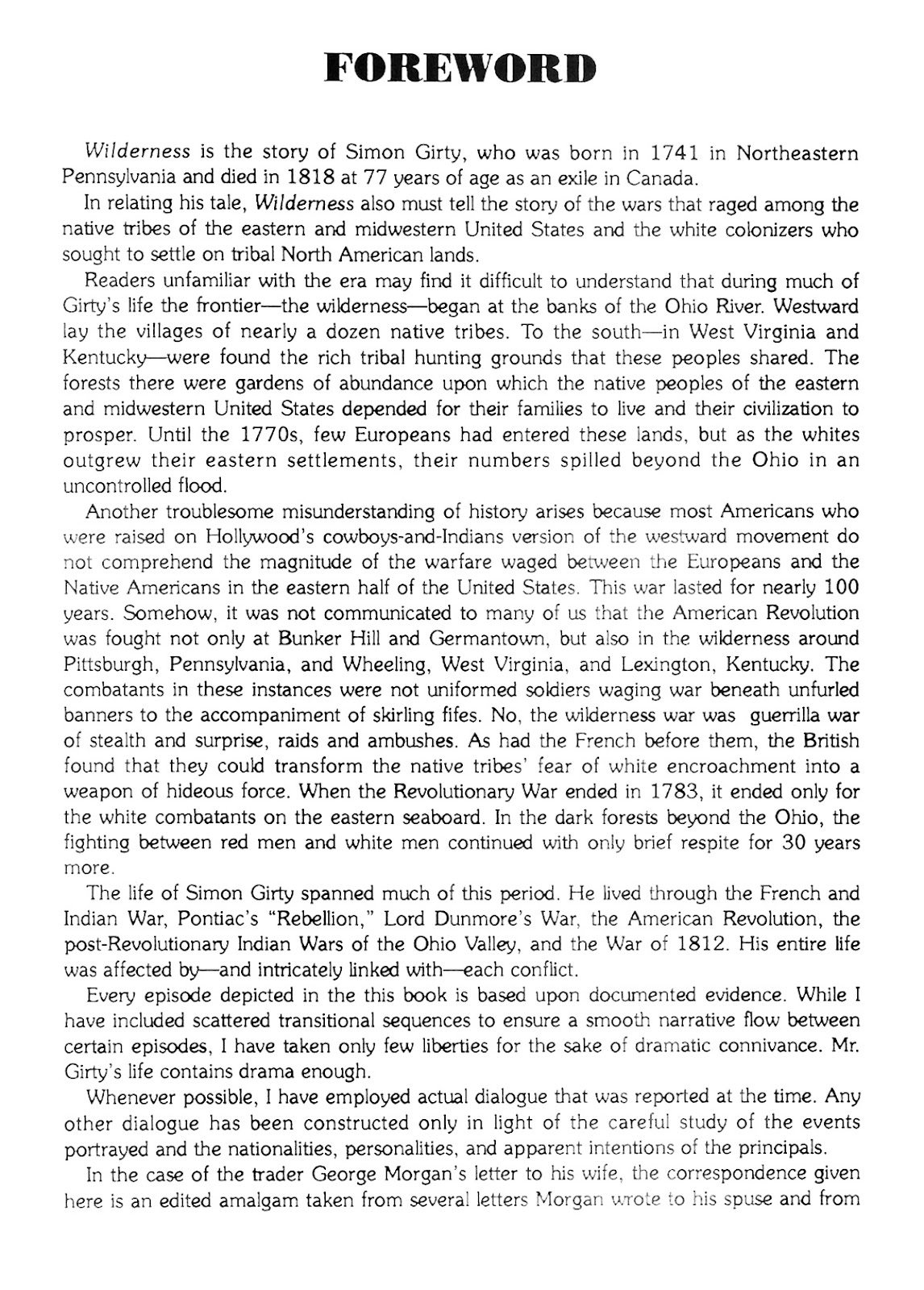 You can read Somin Girty's Wikipedia entry here, You can read Somin Girty's Wikipedia entry here, though it's just the basics and we all know about the reliability of Wikipedia. We will start this by summarizing the life of Simon Girty, then look at how Tim portrays the man and the events of his life. Simon Girty was born in 1741, near Harrisburg, PA, to Simon Girty Sr and Mary Newton. His father came over from Ireland, in 1730. The parents had 4 children: Simon Jr, Thomas, James and George, with Simon Jr being the second born. The family established a trading post and lived on land near the Susquehana River, but before British authorities had allowed settlement there. The Girtys and others were forced off the land, their homes were burnt down and they were fined 500 pounds by the government. Simon Sr was killed in a duel and Mary later married Simon's half-brother, John Turner. During the French & Indian War, the land they lived on became endangered by frontier skirmishes and the family relocated to Fort Granville, where John Turner joined the local militia. While the bulk of the militia was out on patrol, a force of 55 French and 100 Lenape native warriors attacked the fort and set fire to the stockade, which opened a hole, allowing the enemy to kill several men. The French commander offered quarter, if they surrendered. John Turner, as ranking officer, opened the gates. The French & Lenape plundered the fort and took survivors as prisoners. John Turner was tortured and killed, in front of his family. The family was split up, with Mary and baby John Jr, as well as James Girty were given to a Shawnee party, 10 year-old George Girty was taken by the Lenape and 15 year-old Simon was given to the Seneca (the Mingoes, of the Ohio Seneca). He lived with them in Northwestern PA, on the eastern shores of Lake Erie. Thomas Girty escaped from the Lenape. Simon earned the respect of the Mingoes when he ran a gauntlet and proved his bravery. He was initiated into the tribe and was mentored by Guyasuta, the chief of the Mingoes and lived with him for 7 years. During this period, the Mingoes were allies of the French and fought against British forces and native allies at the Battle of Fort Duquesne. The war officially ended in 1763, but battles between native tribes and the British continued, in what was known as Pontiac's Rebellion. The Mingoes were allied with Pontiac and fought with him at key battles, in 1763. There is no firm record of whether Simon Girty took part in the fighting. The fighting was particularly brutal, with the British using native allies in the fighting, plus the general arrogance of Gen Jeffrey Amherst. After initial gains by Pontiac's confederation, the British sent out expeditions to retake the land. Gen Bradstreet felt he didn't have enough men to subdue the tribes and negotiated a peace with the Seneca. As a byproduct, all captured prisoners were to be returned and Simon Girty returned to white settlements in 1764. Girty had fully assimilated into the Mingo tribe and their ways and felt out of place among the whites, in Ft Pitt. He proved useful, though, as he was a skilled frontiersman and spoke 11 languages and was used as a scout and translator. During the fighting known as Lord Dunsmore's War, Girty fought with the British militias and regulars, alongside such frontier fighters as George Rogers Clark, Daniel Boone and Daniel Morgan. These men also took part on the American Revolution, siding against the British. By 1778, the Frontier was becoming embroiled and the native tribes began to see the colonies as a growing threat and began uniting against them, with British loyalist sympathizers agitating things further. Simon Girty joined others in defecting from the Patriots, joining the native tribes and their British allies. As such, Girty was considered a traitor. His brothers James and George joined him and they were involved in an ambush against Patriots in northern Kentucky and against Daniel Boone at the battle of Blue Licks. However, Girty is noted to have intervened in the treatment of white prisoners and bought many of them their freedom. Girty also fought alongside the Wyandot in the Northwest rebellion of 1785-1795, including the American defeat at the Battle of the Wabash River, aka St Clair's Defeat. After the end of the fighting, Girty joined other native tribes and Loyalists in moving into Canada and settled in Ontario, where they had been deeded land, by the crown. Girty retired to a farm, near Ft Malden (modern Amhertsburg, Ontario), where arthritis and increasing blindness took their toll on him. His son George was killed during the War of 1812 and Girty died in 1818. Book 1, "The Borderlands", tells the story of Simon's captivity with the Mingoes and through the American Revolution. Truman begins in 1783, along a mountain ridge, near Pittsburg. A white prisoner is marched along by native, who whistle a signal and out steps a surprise for the prisoner.... 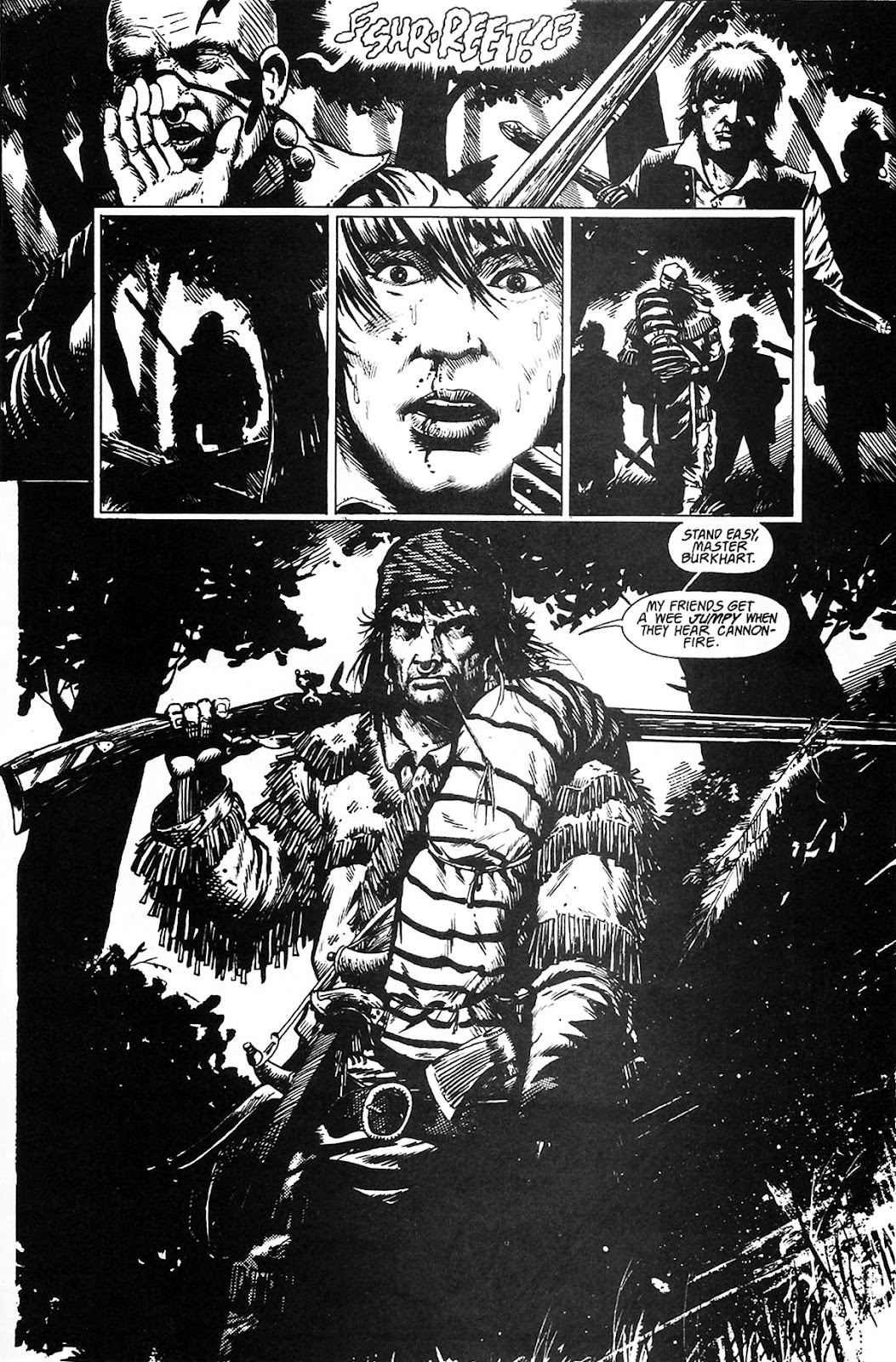 ...a white man, who tells him to take it easy, that the warriors get jumpy when they hear cannon fire. The prisoner tells him the cannon are in celebration of end of the war. Girty tells his allies that the man lies, though he knows that it changes the climate. He then reflects back on his earlier life and we turn to 1750, at Sherman's Creek, where the elder Simon is driven off his land and his home is burnt down by agents of the Sherriff of Lancaster, for squatting. Simon the Elder is portrayed as a violent drunkard, though he cries out that everything they had was in the house, which was set ablaze. They return to the settlement at Chamber's Mill and Girty sells everything he has to pay the fine. he re-establishes himself as a trader and takes on a partner, John Turner, trading things like muskets, ball and powder, skinning knives, tomahawks and whiskey for animal pelts, which were then sold to furriers and other clothing manufacturers. The native tribes of the area became more and more dependent on the trade, as white settlements grow and encroach their hunting grounds. Simon and his sons were often gone for long trips, collecting furs and trading goods, while John turner watched things at the other end. Truman implies that Turner and Mary began an affair during the trips. Simon Sr is a successful trader, offering diluted whiskey to his customers to get them in a proper frame of mind for bargaining. However, he builds a reputation as a fair trader and is well liked by the natives. With whites it is another story and a duel or fight emerges after insults to an Englishman (possible and officer) and Girty is killed. John Turner marries Mary and they have a son and soon move to the area around sherman's Creek, where Simon Sr had squatted. Truman gives a quick summary of the beginning of the French & Indian War.... 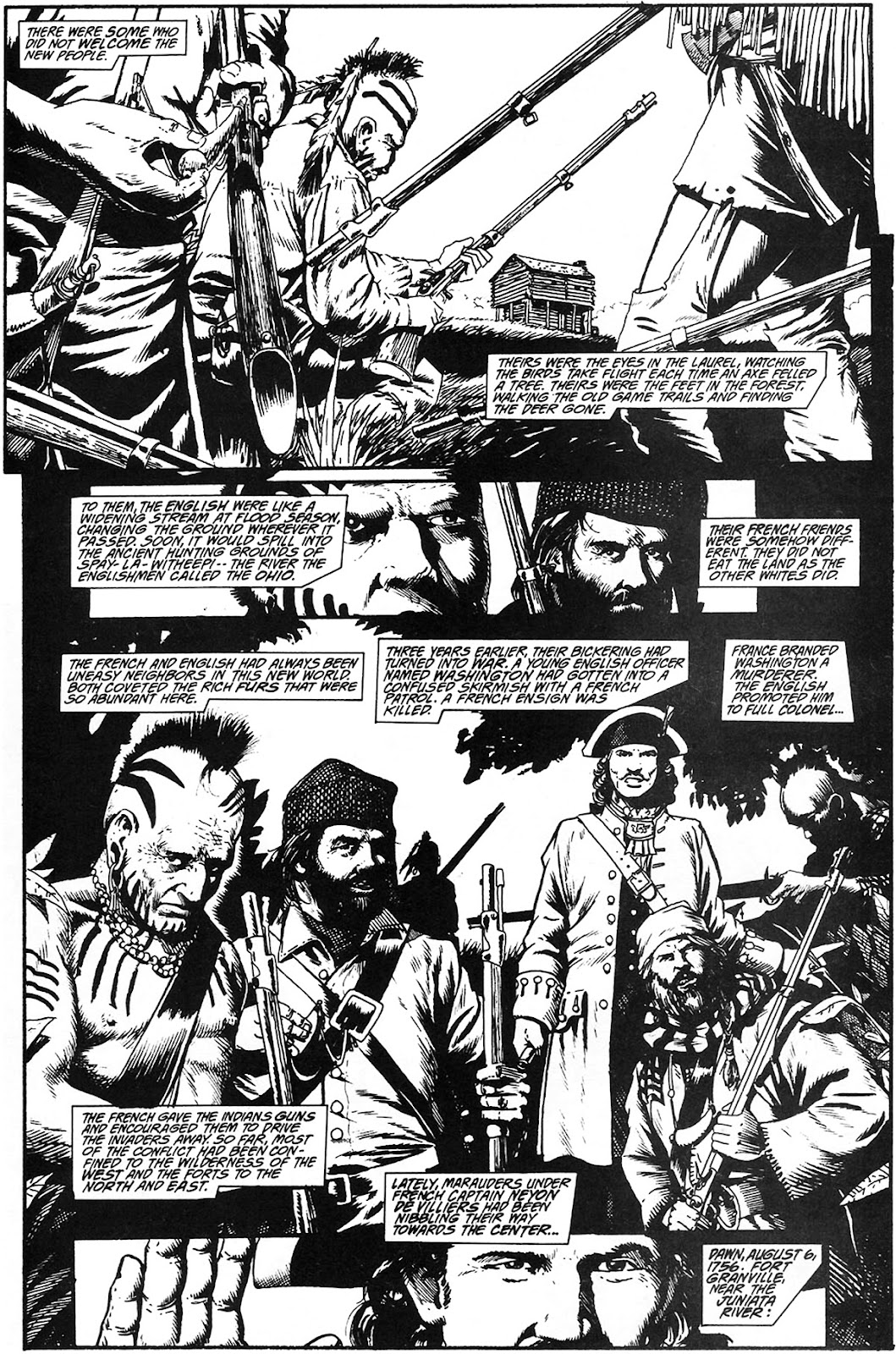 and picks up with the family at Fort Granville, as they are attacked by the French and Lenape. The prisoners are taken to Kittanning, the home of the Lenape and their fate is decided by the families of the slain warriors. 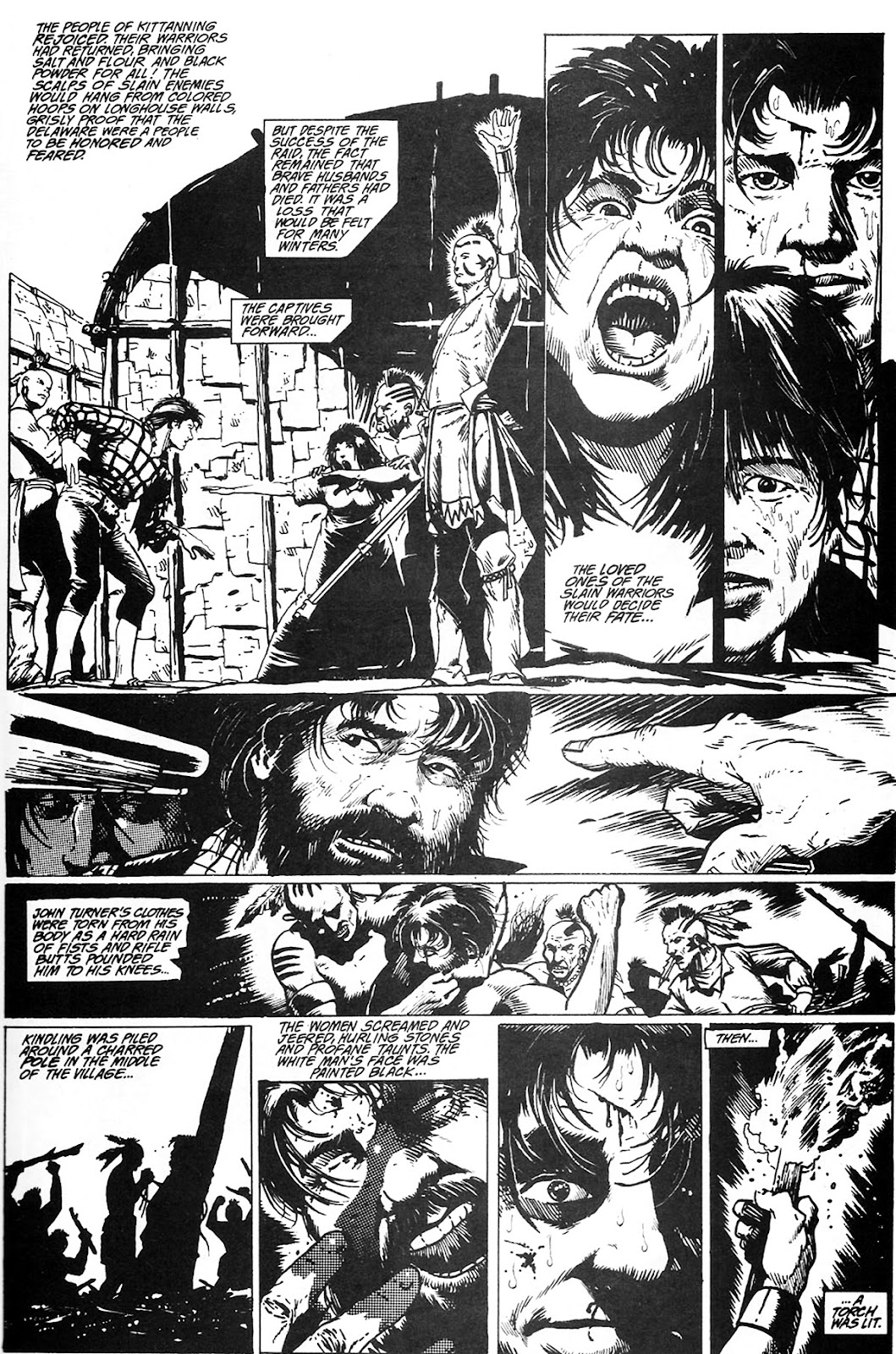 John Turner is tortured and killed and the family split. Simon runs the gauntlet and is badly beaten and injured, but survives and wins respect. His wounds are treated and he becomes a member of Guyasuta's family. In 1764, he is returned to the British, at Ft Pitt.... 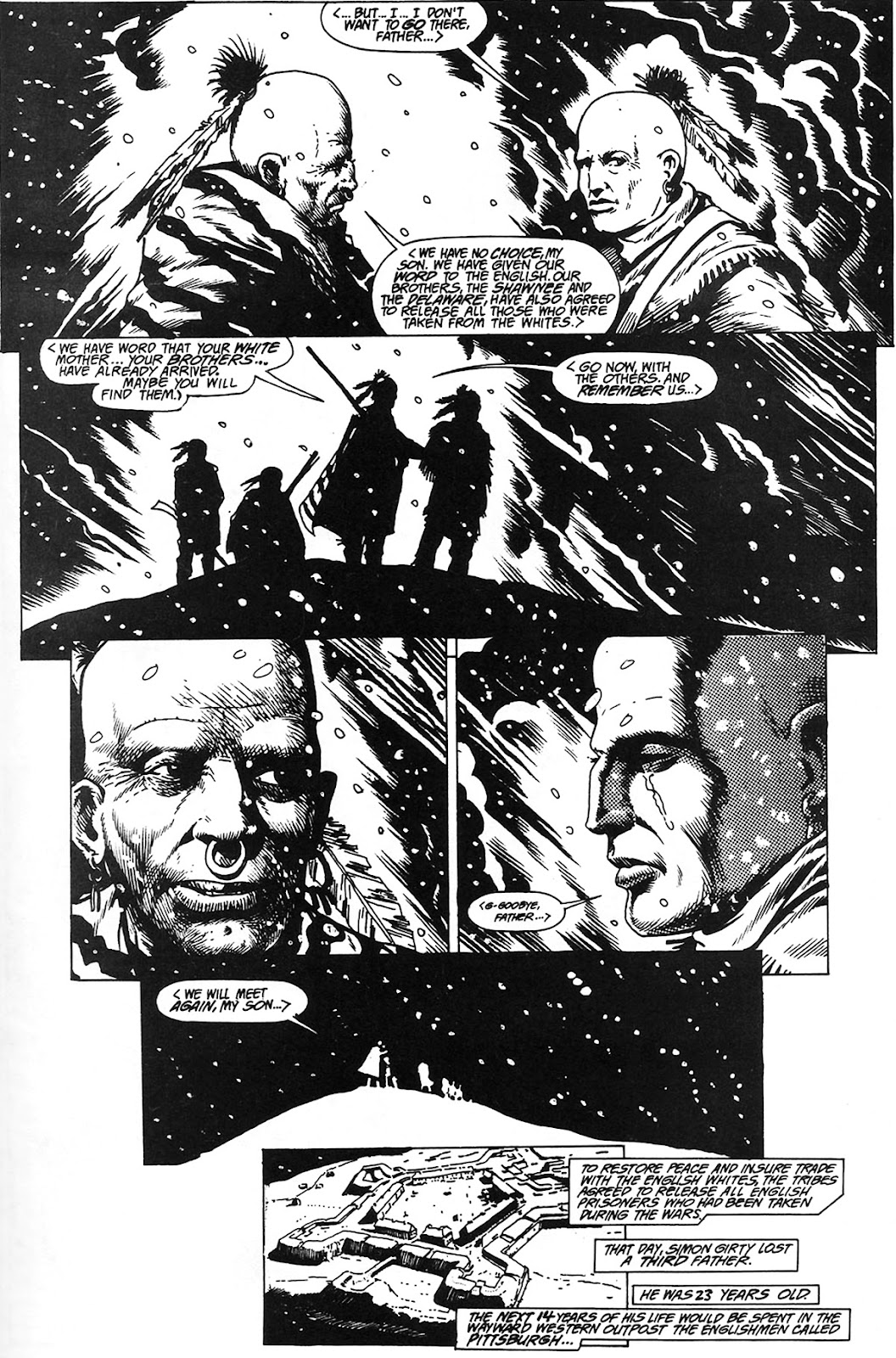 Girty becomes a hunter and scout for George Morgan, as they hunt and trade along the frontier of Kan-Tu-Kee. Truman uses the words from Morgan's letters to tell the story and uses other contemporary accounts of Girty, in letters and records. Simon's brothers live around Pittsburg and are well respected. Simon befriends a half-breed Scot, named Alexander McKee. Truman relates the events of Pontiac's rebellion and the motivations for the native tribes to side against the American colonies... 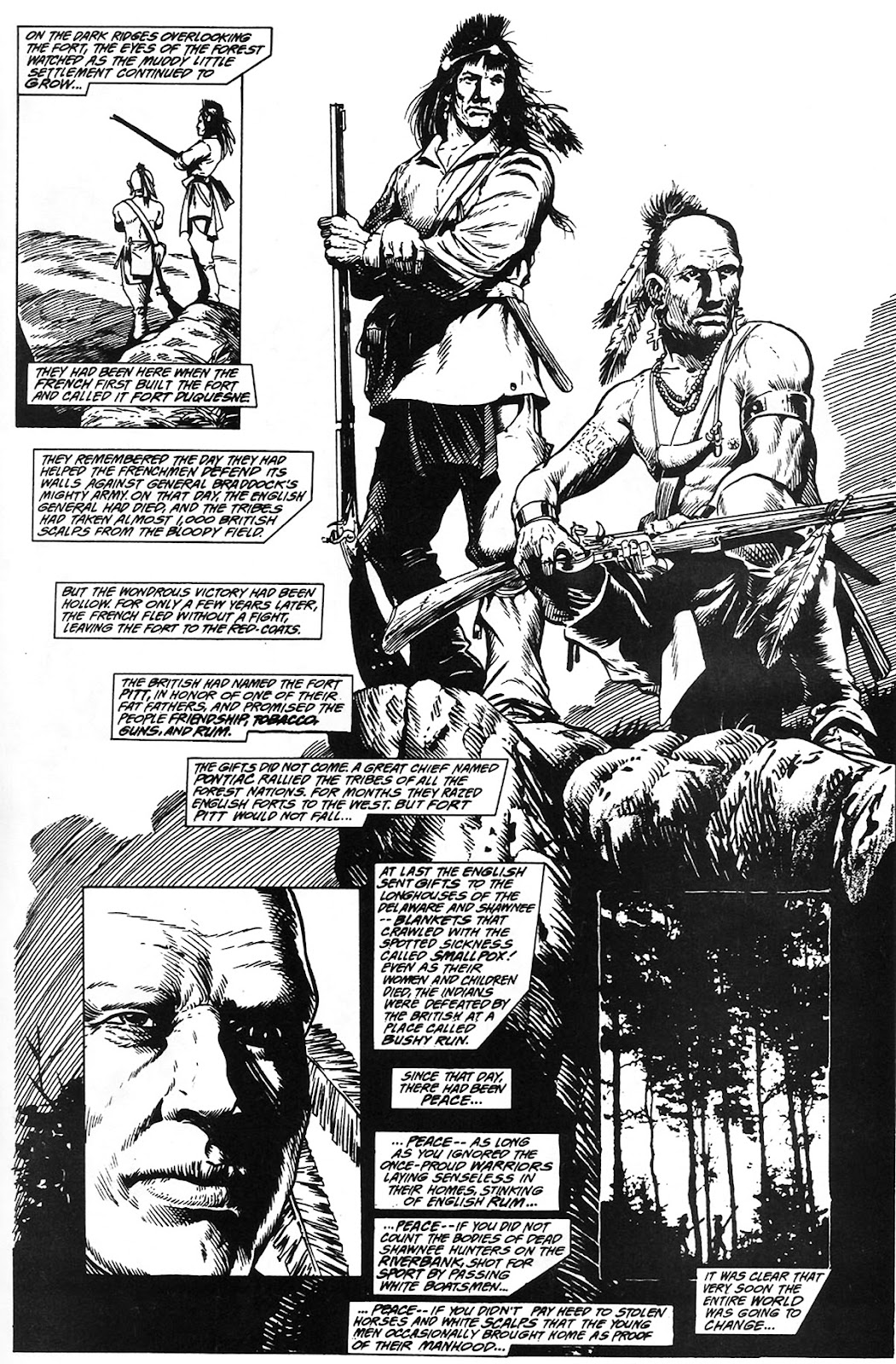 Girty becomes embroiled in land squabbles between Pennsylvanians and Virginians, who covet tracts of land in the Ohio Valley, in Shawnee territory. This leads into Lord Dunmore's War, as the actions of colonial militia stir up hatred among the Shawnee and Mino, as a peaceful brother of the chief is murdered by a militia captain. The fighting is brutal, but peace is eventually made, with the whites gaining the rights to settle and hunt in Kan-Tu-Kee. The rebellion against the British drives out Dunsmore and Pittsburg becomes part of the rebellion, with reprisals against the Virginians who had sided with Lord Dunsmore. Simon is reacquanited with his friend McKee and used as a scout and diplomat, to implore the Seneca to refrain from joining other tribes to aid the British against their colonial enemies. He is nearly killed but makes it back, only to find his promised captaincy given to another and his request for reimbursement of his lost goods and equipment denied. Anger and resentment stews. Girty is a scout for a party sent to Cayuga to intercept store of arms from the British. Instead of warriors, they find women and children. The women are enslaved and the colonel takes a scalp from a boy. Girty is disgusted and loses faith in the Patriots. They attack the Delaware, one of the few tribes that hadn't joined the British. Simon grows wary as he sees the Patriots seeking to kill every red man and wonders how the view one who lived among them. McKee and Matthew Elliot work on him, showing that the colonials act in bad faith. George Morgan is jailed as a Tory sympathizer. Simon moves on, along with McKee and Elliot. Girty joins the British and their native allies and fights against the Patriot forces in Kentucky. He comes across a former friend, Simon Butler, who has acted as a scout for George Rogers Clark. Girty pleads for his life and it is spared... 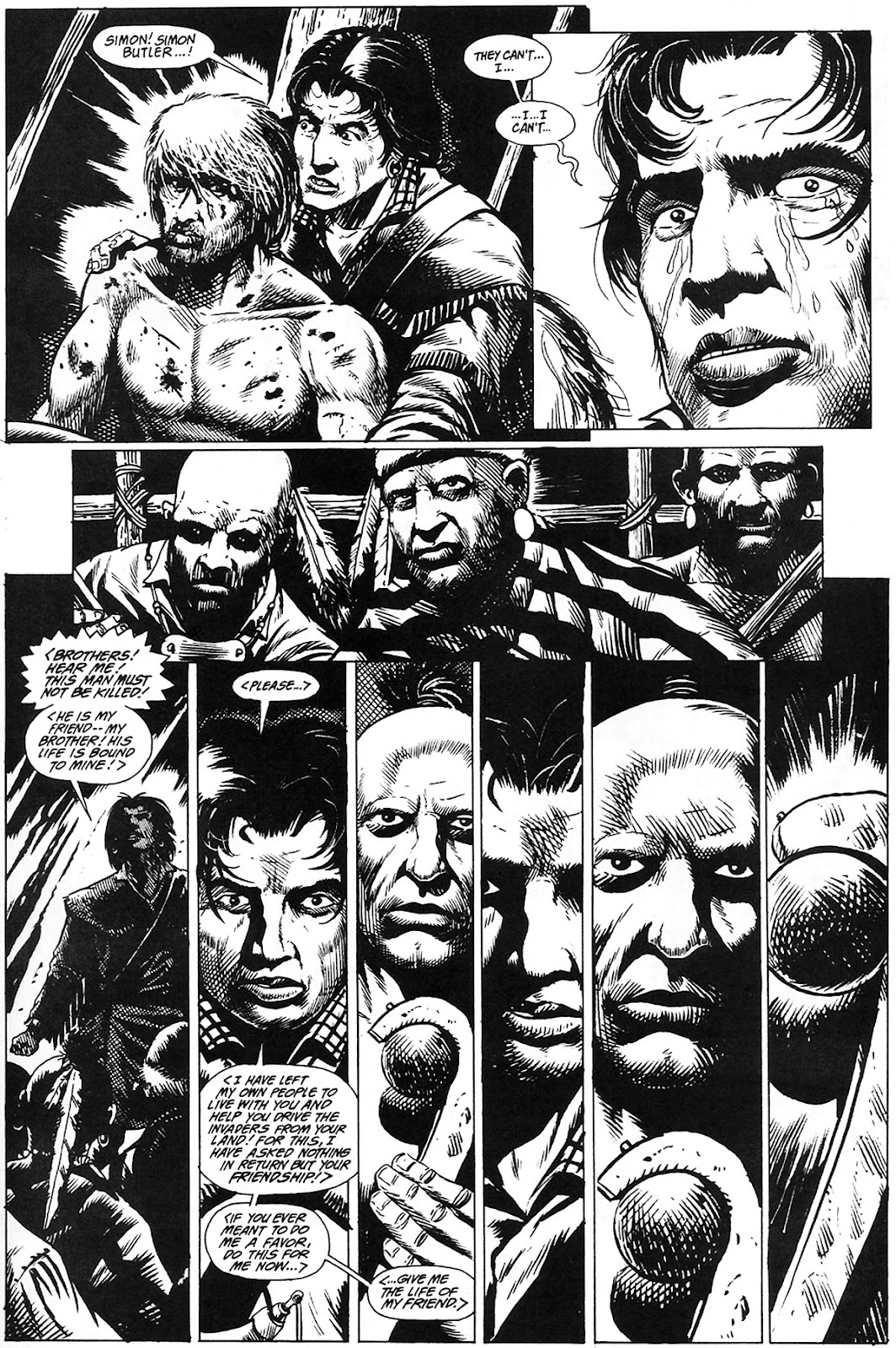 Truman continues with the exploits of Girty and the rest in the frontier fighting. Butler heals and Simon confesses to the man that he lives uneasily with the Shawnee, feeling that maybe he made a mistake in siding with them. After a bloody fight with the Patriots, a chief, named Redpole, demands Butler's life in repayment for the lost warriors. Girty pleads his case to the assembled leaders and to McKee and the British liasons, but it proves futile. Girty leads a party of Mingoes into the Ohio wilderness to raid and stir trouble, as well as spy on troop movements. The Delaware are still courting favor with the Patriots and Girty finds an old rivall leading the Patriots. he also finds himself with a price on his head, of $800, with both whites and the Delaware trying to claim it. Things go badly for the tribes and the British, though Simon gains them a victory, but sees the British fail to control their allies. He leaves the British to live among the Wyandott. Fighting continues and soon Girty is at odds with his allies and his enemies. Book 2, "Bloody Ground" Trumanpicks up the story in 1817, as Girty is in poor health and dying, looking back. Girty and the Ohio tribes, along with British rangers are waging war, unaware of the British defeat at Yorktown and the cessation of hostilities between the rebels and the British crown, as diplomats take over to negotiate a peace. On the frontier, the fight continues. Girty and his bands hail an outpost, Bryant Station and try to coax them to surrender. they are rbuffed and disappear in the night. relief troops come to the station, then go hunting for the enemy, led by Col Daniel Boone. Boone is wary of the tracks, as they are too easy to follow, yet show signs of men walking in each other's footsteps to hide their numbers. he believes they are being led into an ambush... 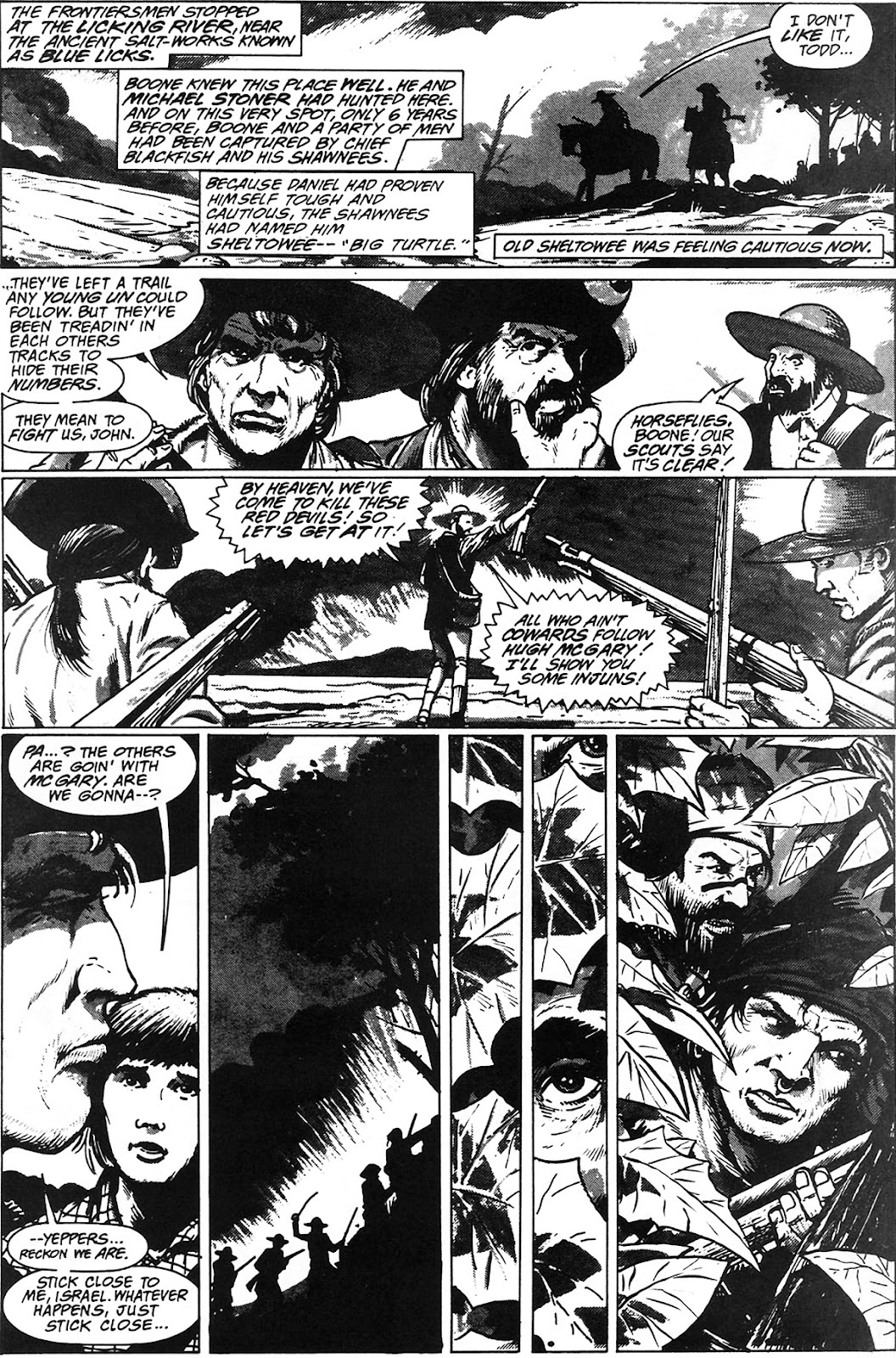 Boone's son Israel is killed, as are 70 others. Girty and his men return to their camp and learn that the British have indeed made peace with the Patriots and are withdrawing their soldiers. Girty settles down, though he is recognized as the elader of the ambush by Simon Kenton, aka Simon Butler, who survived. Raids continue and Girty's name is attached to every attack along the Ohio. Simon spent his time drinking, but found love with a woman, Catherine Malott, who had also been a captive of the natives. He had been granted land and still received payment from the british, as an agent. They soon called again upon his services, in 1785. he is sent as an emissary to the Iroquois, led by Chief Joseph Brant, who wounded Girty in a fight over who ad brought a victory. Brant appeals to girty that they need each other and they form a wary alliance. Girty and Brant help unite the tribes in fighting against the Americans, with the British aiding them. The Americans raid Kentucky and kill Moulatha, leader of the Shawnee, despite Daniel Boone telling them he could get them to leave the village peacefully. he was ignored and the Americans went with blood in their eyes. The tribes return to warring along the Ohio, until the Americans strike back, in 1790, leading to their ambush and defeat along the Wabash Creek.... 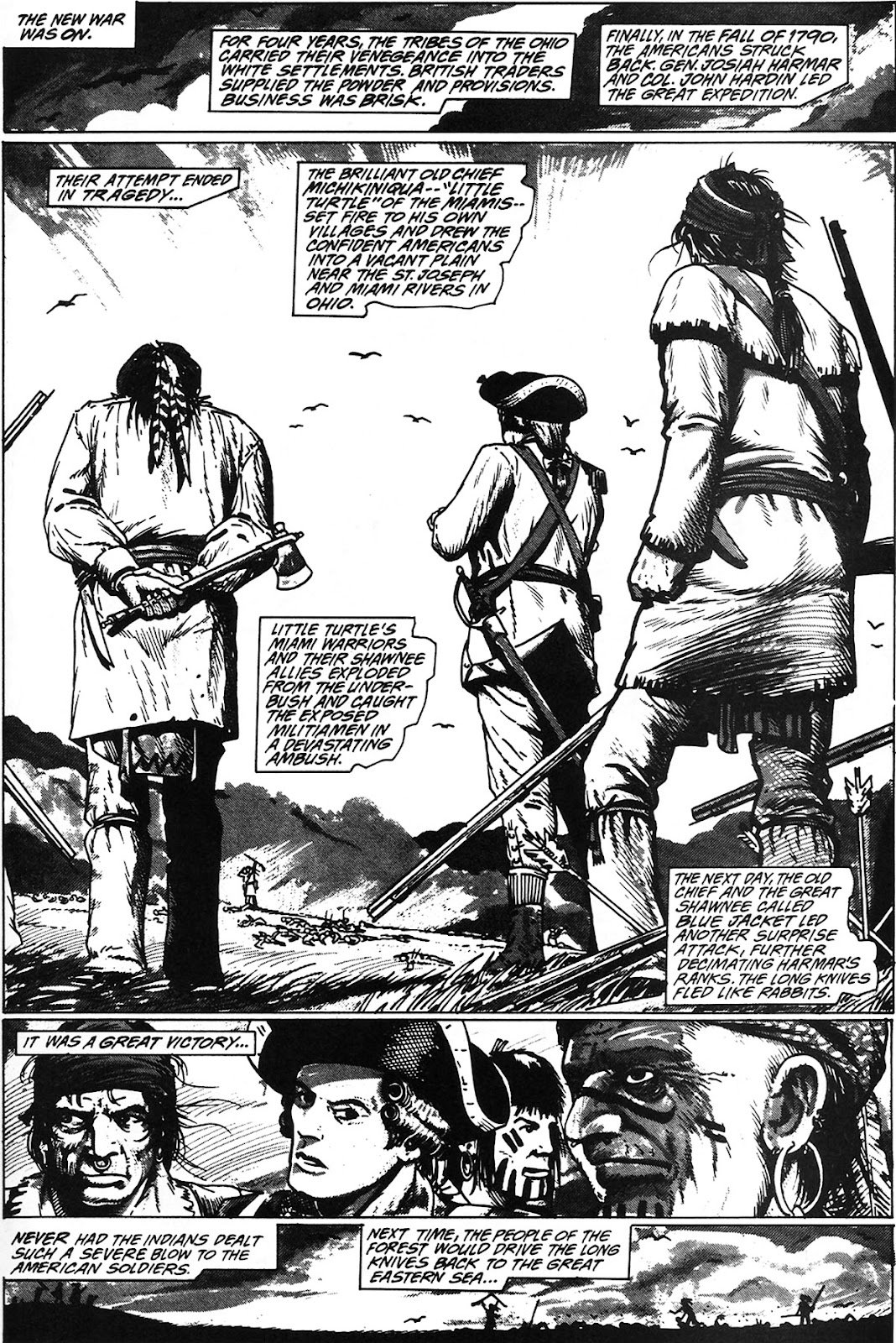 Reprisals come, the fighting continues. 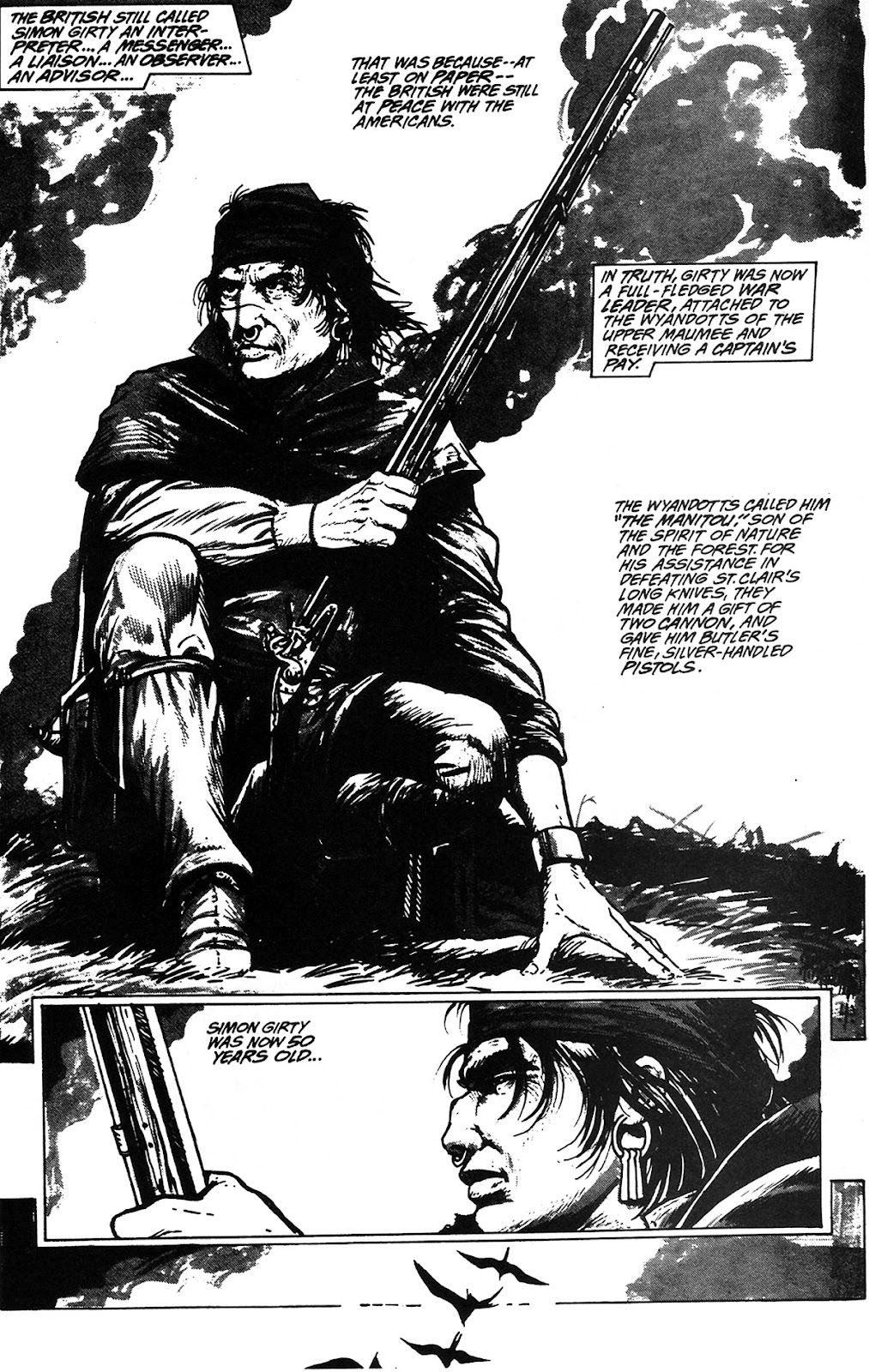 There follow tales of encounters with Girty, through the region. The war goes badly for the natives and the Americans push them further and further back into the Ohio region, towards Ft Detroit. Finally, the American's, led by "Mad" Anthony Wayne, defeats Blue Jacket and the Shawnee and the British turn their backs on their allies and refuse them entry into Ft Detroit. 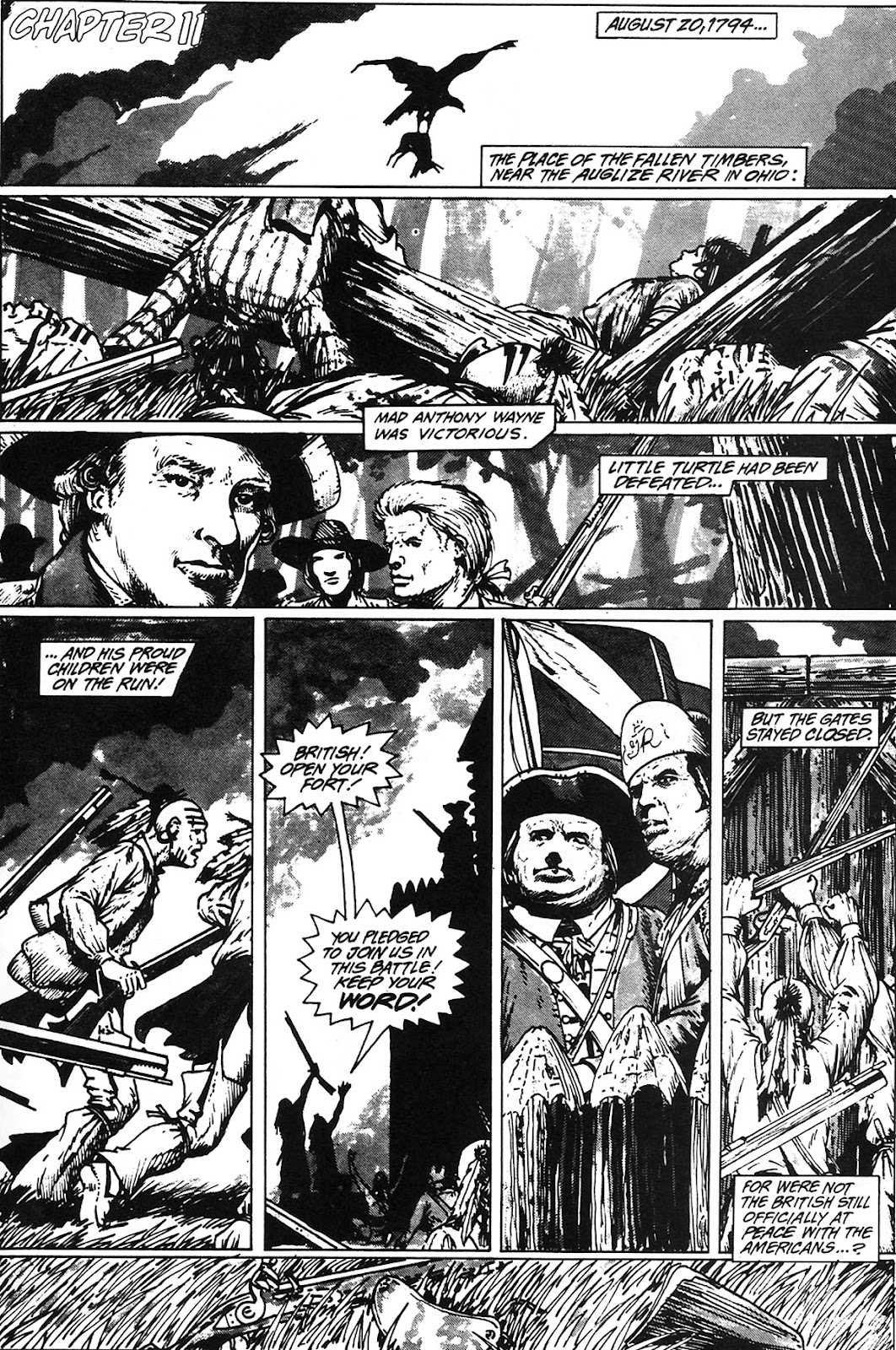 Girty sees the treachery and abandon's British service, disillusioned... 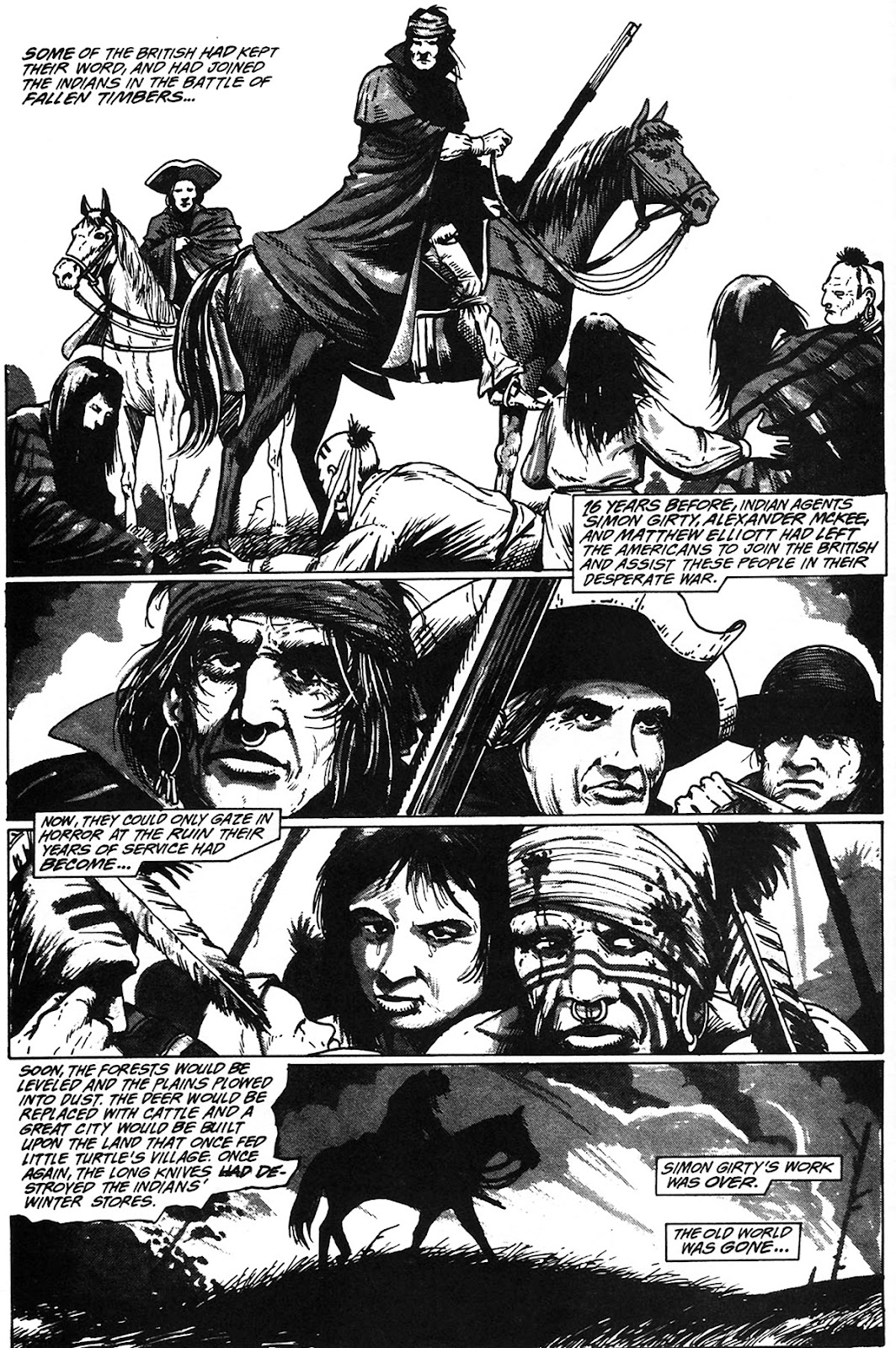 Girty loses his friends and his world changes. eeventually, the british cede Ft Detroit and the region to the Americans, with the signing of the Jay Treaty. Girty leaves in defiance... 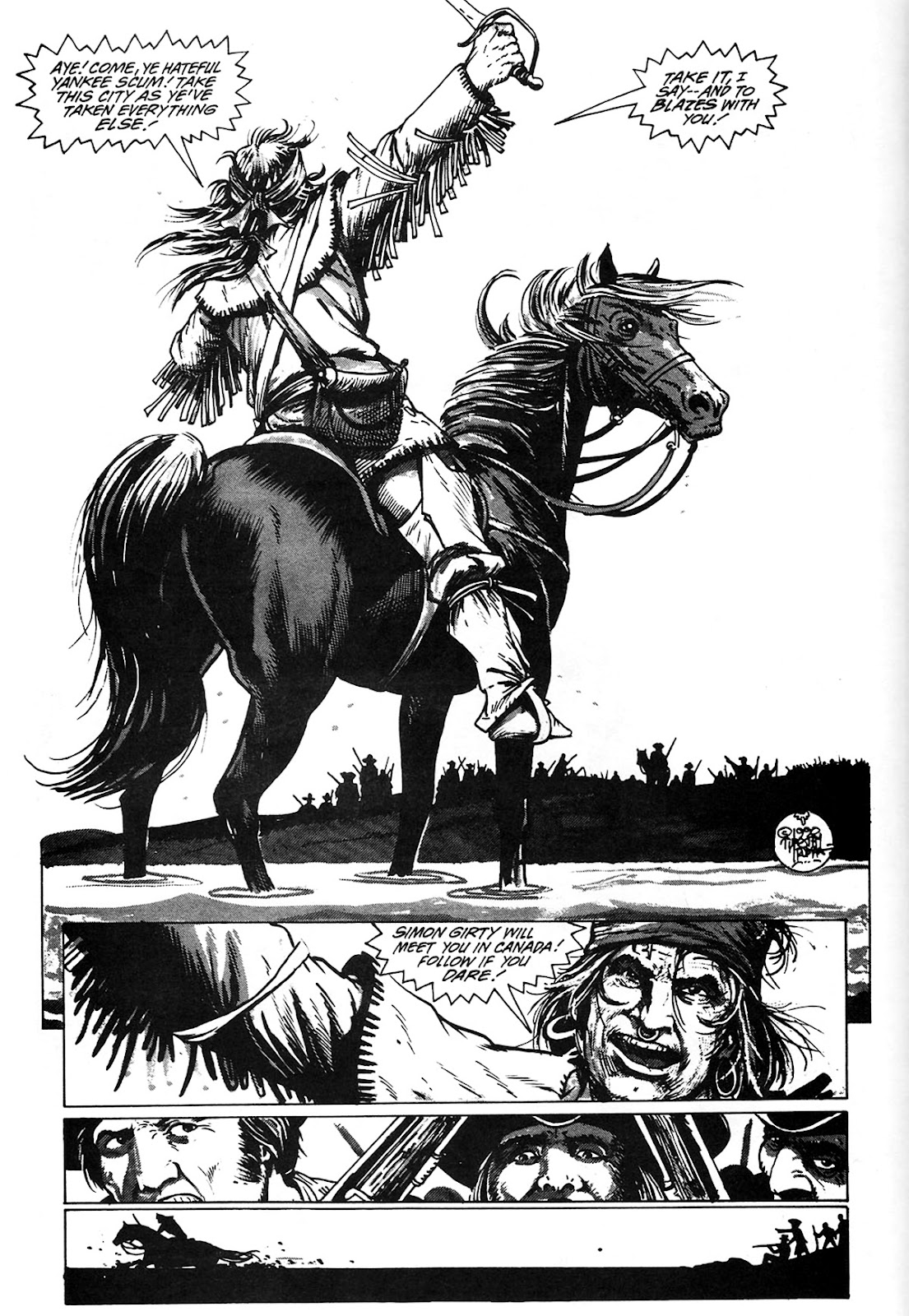 Girty descends into bitterness and alcoholism, exacerbated by arthritis and old wounds. He drives away his wife, who takes their children. The Shawnee, with the urging of Tecumseh, aid the British in the War of 1812 and take ft detroit. Simon Girty returns to it and enjoys some time in a saloon... 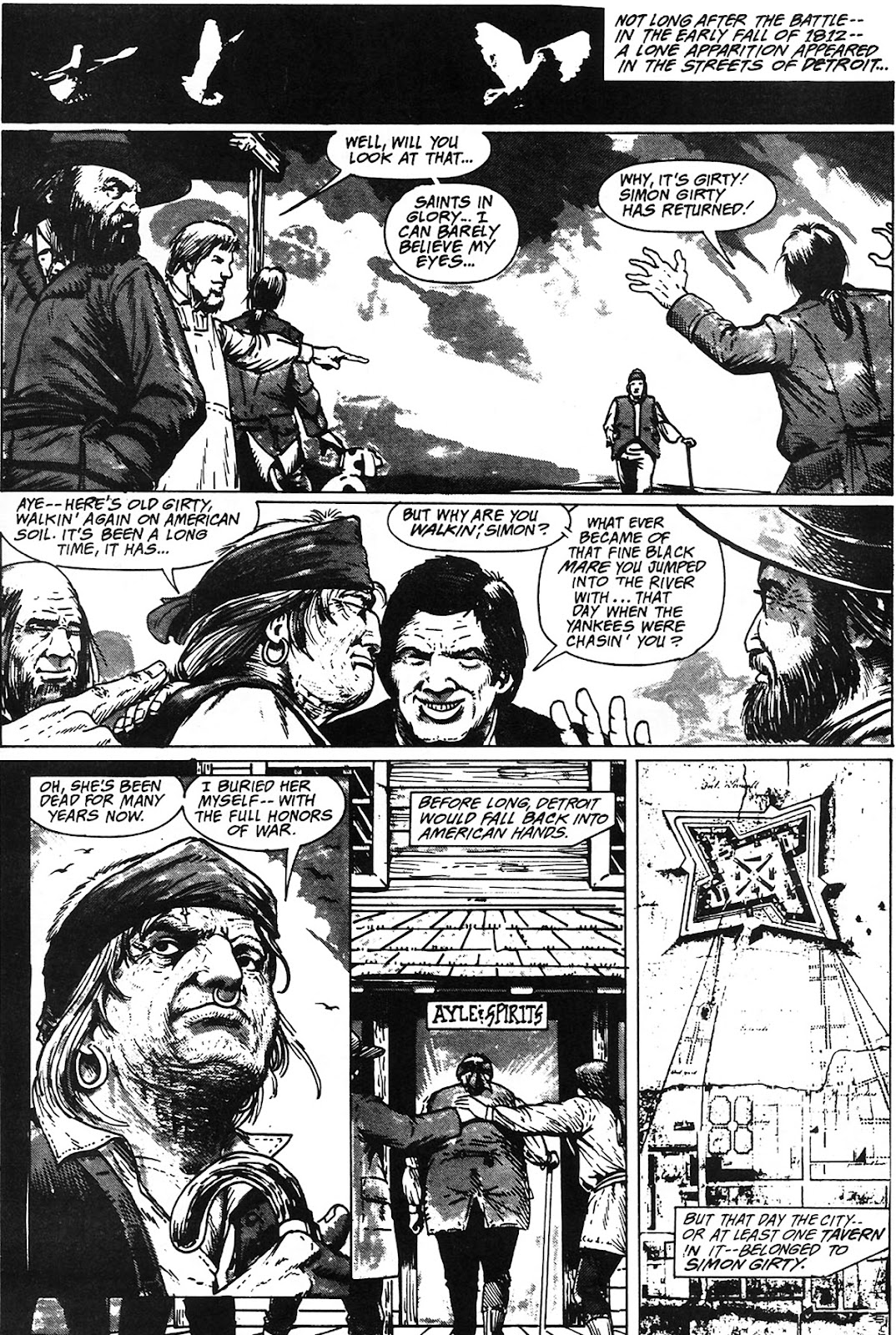 Simon Girty , cared for by his daughter Ann, dies in 1818. Thoughts: This is an amazing piece of work, both artistically and as a historical record, via the graphic medium. Truman applies everything he learned in his years since the Kubert School and weaves together a compelling narrative of a notorious figure, trying to get at the reality underneath. It is a "warts and all" portrayal of the man and the times, showing that much of what we learn in our history classes is told from one point of view and loses context in the retelling. Truman illustrates the frontier life accurately, from the dress to the equipment and the method of fighting. We do not see the stereotyped war boonets of Hollywood, but actual buckskin leggings and breechcloths, blankets and bedrolls, tomahawks and pistols, powder horns and moccasins. He distinguishes between the natives and frontiersmen and the white settlers, who wish to impose their civilization on this wilderness. It is a segment of history that is mostly forgotten, as contemporary entertainment left behind figures like Daniel Boone. When I was a child, our local station carried reruns of Daniel Boone, with Fess Parker, which, although highly dramatized and inaccurate, did shed light on those frontier days. Disney gave us the Davy Crockett legend, but film and television, alongside the western, gave us those frontier days. Books like Last of the Mohicans and Drums Along the Mohawk gave us a feel for those lands and the fights between the whites and the natives, though from the white point of view. Truman gives a more rounded look at that era, with some still coming out virtuous (Boone), some in between (Girty and George Rogers Clark) and some villainous. He highlights how the story of the American and British war didn't end with the Surrender at Yortown, as fighting continued along the frontier, with the British continuing to agitate the tribes to sow unrest and try to hold off American expansion. As we see in the end, it stiffened American resolve to drive off the natives and take the rich hunting and farmland for themselves and the natives learned that the British cared no more for them than the Americans or the French. They were pawns tot he whites, providing them with the furs and meat they coveted, but standing in the way of the land they wanted for their own. Truman doesn't sugarcoat things, either. There is virtue and cowardice on both sides, anger and treachery. The natives war on each other, though not to the degree that the Europeans would on the natives. He shows how Girty is hardened with the loss of 3 fathers: his birth father, Simon Sr, his stepfather, John turner, and his native father, Guyasuta. He prefers the old life of the tribes, hunting and fishing, occasionally warring, but is taken away from it. he spends the rest of his life trying to find a way to live that life, but never really gets to settle into it. He is an outsider to both worlds. Truman delivers the same truth that he had for Scout to Wilderness; but, this time, with a factual person. The second volume is filled with a list of sources he used and he used contemporary words and records where they existed, plus did his research on everything, from clothing to rituals, to politics within the colonies and among the tribes. It's a complex story that expands horizons beyond the traditional narrative of brave pioneers taming the wilderness to build a civilization; the American Myth, while Truman delivers more of the American Truth. Most Americans are oblivious to the various wars against the natives, including under George Washington's presidency, or the politics of the colonies, such as the rivalries between various colonies, especially in regards to unclaimed frontier land. Greed drove many things then, just as it does now. It is fitting that Truman did this work in black and white, as the world within is grey, with shades to many things and few absolutes, and little bright color. The only thing missing would be to colors of the wilderness, the animals, the vast forests of trees. So much of what is now farmland, cities and suburbs was once covered by trees and meadows, with rich soil and teaming with wildlife. In crafting a nation, that wilderness was carved away and what was was lost. The people lived more in tune with that world went with it, both from direct warring, to disease and just a loss of their way of life. Those that survived were changed, until those groups were gone, either in spirit of reality. I bought the albums as they came out and devoured them, reminded of my early childhood, watching Fess Parker and Ed Ames live their frontier adventures, or Grizzly Adams, Mad Jack and Ben meet various strangers in their wilderness. I was reminded of the early episodes of the mini-series Centennial, with Robert Conrad as a French courier and Richard Chamberlain as a Scottish hunter and trapper. Stories of traders and hunters, explorers and misfits who went off into the wilderness. The reality of those men was rarely contained in the stories, but they stirred the imagination of youth. Truman gives us that, plus the reality and the history, far too often left to the few who study at the local level, give the tours of historical sites that visitors often tune out or write the books that a select audience reads. Several years later, I gave my copies to a friend's father, who was a frontier re-enactor and had read about the books, in an article in an old magazine, from the early 90s. he had asked me if we could get them, at B&N, but I explained that Eclipse had gone bankrupt and the books were out of print. I did a little searching on line, but they were relatively rare and pricey; so, I gave him my copies, since I had read them, figuring that the work would get reprinted, eventually, given how good it was. The books were eventually reprinted a couple of years later, by Roger Broughton's ACG, along with some of Truman's other work, including his frontier collection Straight Up to See the Sky, in 1999. If you have any interest in frontier history or just want to see amazing art and skillful storytelling, I highly recommend these.
|
|
|
|
Post by codystarbuck on Jun 16, 2021 17:56:01 GMT -5
ps Next time, Barreiro & Alcatena's Moving Fortress, with adaptation by Chuck Dixon.
|
|
|
|
Post by brutalis on Jun 16, 2021 18:04:25 GMT -5
Yeppers indeed, Wilderness scratches my Wild West itch very well. Next to the history of the West, Frontier times is a very close 2nd in historical reading for me. Truman knocked it out of the ballpark and out yonder deep into them thar woods!
|
|
|
|
Post by codystarbuck on Jun 24, 2021 15:26:41 GMT -5
This is going to be a catch-all summary of the graphic novels published by 4Winds, in conjunction with Eclipse, aside from Tim Truman's work. They are fairly typical of the European graphic album format, about 64 pages, done in black & white. Moving Fortress Creative Team: Creative Team: Ricardo Barreiro-writer, Chuck Dixon-English adaptation, Quique Alcatena-art, Tim Harkins-letters, Tim Truman-editor Synopsis: A man, by the name of Bask deAvregaut pilots an aerostat (unpowered balloon) across a plain, escaping some fate that is implied to be either marriage or death, after a lover bears a child. He comes across the spectacular sight of a massive fortress, on wheels!  The guns of the fortress open fire and bring down his airship and Bask is taken prisoner. He is told to don a heavy suit and is taken into the bowels of the vehicle, to the boiler rooms, where he is made a stoker, forever feeding the poisonous ore that fuels the structure. He is told the air is poisonous and he can never take the suit off and learns to eat liquified food and drink water through tubes. He is befriended by another slave, Bisson, who teaches him the ropes. The fortress comes under fire from both airships and cannon beasts, from the city of Yathros... 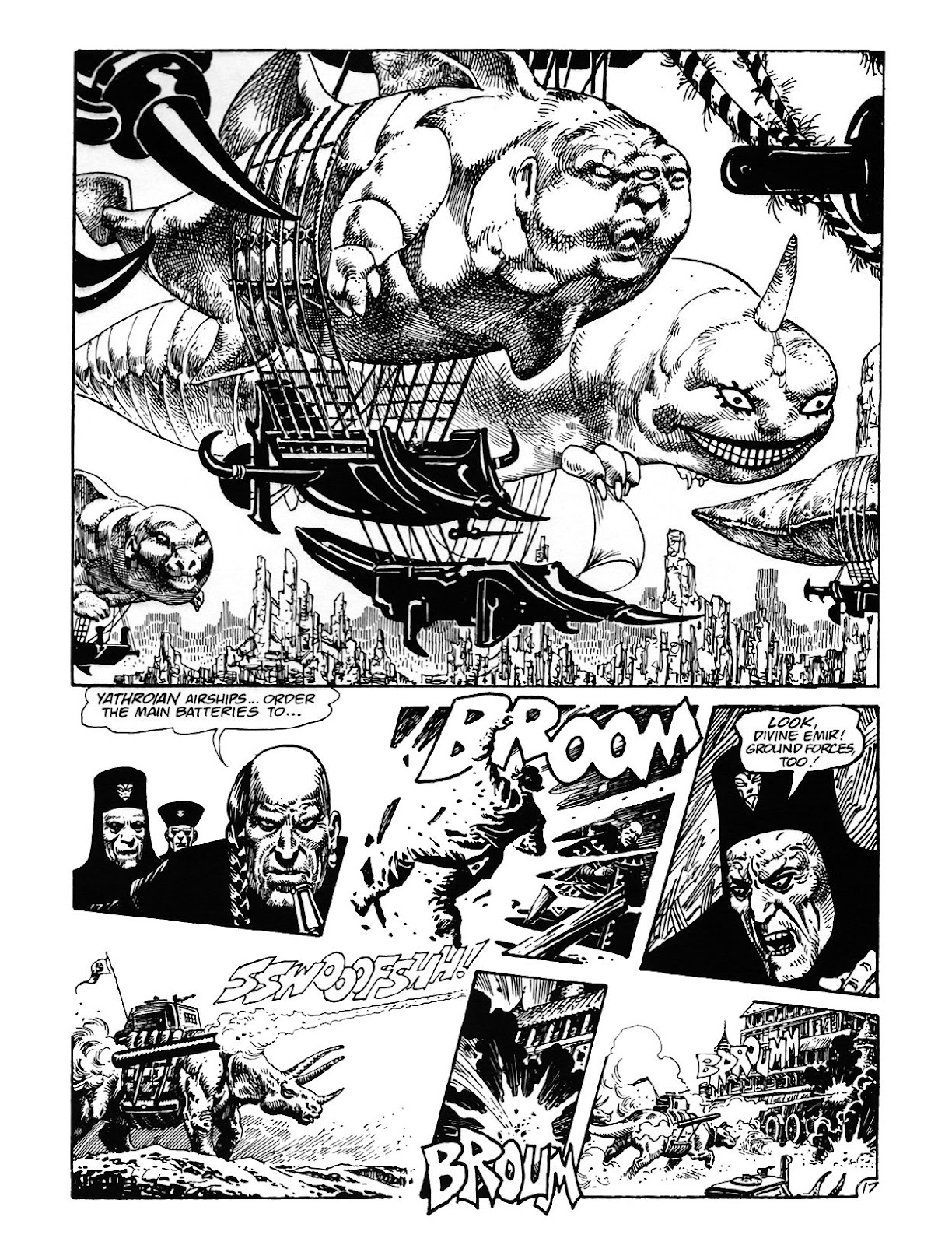 The fortress his hit by bombs and cannons and Bisson and Bask flee the boiler room, but Bisson is killed. Bask kills the guard and escapes to fresh air, where he is ordered to aid a cannoneer. he does so and hits one of the cannon beasts and helps drive off the attackers. he is immediately promoted to cannoneer by the master of guns, Cromwell. Cromwell fills him in on the battle they just fought. Their lord, the Emir Basileo, threw a grand party, inviting dignitaries from other cities. One of them was the "war god," Phradis. Phradis seemed bored, lusting only for battle, until he was introduced to Basileo's new bride. Soon, human lust replaced battle lust. Phradis led an aerial raiding party and stole away the Emir's bride, while he was off hunting. Basileo stews and is visited by 4 strangers, who give him the secrets to building and powering the moving fortress. He sets on the tasks, which begins with mining the poisonous ore, then construction of the vehicle and armaments, then sets about to reach Yathros and reclaim the emir's wife. When they come in sight of the city, as massive battle ensues, as Yathros defends with airships and war eagles, as well as cannon emplacements. Bask ends up taking over the guns when Cromwell is downed and then finds himself tasked to pilot a dirigible into the city, to land a raiding force, led by the Emir. He battles Phradis and wounds him, but his bride protects her new lover. Basileo is hit and his men pull him out. He vows to level the city and Bask is given his chance to flee, thanks to Cromwell and leaves in an aerostat, just as he came. Thoughts: The basic story is good, if not the most original, drawing from the Trojan War. However, the artwork is amazing, with Barreiro giving it al a mixture of medieval fantasy and steampunk futurism, all in a neat little package. The images are captivating on every page, with elaborate costuming and exciting staging to the battles, plus the awe-inspiring sight of the fortress, the airships, the cannon beasts (dinosaurs with cannons strapped to them). The poisonous ore is obviously radioactive and there is a bit of commentary, metaphorically, on the dangers of nuclear power, as well as the futility of war, particularly when fought for personal vendettas. Tim Truman provides an introduction, which on the surface sounds a little pompous, as it berates the childishness of American comics, while European and South American anthologies are filled with stories for all ages and tastes. I said on the surface because he's actually correct. American comics have been and continue to be dominated by one genre, with a rather great immaturity to the storytelling, because, as Truman points out, so many American artists have been influenced by comics and only comics, while the Europeans and Latins have drawn from fine art, literature, comics, film and theater, given they were less dominated by mass media in some of their regions (such as Argentina). Their comic magazines carried work from around the globe, showcasing the best of the best from multiple cultures. Moving Fortress makes a pretty good case for Truman's thesis. The book was followed by a sequel, Subterra; but, alas, I don't have a copy to review...  It was a second adventure for Bask, and Truman's intro in Moving Fortress said the team was publishing a third tale, in the pages of the anthology Skorpio. Alvar Mayor: Death & Silver Creative Team: Creative Team: Carlos Trillo-writer, Chuck Dixon-English adaptation, Enrique Breccia-art, Tim Harkins-letters, Tim Truman-editor Synopsis: The first story, "The Amulet, finds the vagabond, Alvar Mayor, on the path to Lima, in Peru. he meets up with Jose Molino, who once served under him, on the ships Santa Natalia. The catch up on old times and Molino offers to wine and dine Mayor with the one silver coin he has earned, in the Americas, when they chance upon a haunted old man, Zicotl. he is a native and tells a tale of woe, of the coming of the Europeans and the chief's sister taken away by a red-haired devil. The chief, Kalai, and Zicotl try to persue, but are swept away by a storm, when they take to the ocean. They are pulled aboard by a ship and made slaves and Zicotl is driven mad by visions of Kalai's sister, while Kalai grows mad with vengeance. They come to where the girl is and try to rescue he. Kalai seeks to kill his sister for leaving with the white and Zicotl kills his master to spare her, but is tormented by ghosts of his master. Jose gives him the silver coin, telling him it is a powerful amulet. Zicotl is calmed and Molino and Mayor continue their journey. 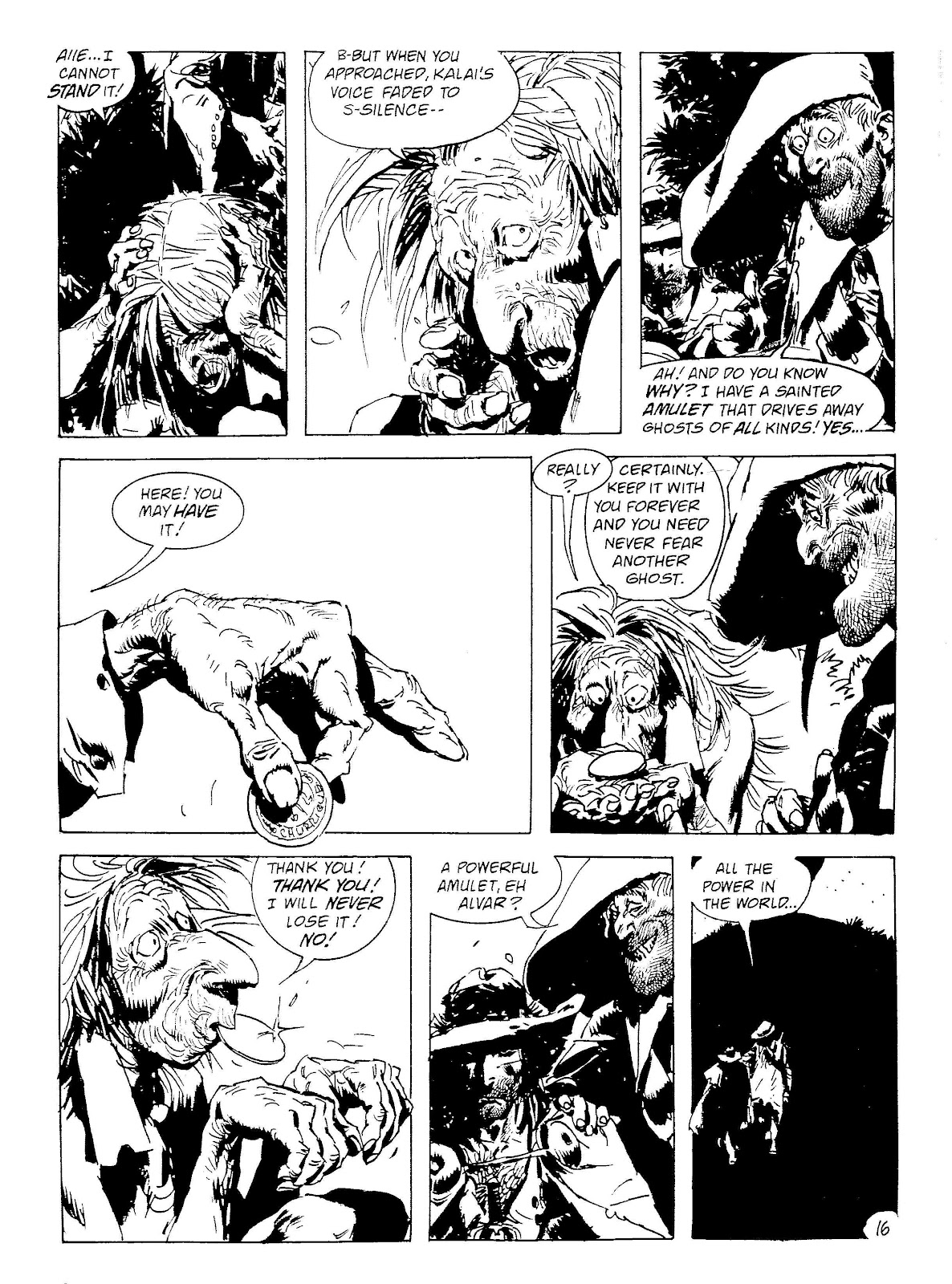 "Dream of the Full Moon"-Mayor is asked by a young woman (a mestizo)to help save her father from dying, as he has seen in a dream. He is gathered with warriors in a temple, when he is struck down by his enemy, with a spear. It happens on a full moon, which is a few days away. Mayor owes the man a debt and agrees to take the enemy prisoner, so he cannot fulfill the dream. He sneaks into the enemy encampment and succeeds in kidnapping the man and spiriting him away. he holds him in a cage until the passing of the full moon. He comes to release him on the next morning and the man says he had a vision that he stole into a temple and murdered his enemy, with a spear. He departs and Mayor returns to find his friend dead, as in his vision... 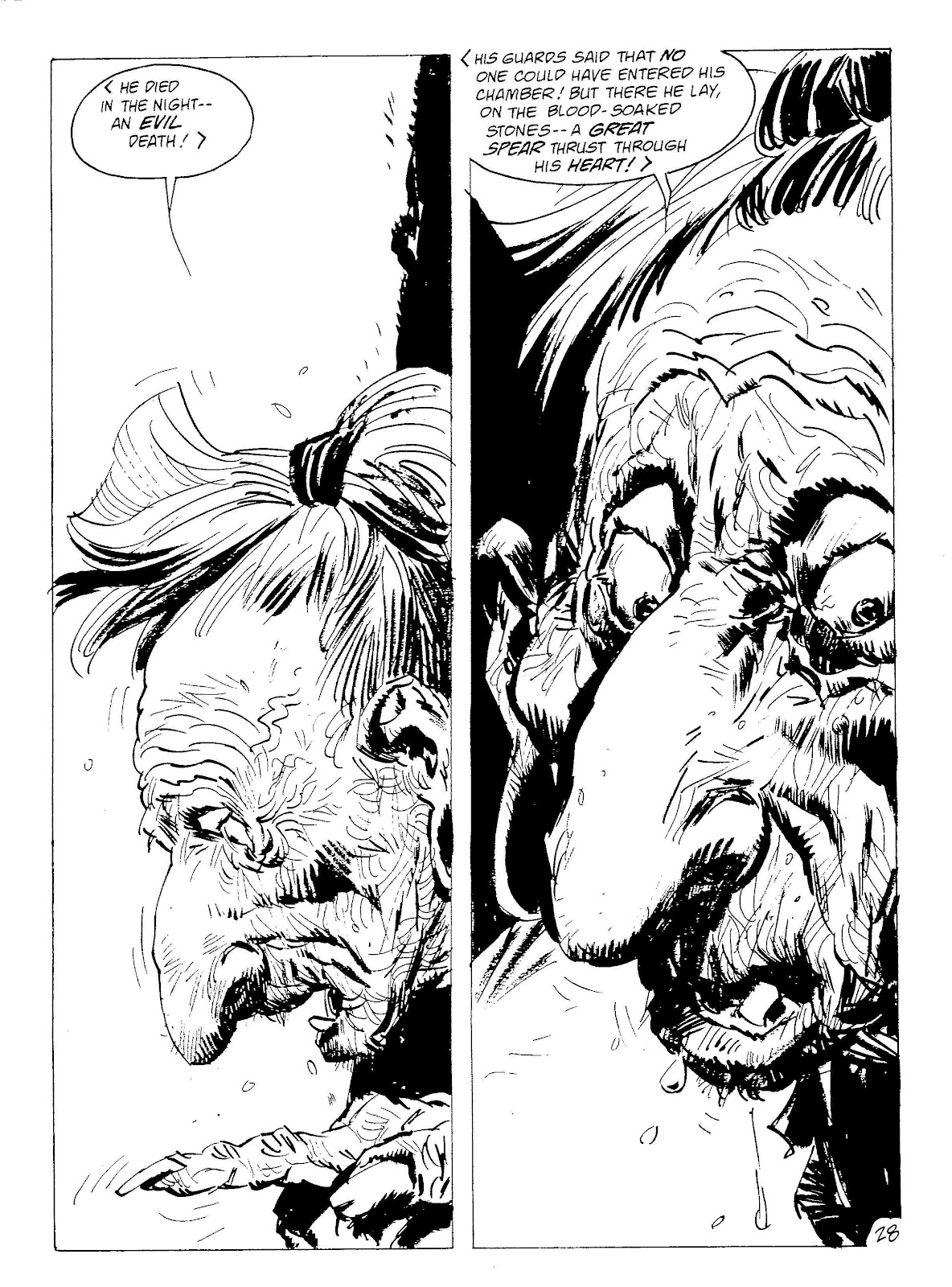 "Fortune & Fate"-Mayor rescues a gambler from angry players, who accuse him of cheating. They escape into the jungle and eventually come across a woman, left as a sacrifice to a snake god, by a rival tribe, after a raid. They save her from a serpent, then offer to protect her from the enemy. However, they are cut off and one must stay to hold off the attackers. They cut cards and the gambler loses. 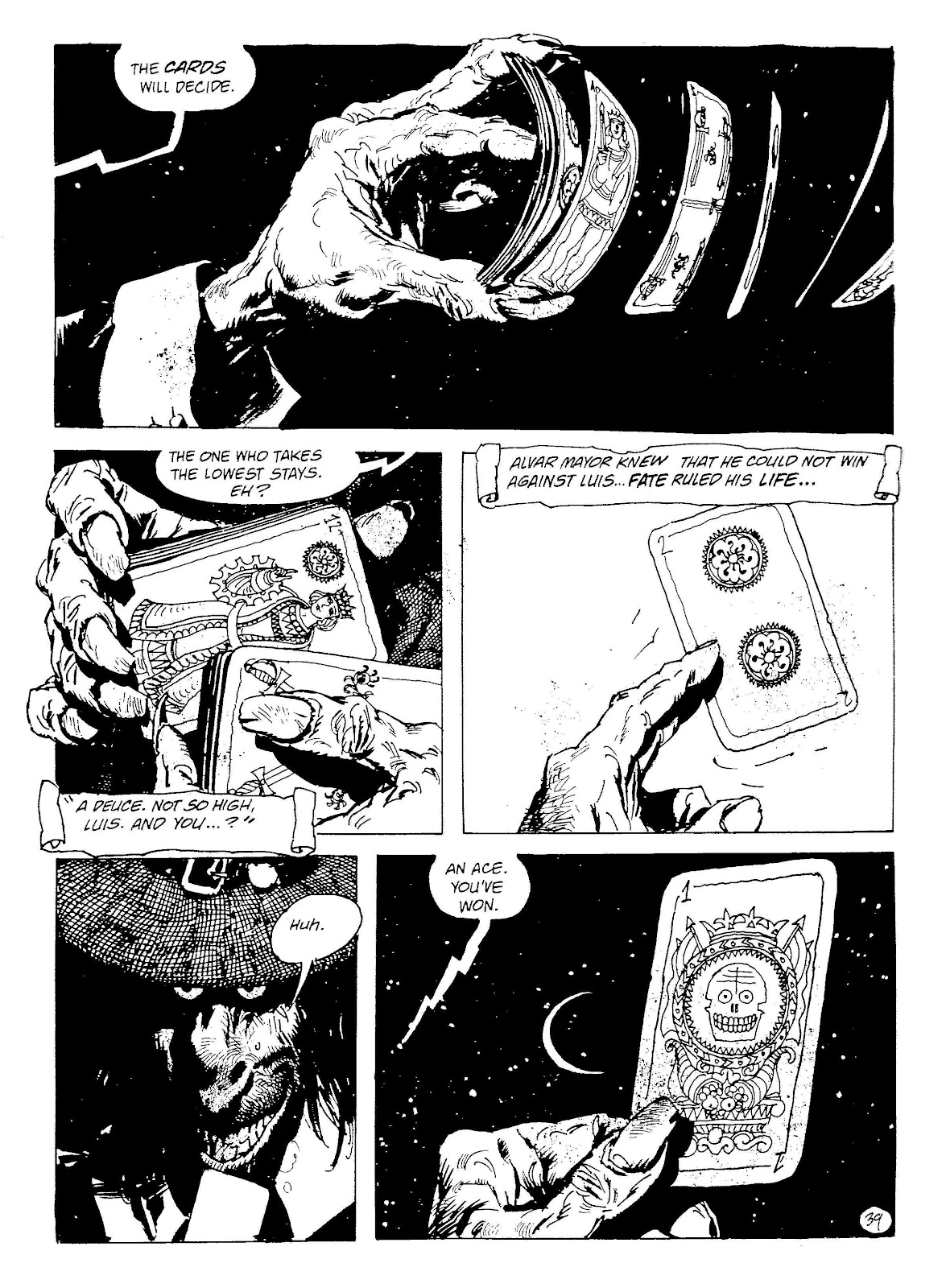 Mayor takes the girl and they later hear the sounds of battle and the girl says the man was unlucky. Mayor reveals that the man was a cardsharp, with marked cards and knew what he was drawing ahead of time, sacrificing himself for the woman. "Twice in Villazona"-A village beset by bandits is led by Mayor, in their defense.... 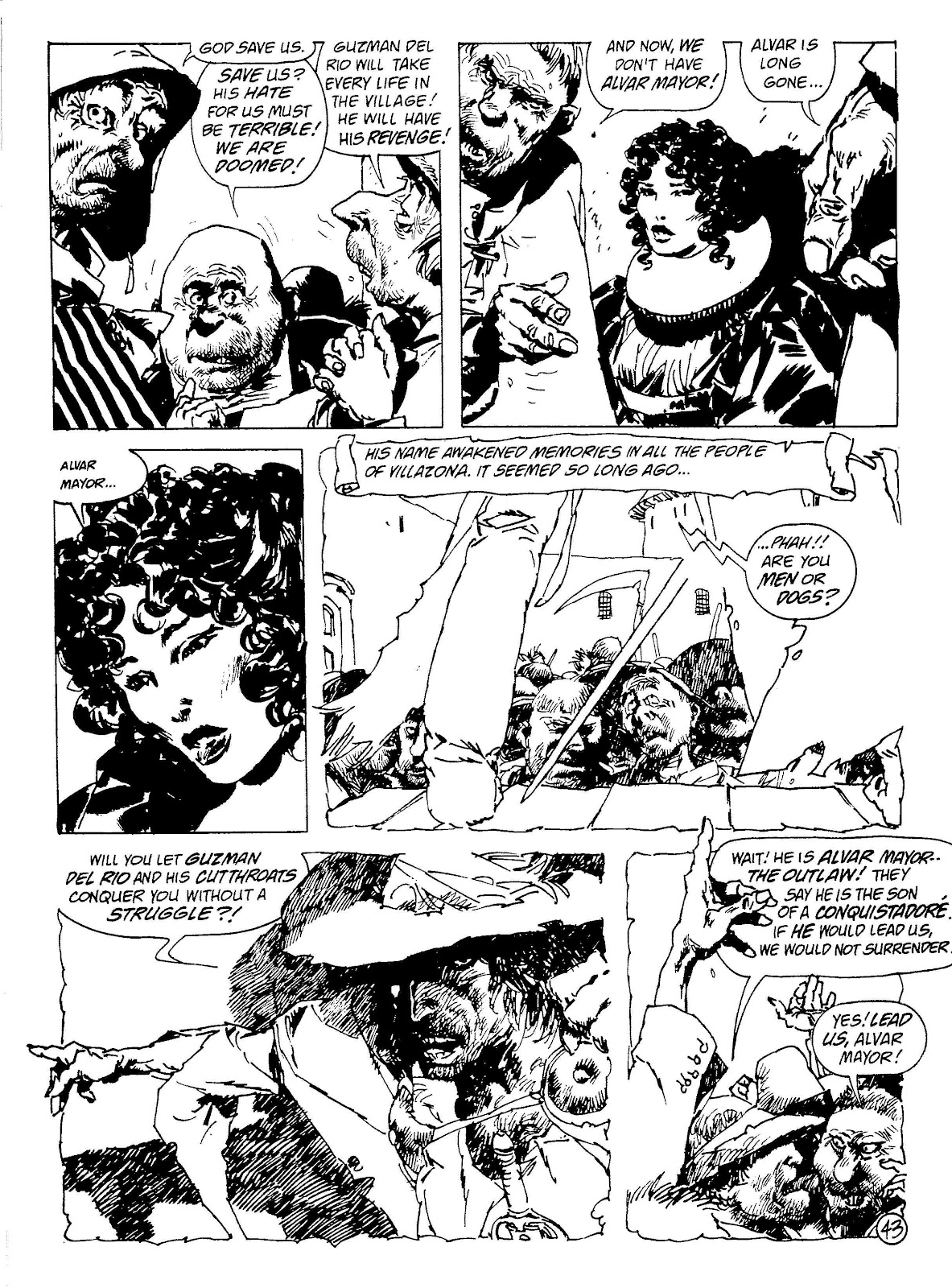 After the battle, Mayor departs on his endless quest. The bandit leader returns, confident of victor without Mayor's presence. O woman catches the bandit leader unaware, tipping a statue over on him, crushing him, saving the village, following Mayor's example. Thoughts: 4 short, but engaging tales of psychology and human drama, with Alvar Mayor more an observer and catalyst of action, rather than a direct actor (for the most part) We meet interesting characters, hear their tale and see mayor intercede with advice, an action, or just as an inspiration. The tales are all set in the Spanish colonies of the Americas, in the time of the Conquistadores and those that followed. Breccia's art is stylized but captures the variety of emotions, from fear to joy, anger to obsession, light to dark. The tales move swiftly and leave you wanting more. Downtime Creative Team: Creative Team: Emilio Balcarce-writer, Chuck Dixon & Tim truman-English adaptation, Juan Zanotto-art, Tim Harkins-letters, Tim Truman-editor Synopsis: In a post apocalyptic future, automated killing machines hunt down survivors. We are told it is 8 years after the war, in a world of nuclear winter. We see a pair in gas masks and heavy clothes, scavenging in a supermarket. They make noise which draws a Lion, a killing machine that keeps score on its hull, like a fighter pilot. The pair are wiped out, leaving their young daughter all alone. 19 years later, she is a grown woman and a deadly killer of the machines. 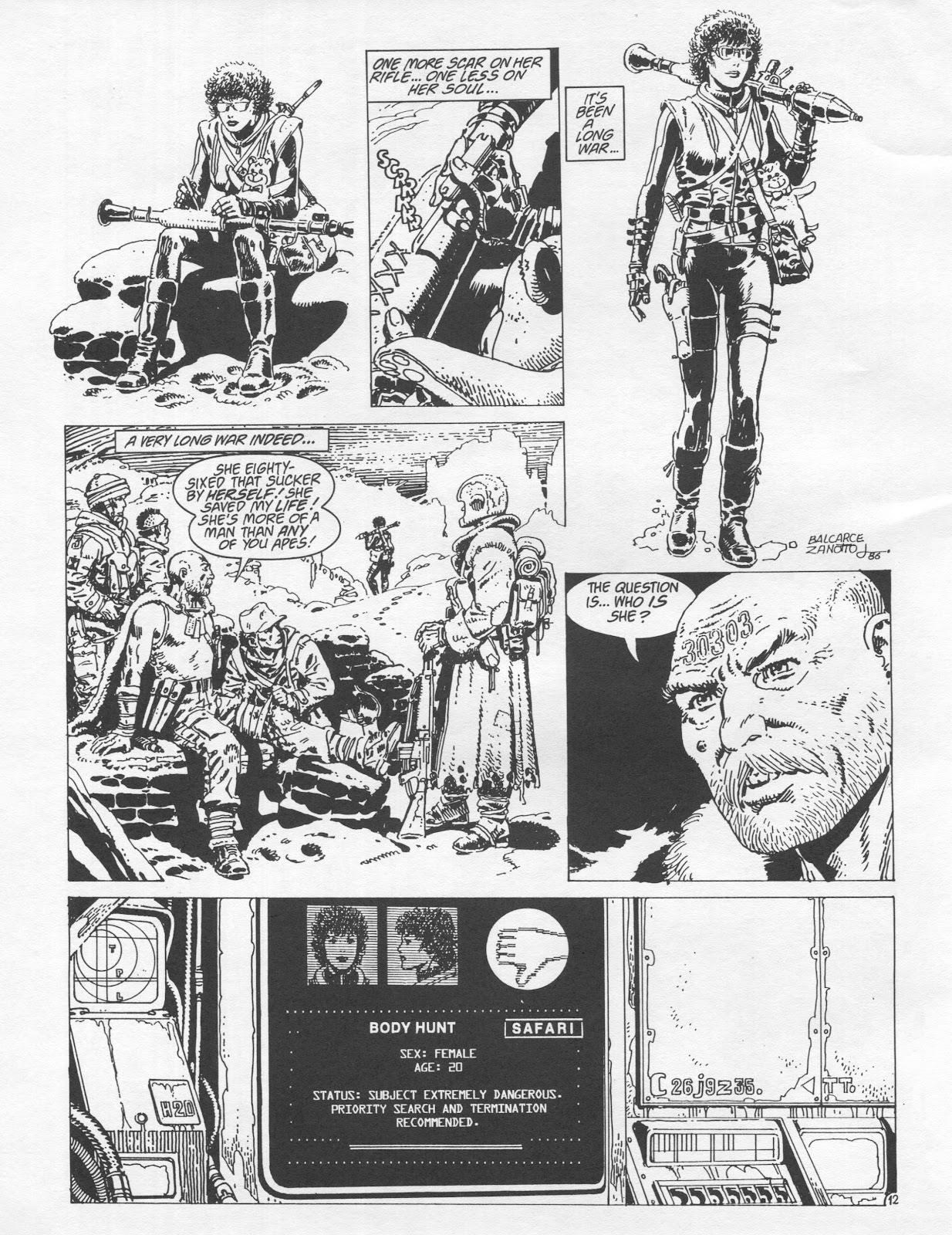 A resistance has risen, led by a man, known as Rust. He was captured, along with his wife, by slaver machines and tortured and forced to work on the assembly lines. However, he rebels and slowly sabotages production. He is tortured again and again, with each act of rebellion, until he is freed by an overseer, who sends his young son with him, to learn to rebel, as he reveals a data input, showing he is a pawn to the machines. Rust leeds a rebellion against the machines, hunting them down and destroying them. The woman, Safari, saves his life, but refuses to join him. He is hurt and loses a leg. he calls his son, Random to him and tells him the truth of his past. He taps him to take over as leader. Random is put through training, but is a screw up and lazy. His trainer tells the old man that he is his best trainee yet and sends him off on a hunt for a Centurian, a lower level machine. Random is followed by his girlfriend and a boy mascot, Bit. They come across dead hunters and learn this Centurian is more than they think. They are lured into an ambush, but rescued by Safari. 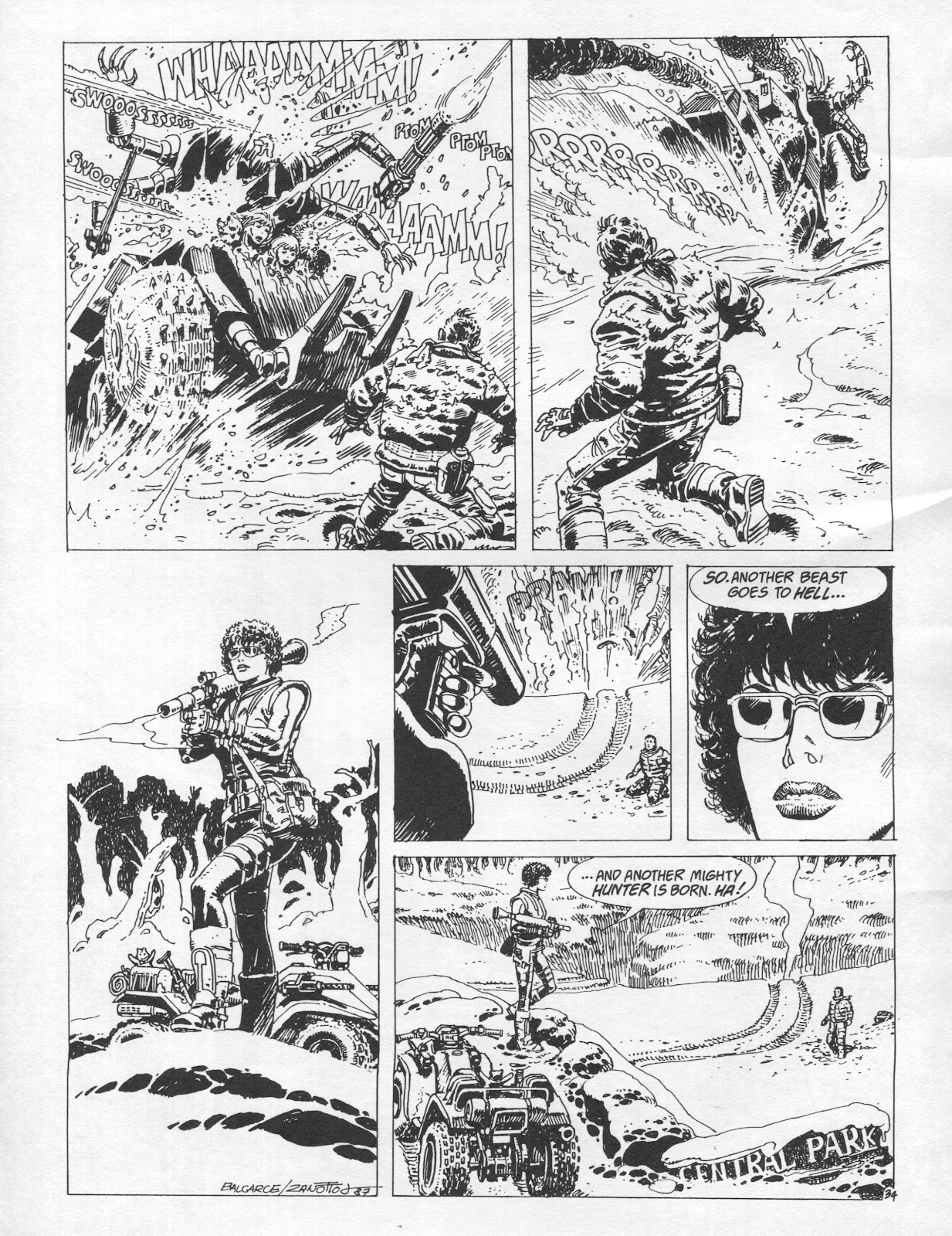 While the hunting party is gone, the Pawns, soldiers of Brain, attack the subway enclave and take the young women, to be brides for Brain. They get Safari, as well. Random tries to rally the people to help free them, but is left to go it alone. The women are bathed and dressed to replace Brain's past wives, who no longer please him. 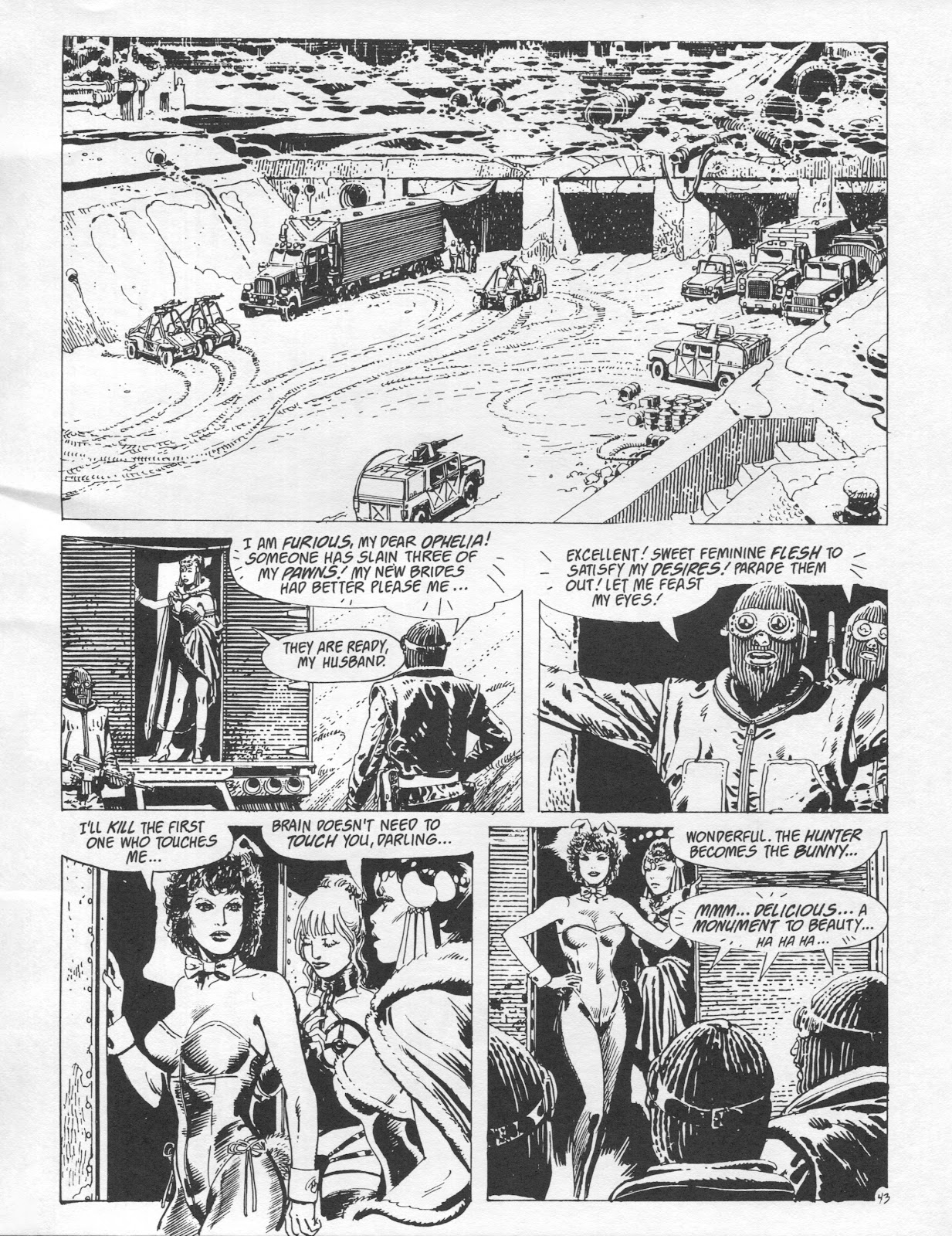 Random's father completes his education. After the war, their arose two powers: Brain and Neron. Neron controls the Lions and Centurians, his automated killers and slavers. Brain uses his android pawns, who speak with his voice. The pair play an elaborate game of chess with the human survivors and their toys. random goes to break the cycle. He rescues the past wives and learns where the new wives are held. he launches an attack, using Safari's tricked out quad bike, allowing the women to escape in a vehicle. They run from the Pawns, who pursue, but run into a Lion. Random orders them to veer to the right and the Lion's weapons intercept the Pawns' vehicle, destroying them. They escape and return to the subways, with Random cheered as a new hero and leader. However, we see that both he and Safari are just pieces in the game... 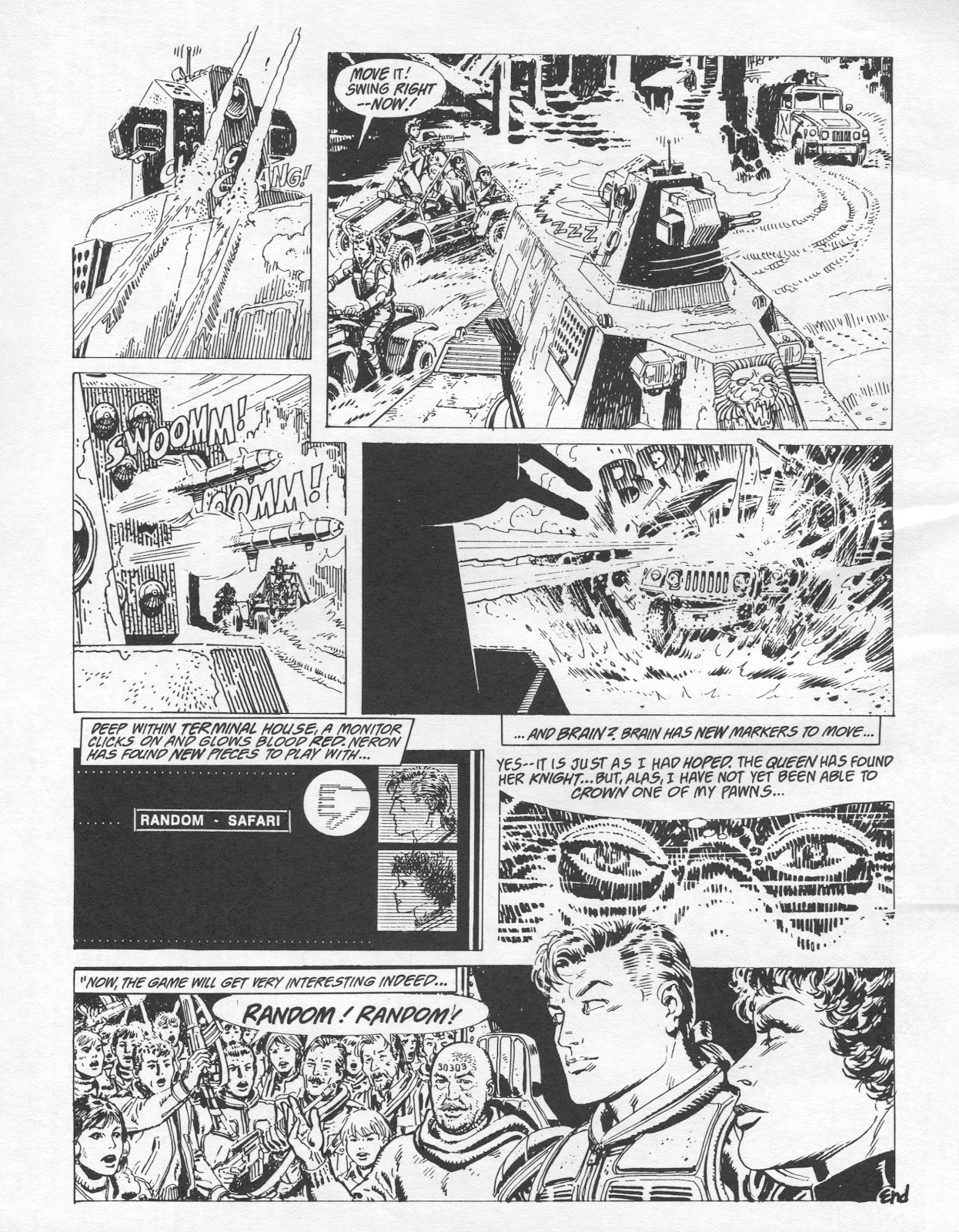 Thoughts: Thoughts: This is a bit more in keeping with a lot of material of the period of the late 80s; post-apocalyptic sci-fi. It is pretty much the type of thing you would have found in Heavy Metal, over the previous decade. Zanotto keeps the art exciting and realistic and you get the feeling of similar material in UK comics, like 2000 AD and others, which is probably because Zenotto worked for Fleetway for about a decade. This is Terminator, mixed with a bit of Colossus: The Forbin Project (which Cameron swiped from, anyway), some Mad Max, a bit of Spartacus and just about every post-apocalyptic film of the 80s you would find on a video store shelf (good or bad). Nothing groundbreaking or terribly awe-inspiring, but well done and entertaining. Safari is a bit exploitive, as both an early segment and the later "harem" segment take the opportunity to display her in sexy attire, though refrain from nudity. Eclipse also published the pair's New York Year Zero...  That did not carry the 4Winds banner, but had Chuck Dixon's involvement. Eclipse also published 4 issues of the magazine, Merchants of Death, which included work from Breccia, as well as a feature, Ransom, from Kurt Busiek and Dan Brereton (pencilling, rather than painting).  That magazine also was not a 4Winds production; but does feature Breccia's Soldier of Fortune (with Alfredo Grassi scripting) and historical adventures from Carlos Trillo and Jorge Salinas (with gorgeous, illustrative art). Attu Creative Team: Creative Team: Sam Glanzman-story & art; introduction by Stephen R Bissette Synopsis: 137 Million BC. the Kassar are a mountain people, forbidden to venture into the green sea below (the forest), for fear of arousing the Great Snake (a river). Lower down the mountain range is a cave, also considered taboo; but it entices a young man of the tribe, Attu. The guardians of the caves try to wave him away, but he ignores their warnings. He battles a guardian and wins and the others decide that if he wants to go in so badly, let him. Inside, he finds skeletal remeains and a fllor like ice, but warm to the touch. he then finds something even more amazing... 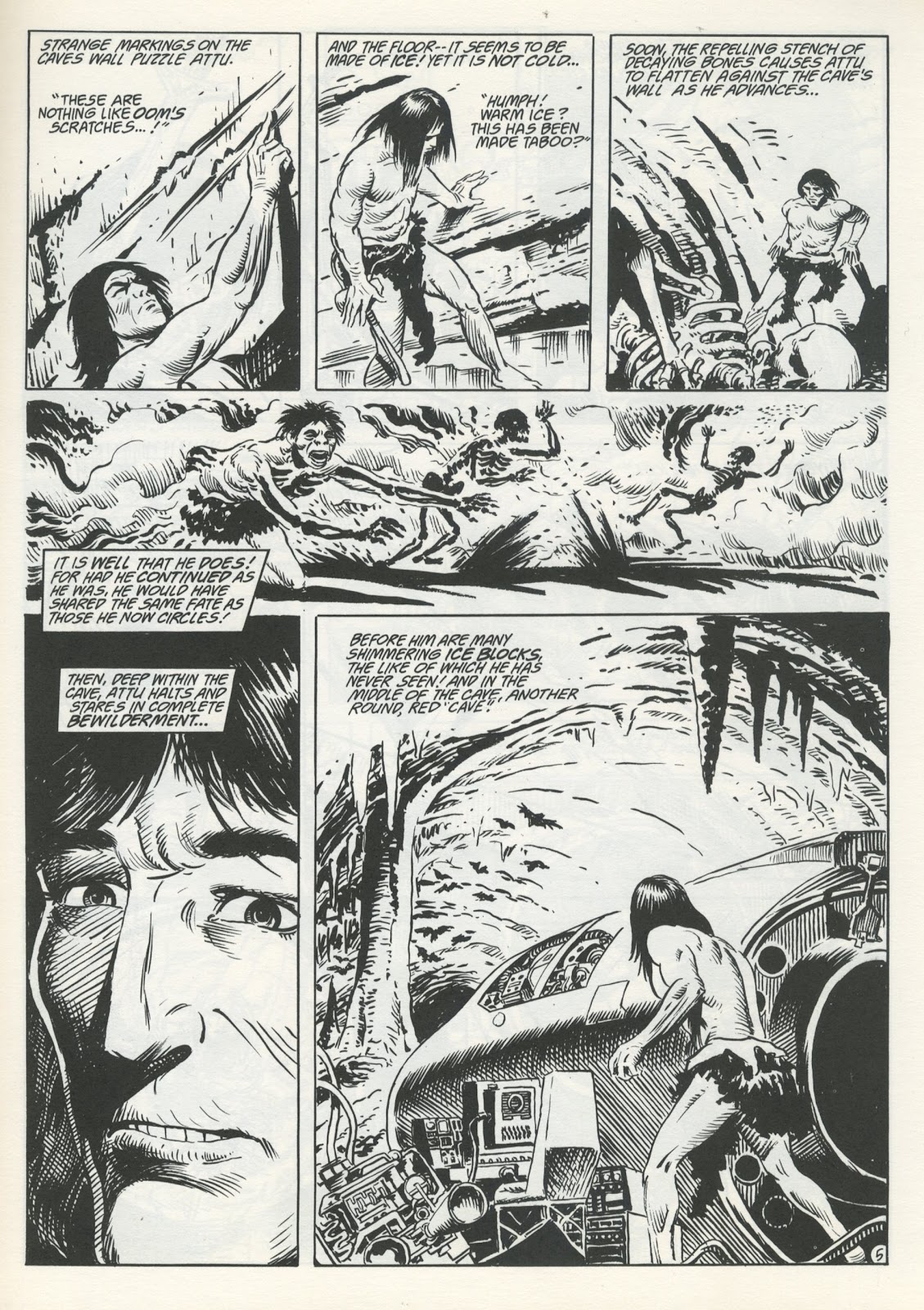 Next to the strange thing he finds weapons (tools) which will make him stronger. He sees a monster, but it does not attack, so he pokes it in the eye and it sticks its tounge out (he pushes a button and it ejects a tape). he pokes more eyes and pulls out more tongues, then smashes the beast over the head. He then climbs inside the opening, using a switch as a handhold. Inside the red cave, he sees his future, battling men and beasts. He leaves the red cave. he finds a woman encased in "ice" (a glass tube) but is unable to release her. he exits the cave and runs into a tiger, as in his visions. He fights and kills it with his tool. He is wounded, but a broken vial oozes a white fluid, which heals his wounds and makes him stronger... 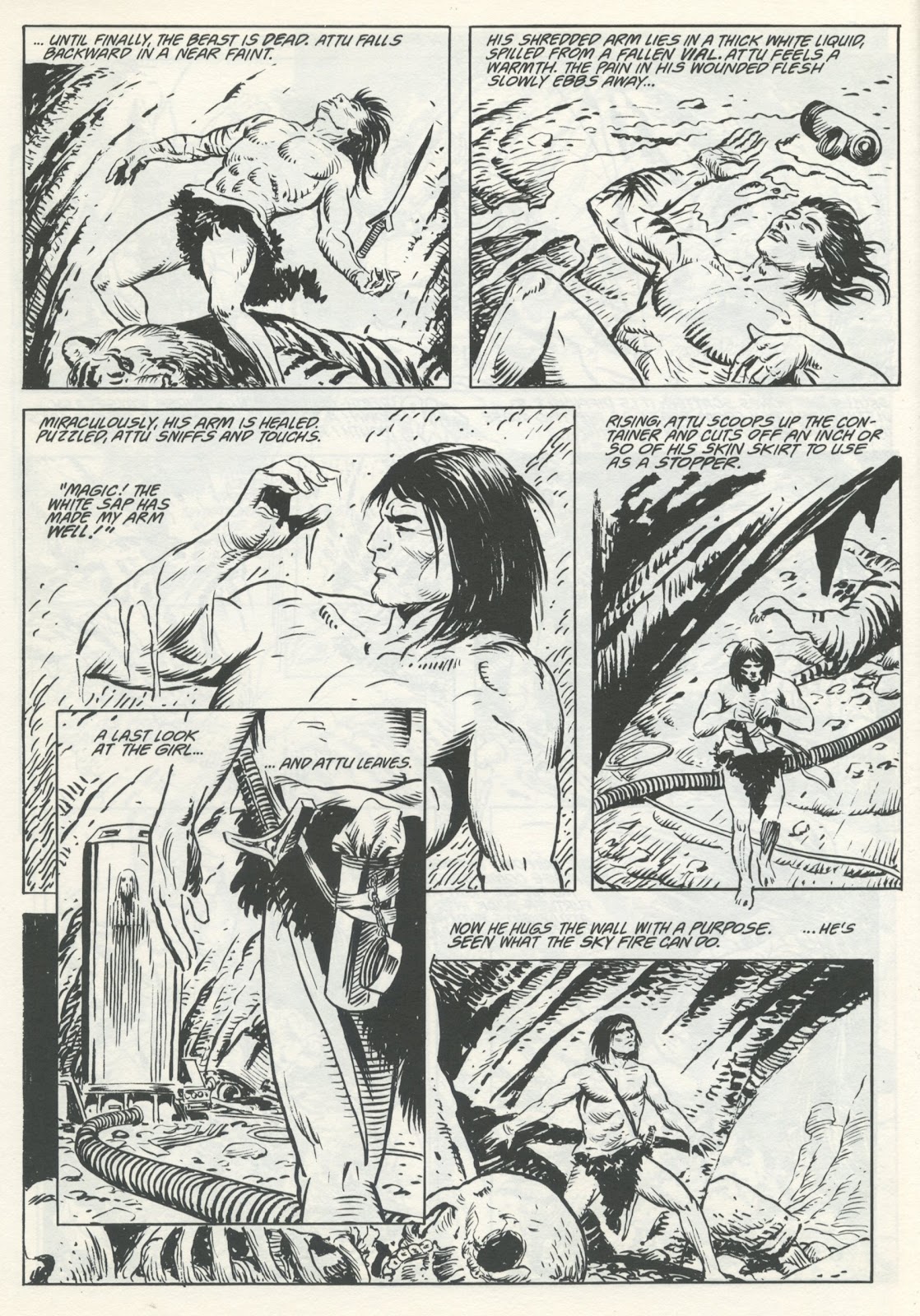 Outside the cave, Attu finds Oom, the wall-scratcher (cave painter), who is an outcast within the Kassar, as is Attu. Attu saved him from the elders and he has followed. Togetehr, they go below to explore the green sea. There, they find giant men and great beasts.... 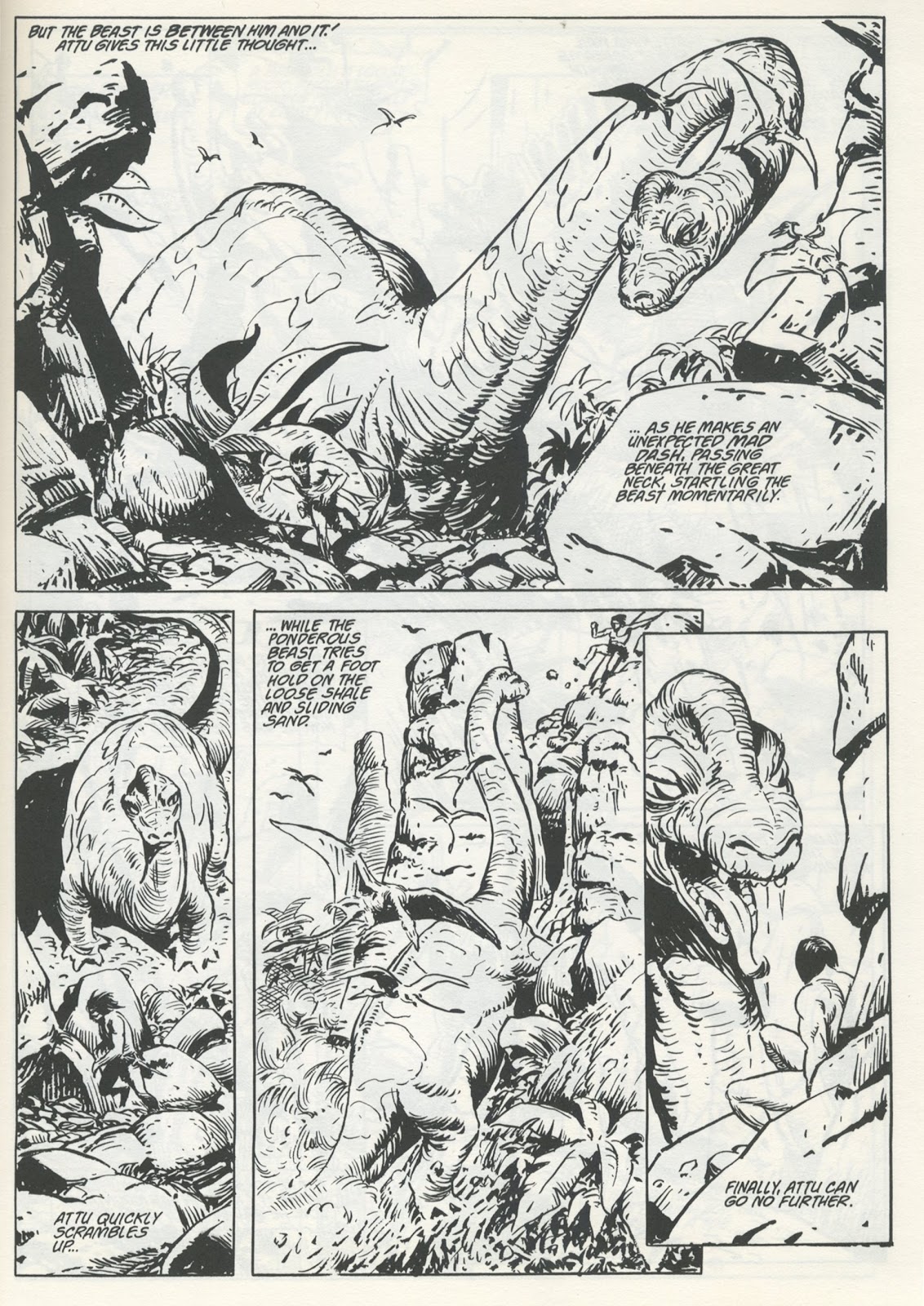 Oom is killed, but Attu survives and continues on. he escapes from a dinosaur and the creature chokes to death after catching its head in two pillars of rock. Attu climbs through mountains and stumbles on another cave, with an old man who schools him when he attacks. The man had his legs broken and learned to survive and adapt. He shows him strange dead men, in weird hides, who also had a walking stick weapon... 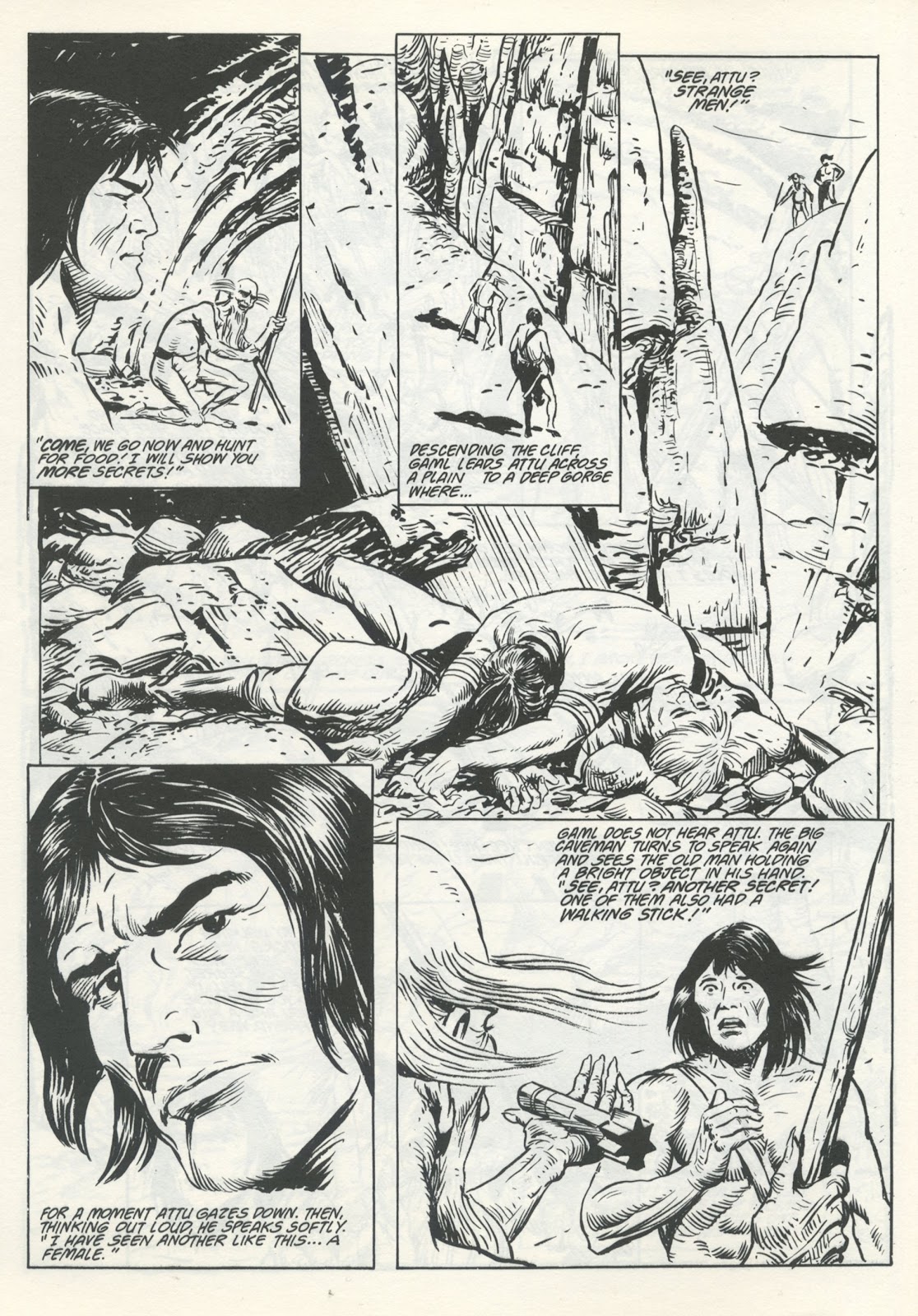 He encounters another tribe of hunter and another beast and is knocked over a cliff, but is saved when he grabs hold of a missile, embedded in the cliffside. he skins the dead beast and creates a hide protector for his body. He wanders on and comes to a lush valley and our story ends. Thoughts: This is a spiritual sequel to Glanzman's earlier work, Kona, Monarch of Monster Isle, from Dell. There, a prehistoric caveman, on an island left alone by time, saves an explorer and his daughter and joins their adventures. here, the caveman finds future technology that allows him to advance over his brethren, getting him into all kinds of scrapes. It's a bit simple in story, bo no less exciting. Glanzman is right at home with dinosaurs, cavemen and future technology. A second volume would follow....  ...but, I do not have a copy for review. Glanzman mixes Burroughs, Doyle, Harryhausen, Howard, Korda, and more, in this past-meets-future adventure. The last page previews more adventure to come, which seems to include Attu wearing a bra on his head... 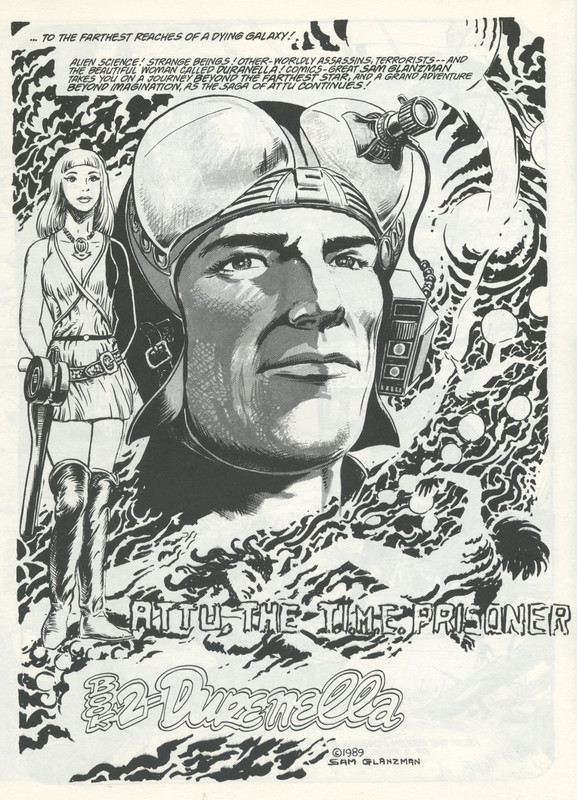 Sadly, this was the extent of the Argentine imports, as the financial state of Eclipse prevented further entries, though I suspect that was coupled with market indifference. Around the same time, several publishers tried importing other comics to the US market, with only Japanese manga showing any strength. Dargaud set up a US imprint and gave us Stan Drake's Kelly Green albums, along with a few entries of the Valerian & Laureline series, from Christin and Mezieres; but gave up soon after. Catalan Communications had a bit longer tenure, translating European works for the US market, in conjunction with Heavy Metal and Dark Horse's Cheval Noir. NBM had the greatest longevity, translating dozens of works with Heavy Metal, Cheval Noir and on its own, coupled with reprints of classic American comic strips, like the Hal Foster and Burne Hogarth Tarzan strips, Milton Caniff's Terry & the Pirates and Steve Canyon, and a few others. There have been other attempts, with Humanoids, Cinebook and EuroComics/IDW, as well as a smattering from other publishers, like Dark Horse and Fantagraphics. It is a rich world of material, if you feel bold enough to venture beyond the comfort of the superhero. Not all of it is as spectacular as Breccia or Pratt and some can't even rise to Zanotto or Zaffino; but, there is a lot of fine work out there, just as there is beyond DC and Marvel. Next: Tim Truman adapts Allen Eckert's Tecumseh. Then, we say goodbye to Tim and 4Winds with his interpretation of the pulp hero, The Spider. |
|
|
|
Post by codystarbuck on Jul 4, 2021 17:20:14 GMT -5
Tecumseh Creative Team: Creative Team: Tim Truman-adaptation & art, Valerie Jones-editor. Based on the play by Allan W Eckert So, this is an adaptation of someone else's work, rather than an original piece by Truman. Allan W Eckert was a writer of natural history books and frontier history, both as fiction and non-fiction. He was an interesting writer, who was born in Buffalo, NY and was raised in Chicago, IL. As a young man, he hitchhiked around the US, studying wildlife and living off the land. He wrote dozens of books for children and adults, specializing in natural history and the history of the Ohio Valley frontier, in the 1700 and early 1800s. He was a writer for Mutual of Omaha's Wild Kingdom (hosted by Marlin Perkins) and wrote over 200 episodes, winning an Emmy in the process. One of his most noted series was his "Winning of America, which features historical fiction about the westward progress from the early colonies, into the frontier region of the Ohio Valley and Kentucky and Tennessee. The series mixed historical figures, both Europeans and natives, as well as fictional characters, in a narrative of the growth of the nation. His work was noted for being fair to both the European and native perspectives and shedding less than favorable light on some figures in American history, about whom more legend than fact was perpetuated (as we will see here, with William Henry Harrison). In 1975, Eckert wrote the play, Tecumseh, which was produced in conjunction with the Scioto Society, in Chillicothe, OH. The play tells of the Shawnee warrior, Tecumseh, and his part in battles along the frontier, in attempts to reclaim Shawnee land, hold of the Europeans, and survive. It is this play that Truman, long a fan of Eckert, adapts, following on his previous Straight Up to See the Sky, an illustrated history of the Trans-Allegheny region, also published by Eclipse (which I have skipped, since I don't have source material). Truman continues his fascination with the early American frontier and his sympathetic portrayals of the native tribes, as they fight to hold on to their lands and way of life, in the face of European expansion. Truman did his research and the clothes, tools and weapons are authentically depicted. Artistically, this was Truman's last big hurrah, with Eclipse, though he still contributed one more series (The spider) and some art on another (Robin Hood, which I do not have source material, any longer). Synopsis: The story is told in retrospect, an elder addressing the young. 1783, and Tecumseh is 15, part of a war party, led by his brother Chiksika. They ambush a group of whites, who encroach on their land. The fighting is brutal and the whites are routed. The survivors are tortured and killed, as per tradition; but, Tecumseh staps Red Horse from continuing against one man. 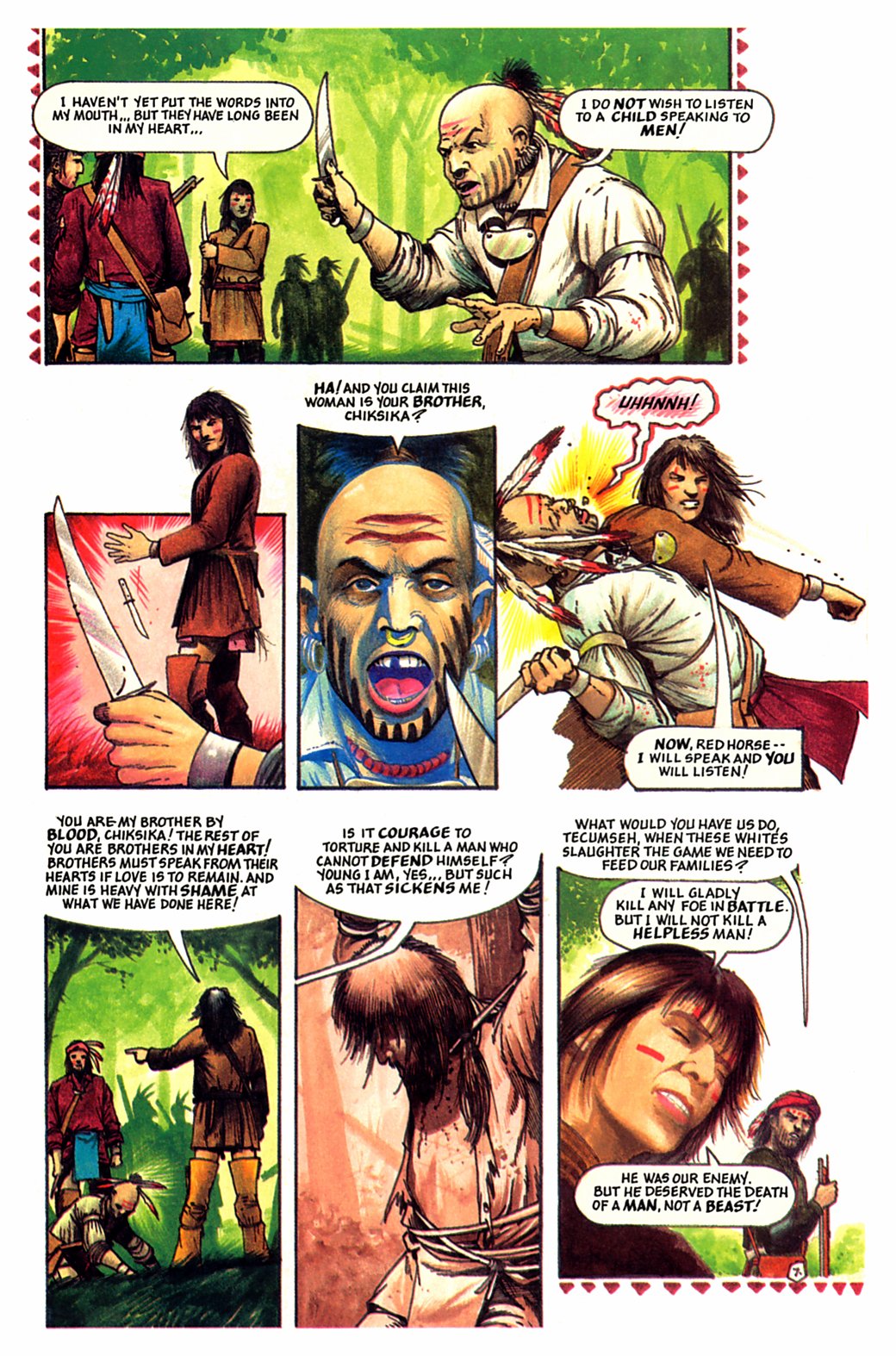 Tecumseh wins over the others and they vow to discontinue the practice or torture before death, for their enemies. Elsewhere, the leader of the survivors and the expedition, Simon Kenton, stops a man from scalping a prisoner they took. The man is dying and speaks of Chiksaka and Tecumseh. Kenton is acquainted with Chiksaka, and learns of Tecumseh. In 1787, the Shawnee move northwest, away from the whites. Tecumseh stays behind, to stop their advance. Elsewhere, in Kentucky, a native arrives at Kenton's Station, while a wedding goes on. He flies a white flag, but is greeted with hostility, until Kenton intercedes. He recognizes the man as Blue Jacket. He was sent by Tecumseh to broker a prisoner exchange. They arrange a meeting place for a swap and Kenton expresses hope of a lasting peace. Blue Jacket admits his people are tired of war. At the village of Chalahgawtha, Tecumseh returns home to see his sister and little brother, who has become a man and will take his place with the council. There, they debate the exchange and the chance of peace. Tecumseh opposes peace, so long as the whites continue to occupy Shawnee land. 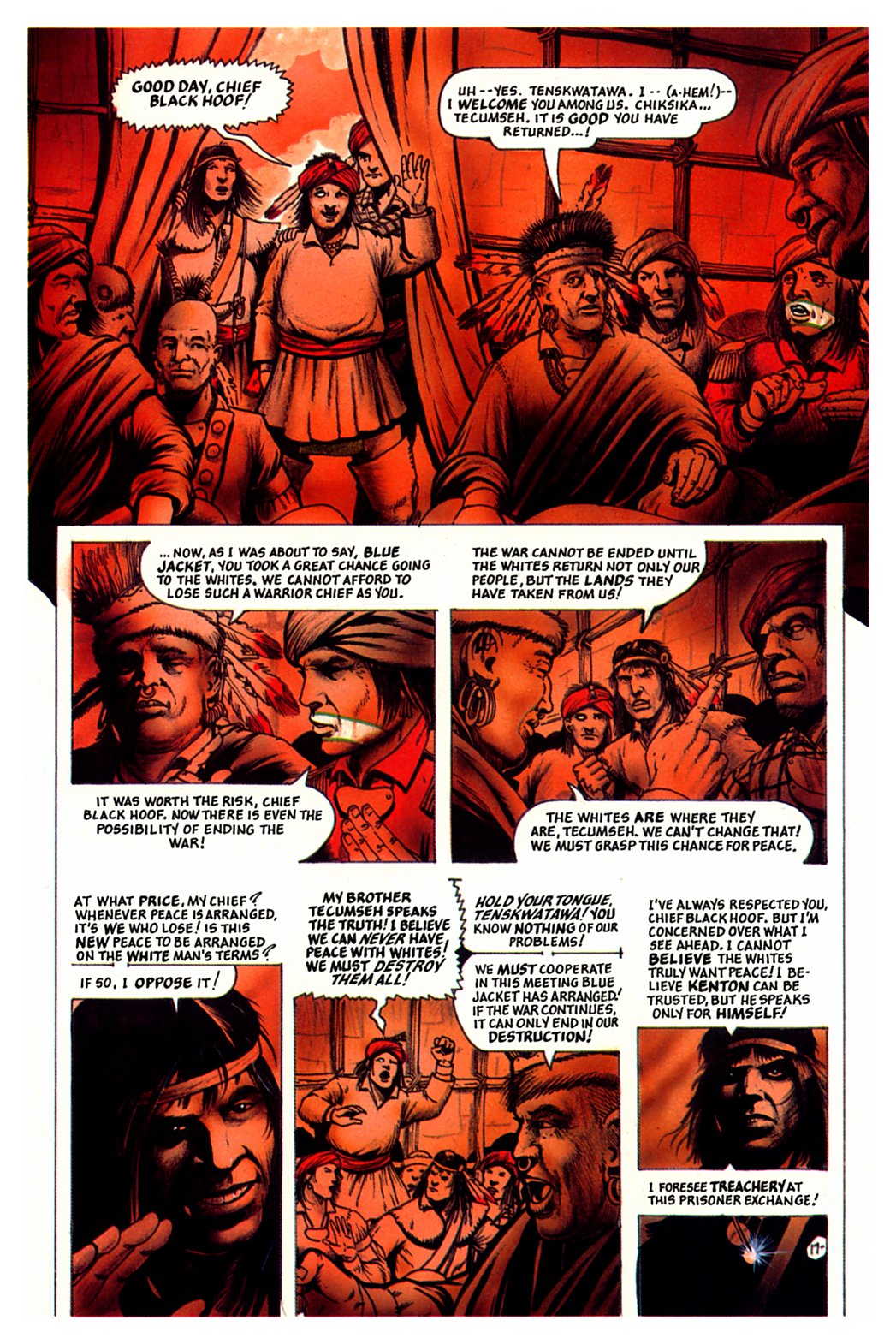 He predicts treachery at the exchange. The council sees the opportunity in the exchange and Chiksika says they must trust at some point, to ever have peace. Tecumseh is placed in charge of the exchange, since he will be most alert to treachery. The meeting occurs and tempers are hot. Kenton meets Tecumseh and remembers him from the fight, back at the river. he lets it go and tries to keep the white contingent in control. the exchange is made. They are interrupted by news that white men have stolen there horses and are swimming them across the river. Fighting breaks out and Chiksika is hit and dies. Tecumseh is hardened against the whites and becomes a terror to them. The fighting continues, until 1791. 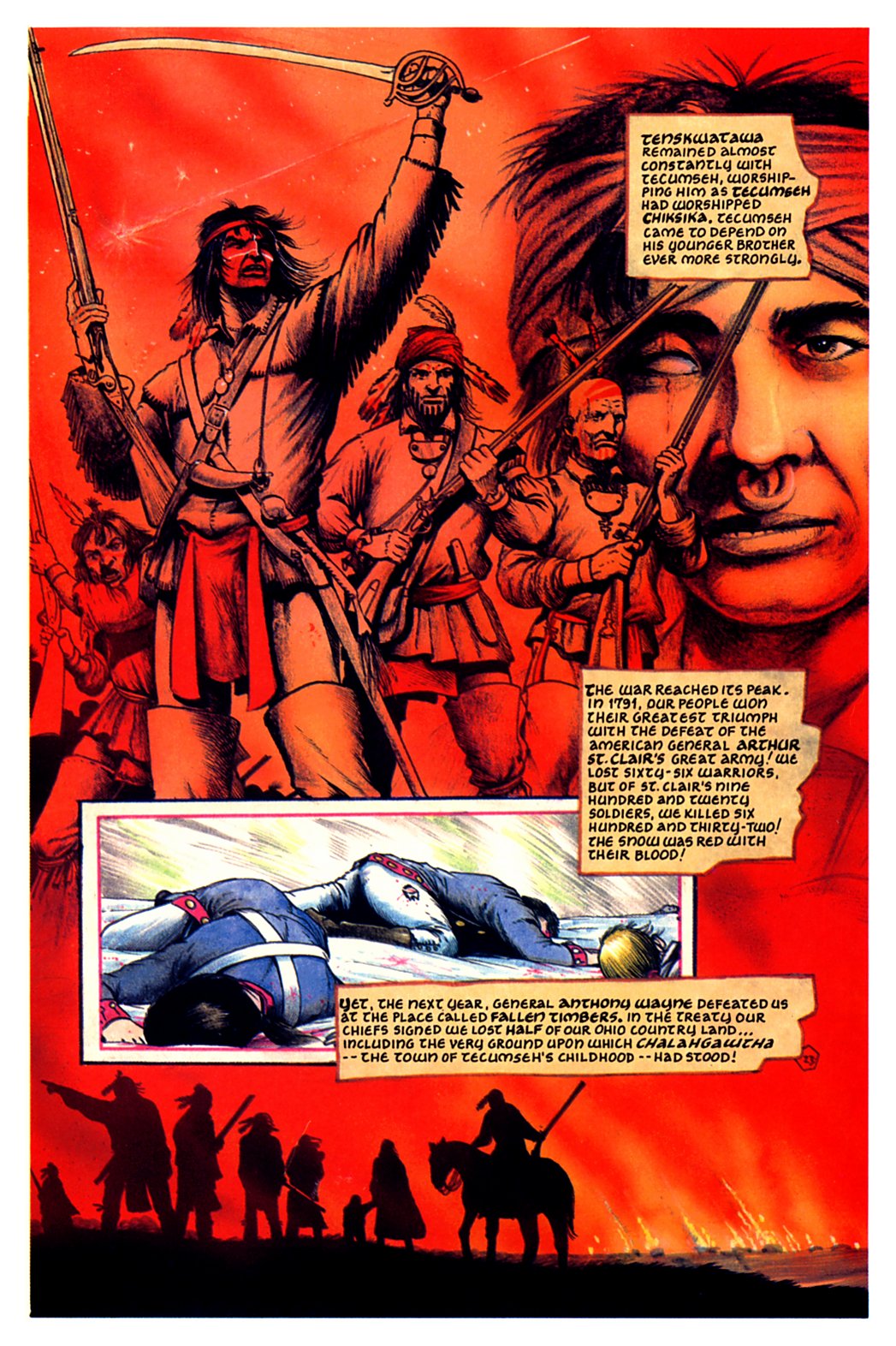 A great victory is won by the Shawnee, with St Clair's defeat, as over a hundred of the general's men are killed and their forces withdraw. However, Gen Anthony Wayne wins a victory at Fallen Timbers and a treay is brokered, taking half of the Shawnee land, including Chalahgawtha. His people move on, but Tecumseh stays behind, with a small band of followers, vowing to continue the fight. In 1797, Tecumseh, visiting the ground of Chalahgawtha, meets James Galloway and his family, including daughter, Rebecca. Galloway was part of George Rogers Clark's group that burned down the village, but decided he wanted his family to some day live on that land. Tecumseh surprises them. They speak of the land and Galloway's love of it impresses Tecumseh and he makes friends with them and promises they have no fear from the Shawnee. he seems especially taken with Rebecca. he leaves them to rejoin his people. 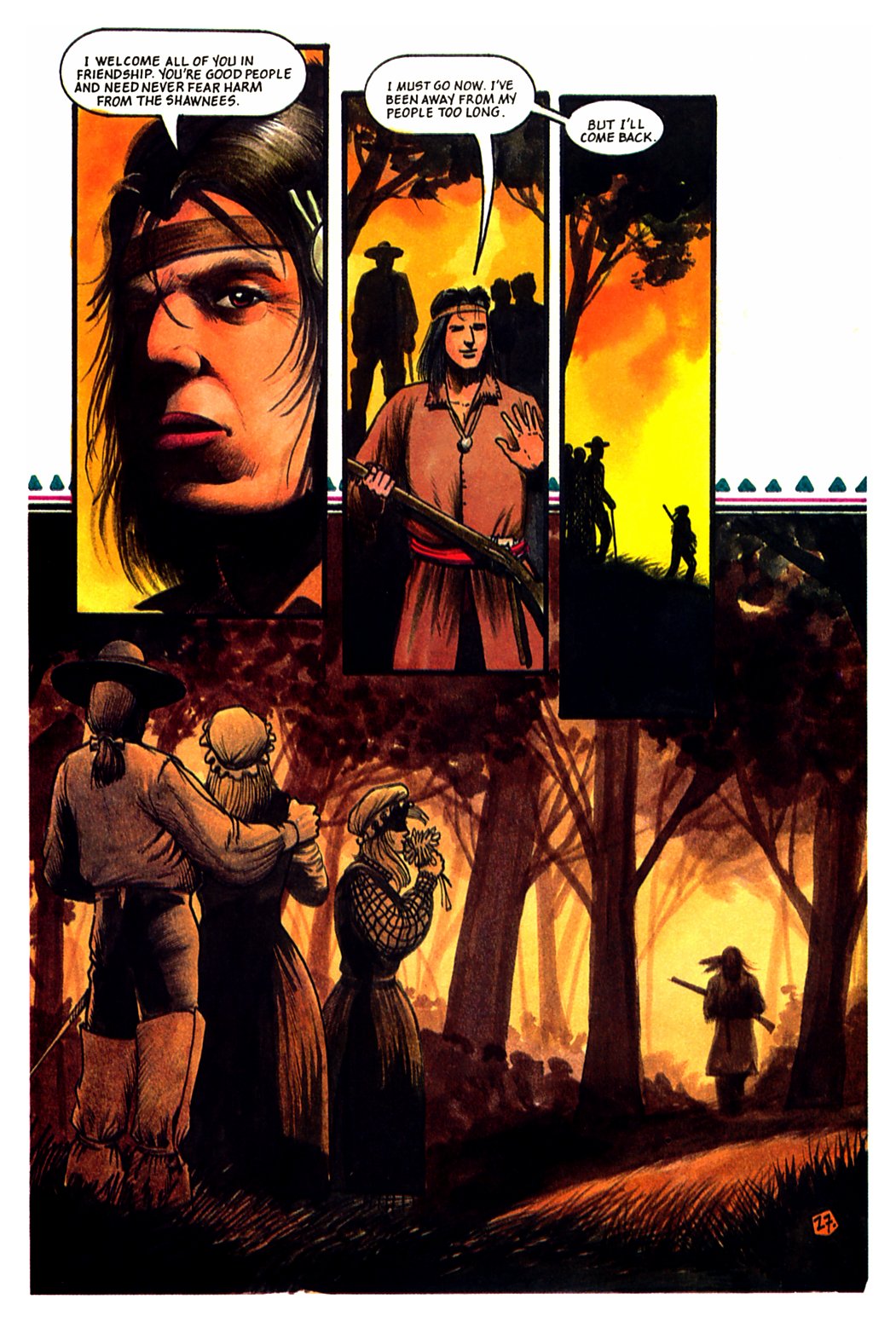 In Indiana, Tecumseh prepares to go on several long journeys to put his plan to retake the Shawnee lands. He leaves his brother, Tenskwatawa, in charge. To give him authority, he passes on prophecies to share with the people, which he assure him will come true. he warns the brother to do nothing to raise the ire of Governor William Henry Harrison, who governs the territory from the fort, at Vincennes. He is wary of Harrison, who understands the natives and would wipe them out, if given justification. 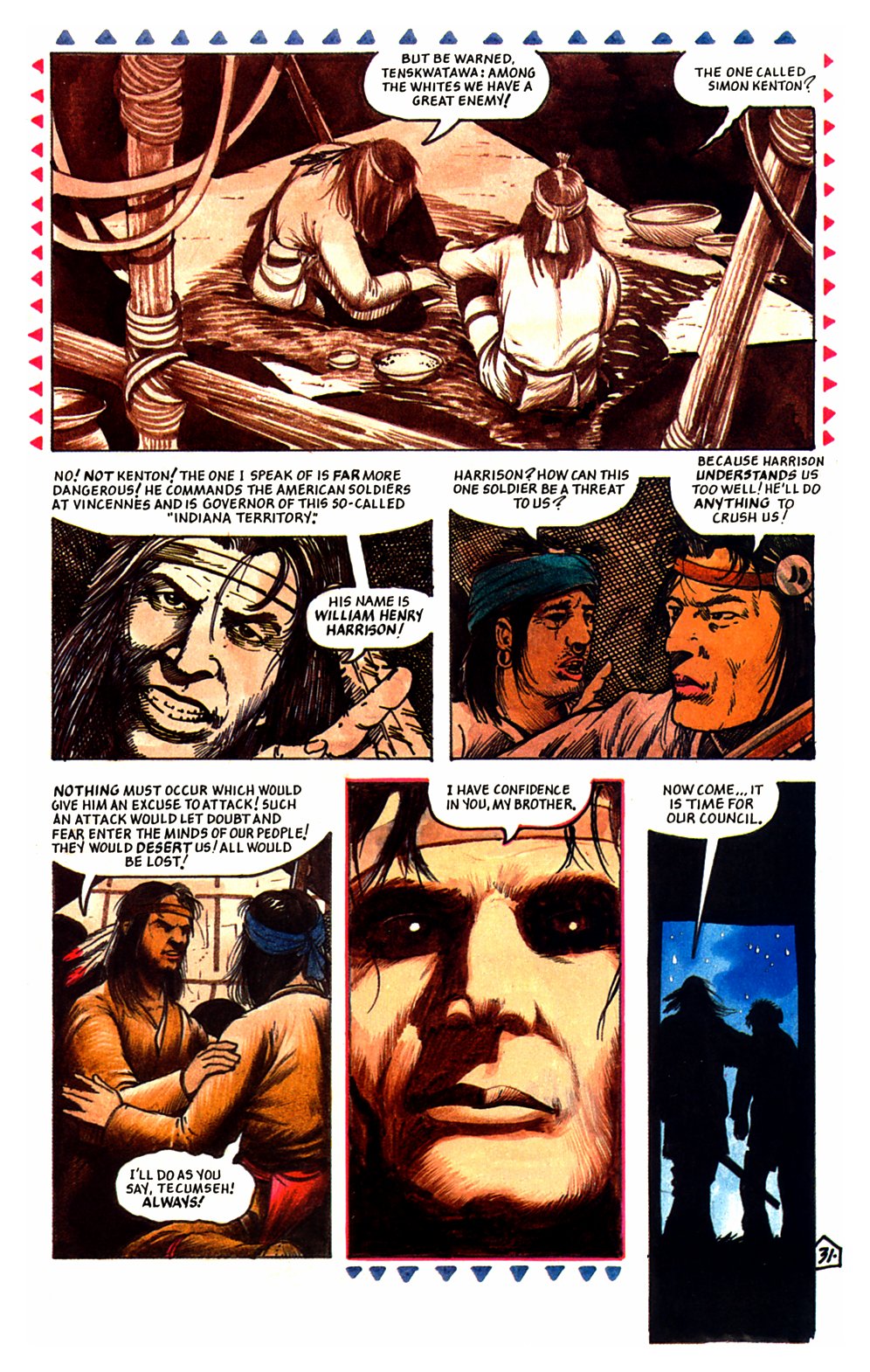 Tecumseh addresses his followers, telling them of his mission to raise a great alliance of the tribes, create a native army to drive the whites out. He will bring them to their place, Tippecanoe. 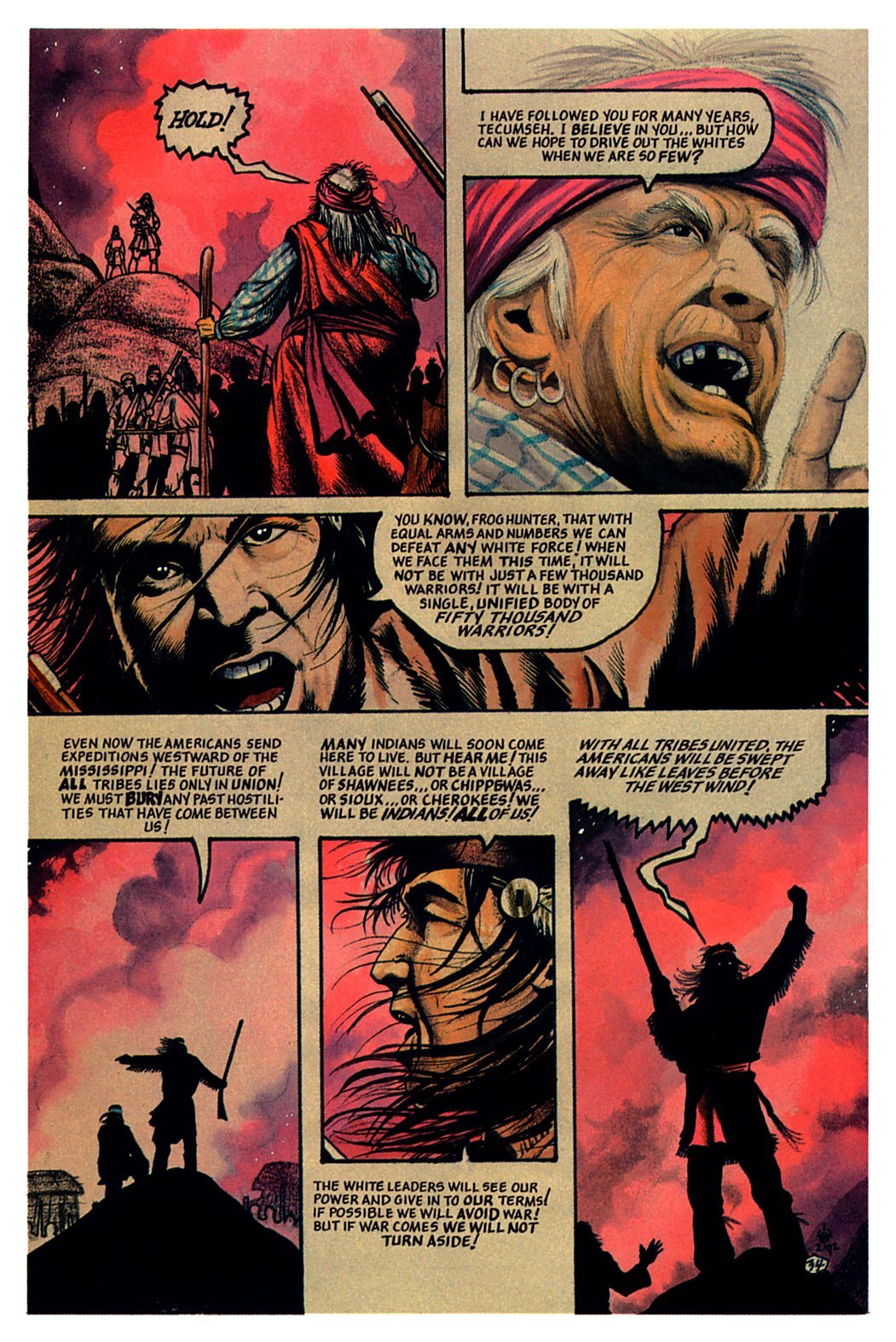 At Vincennes, Harrison receives intelligence about Tippecanoe. The prophet speaks of peace, but Harrison is worried by the growth of the village and the absence of Tecumseh. A captain questions his political ambitions, pointing out that critics say he would greatly benefit, politically, by an outbreak of war, which he doesn't deny, but then says Tecumseh is dangerous and is building an army to create an empire that could stretch across the Americas, rivalling the empires of Mexico or Peru. he receives news of a scout, Simon Kenton. He tells Harrison of meeting a chief in Alabama, where Tecumseh was cited, and said he is stirring tribes, from the Iroquois to the Ottowa, the Sioux, Shawnee and more in between. He fears what he might accomplish. Tecumseh visits the Galloways. He takes Rebecca on a moonlit canoe ride and they speak of the future. Tecumseh loves her, but is afraid that a marriage would not be received well on either side. He departs. Tecumseh returns home to find Tenskwatawa has been corrupted by his power and has executed 3 rivals. Tecumseh is angered. he warns his brother. He then goes off to meet with Governor Harrison.. They argue over lands in Indiana. Harrison claims they were rightfully bought from the chiefs of the Miami, but Tecumseh says they had no rights over those lands and claims to speak for a united native people. Harrison debates, saying that if the indians were one people they would speak with the same tongue, but Tecumseh counters that Americans are English, German, French, Spanish and Dutch. Tecumseh smashes the gifts of the Americans and berates the leaders of the Miami. Tecumseh brings out the Wyandots, whose lands are in question. They belittle the Miami leader. Tecumseh warns them to leave. Tecumseh goes off to make more alliances and Tenskwatawa sends out a raid to steal horse and cows, giving Harrison the excuse to send a reconnaissance in force. His orders from Washington forbid a direct attack on Tippecanoe, but he drew out Tenskwatawa. He stirs up the warriors to attack the whites, saying they will be invincible, that he has forseen it. They are slaughtered and Tecumseh returns to find his people dead. Tecumseh berates his brother, for destroying his alliance. His allies are gone and fear controls them. He has destroyed everything in a day. He drives his brother out... 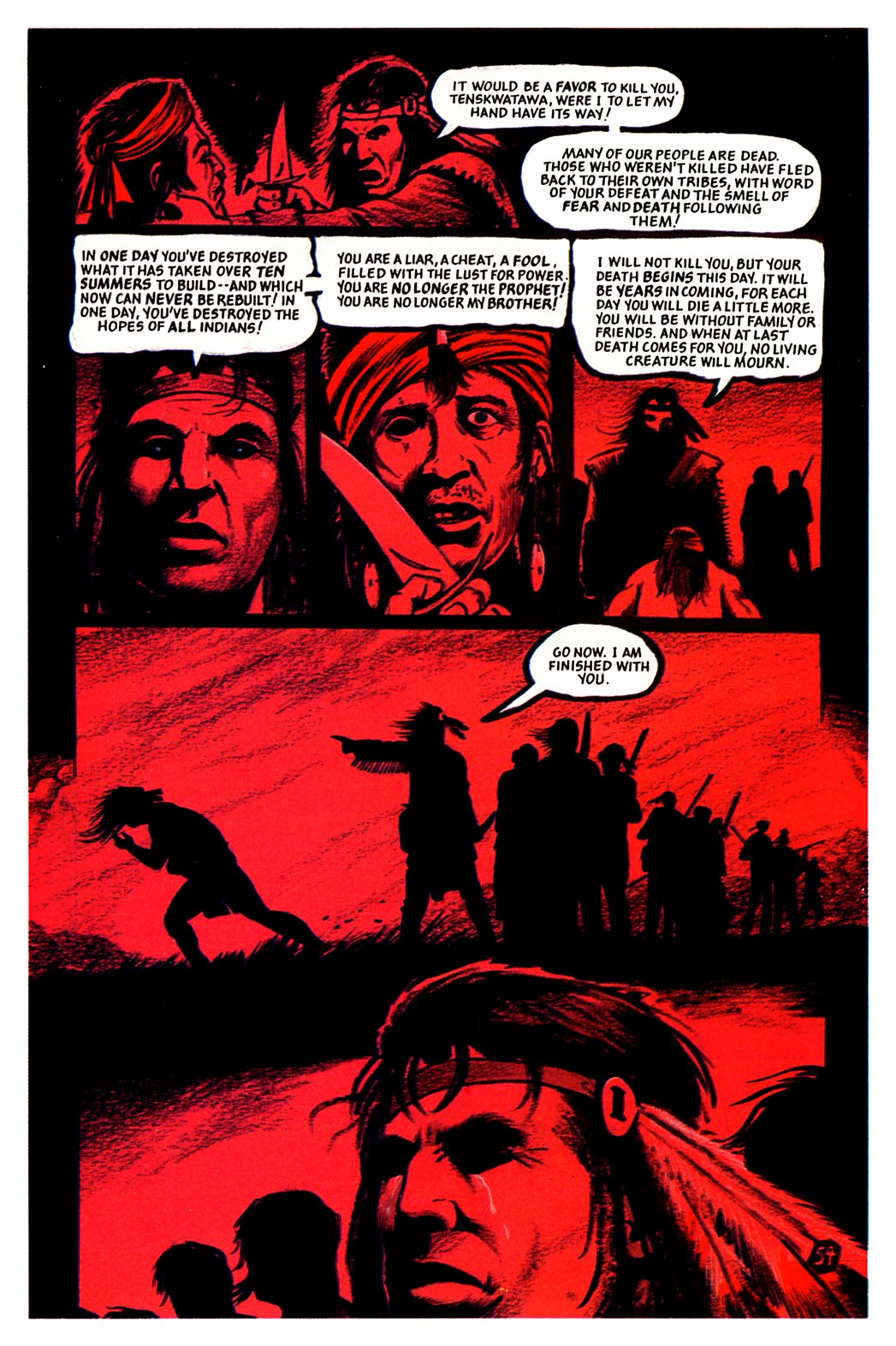 On December 16, 1811, as Tecumseh predicted, a massive earthquake shakes the region, actually causing the Mississippi to reverse its flow. Tecumseh calls his alliance together, but there is only 2,000, not the 50,000 he predicted. They make an alliance with the British, as the Americas go to war with England, again. They are gathered near Thames River, in Ontario, under the command of British general Proctor. Tecumseh is tired of his constant running from a fight with Harrison and demands the stand and fight or he withdraws his forces. proctor needs the men and relents, but Tecumseh doesn't trust him. On October 5, 1813, the two sides meet at the battle of Thames River. 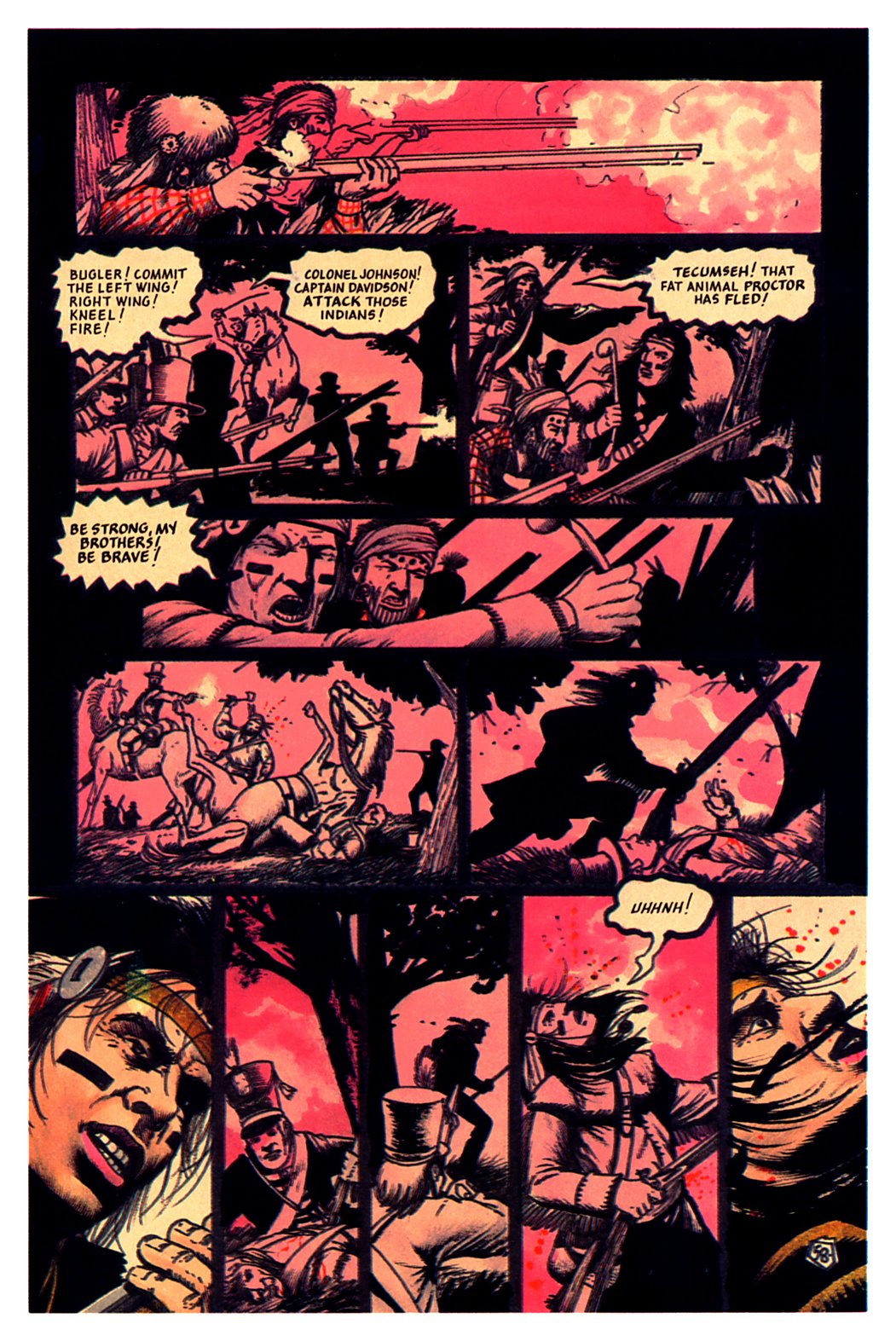 Tecumseh is hit and the native flounder and run. Harrison and his men move in and he has Simon Kenton look among the dead, for Tecumseh. he deliberately misidentifies the body, so that the butchers can scalp him and take souvenirs, then finds the real Tecumseh and gives him a proper burial. Thoughts: Eckert's play mixes fact with fiction, creating conversations and expressions for which there is no record. It makes for great drama, but has been a chief criticism of him, as a historian. This is a drama, relating the story of Tecumseh, one of the most feared figures of the frontier wars that followed the American Revolution. Tecumseh was rumored to have visions of the future, which often came to pass, though how much is true and how much was embellishment in the retelling is open to interpretation (assuming you even believe in the possibility of seeing into the future). What is true was that he was a very influential leader who did broker alliances between rival tribes, against the common enemy of the European settlers. he was not alone in this, as Pontiac's Rebellion and the Northwest War featured alliances against the whites. however, Tecumseh was a very skilled builder of alliances and a great motivator. William Henry Harrison had served under Gen Anthony Wayne, in the Northwest War and had political connections in Congress and won an appointment as governor of the Indiana Territory. He was a Democrat and ally of Thomas Jefferson and James Madison both reappointed him as governor, giving him wide ranging powers to negotiate the purchase of lands from the natives, for future settlement. He made large purchases from the Miami tribe and pushed them through quickly, so they would be in force when Jefferson left office. He was also a proponent of slavery within the Indiana territory. he was blocked from instituting it in the territory, due to large anti-slavery sentiment. He did meet with Tecumseh, and squabbled over the rights of the Miami to sell the land. Tecumseh led a rebuttal of Harrison, but not in English, as depicted and an ally of Harrison cocked a pistol as a warning that Tecumseh was stirring up the natives to fight. Some claimed that Tecumseh was urging them to attack and kill Harrison. When the soldiers drew swords and fixed bayonets, Tecumseh backed off, but the die was cast. Harrison gained orders to move against Tippecanoe and put an end to the Confederacy, and used Tenskwatawa's delusions to egg him into battle, slaughtering the natives and burning the village to the ground. tecumseh's confederation broke apart. Tecumseh did aid the British against the Americans and Harrison commanded troops in the region, winning the Battle of Thames River, one of the few major American victories in the War of 1812, second only to the Battle of New Orleans (which occurred after the signing of a peace treaty, unknown to both commanders). Tecumseh was killed in the battle and his body mutilated. Harrison used his victories at Tippecanoe and Thames River to build his political career. He ran for the presidency in 1836 and again in 1840, winning the office, but dying one month into his administration, setting off a constitutional crises about the succession. Tecumseh became the stuff of legends and much that has been written is based on folklore, as much as documented record and the records are tainted by POV. To the natives, he was a great warrior and leader and Eckert captures that image of him and suggests the elements of the legends, while keeping things to the events, with dramatic embellishment. Truman sticks to the story and dialogue of the play, while filling his pages with period-authentic clothes and weapons and the beauty of the Ohio Valley, in its unspoiled past. He handles the politics of both sides and tries to humanize the man, though with Eckert's words as a guide. The art is fantastic and Truman handles it all, including the lettering and coloring. It is a rich work of drama and history and a fine companion to both Wilderness and Straight Up to See the Sky, while also continuing his work on Scout, in presenting native heroes. Truman is always respectful and presents the native characters as people, not legends. You see real personalties, humor, personal quirks; never the stereotype of Hollywood. The story is perhaps not quite as rich as Wilderness and the latter's stark black and white images have a real power to them. Still, Tecumseh succeeds as an important piece of work, both historically and artistically. Next, we close out our looks at Tim Truman's 4Winds with his last series for Eclipse: his adaptation and updating of the pulp hero, The Spider.
|
|
|
|
Post by codystarbuck on Jul 10, 2021 18:43:15 GMT -5
We now come to the final project to discuss, with Tim Truman and his 4Winds imprint: The Spider.   The Spider was a pulp hero, created in 1933, by Harry Steeger, the publisher of Popular Publications. He was intended to be competition for the Shadow, but Popular didn't do things by half. The Spider is Richard Wentworth, veteran of WW1 and a wealthy man, living in a large mansion, within the city. He is aided by his manservant, Ram Singh, a Sikh, who is deadly with a knife, as well as girlfriend Nita Van Sloan. He wears a cloak and fright mask to terrorize criminals, though he was usually depicted wearing a black domino mask, on covers (and started out with that disguise, in the earliest stories). The Spider's stories were wilder, more violent than the Shadow, killing enemies left and right, while they, in turn, slaughtered countless innocents. The Spider would carry his seal, hidden in the base of a cigarette lighter and would imprint his symbol on the foreheads of criminals, long before the Phantom and his Skull Ring. Popular wasn't averse to doing serials (especially their Operator 5 series, which had long storylines, like the Purple Invasion) and the Spider had a 3-part epic, The Black Police Trilogy, across issues 60 to 62. In it, a Fascist group takes over the government of the State of New York and unleashes a wave of terror, as citizens are rounded up and executed, as well as hauled off for slave labor. the Spider and Nita join with others in fighting this group, ultimately battling to the State House. It was later colelcted and reprinted, in 2009, as The spider vs The Empire State. The story was a deliberate allegory to the Nazis, in Germany and the originals were published, in 1938, before the outbreak of war. The bulk of the stories were the work of writer Norvell Page, who wrote 90+ of the 119 stories in the hero's cannon. The stories carried the house name, Grant Stockbridge, and the first two were written by Reginald Thomas Maitland 9RTM) Scott, but they were slow paced and lacking in the violence and action that Page gave them and he took over with the third issue. He churned stories out, month after month, until suffering a nervous breakdown, necessitating a 9 month layoff from the series. The character was soon adapted for the screen, by Columbia Pictures, who produced 2 15-chapter movie serials. Page contributed to the script for the first, The Sider's Web, where he fights The Octopus (not the Spirit's enemy) and his gang, as the attempt to sabotage interstate transport. The characters of Nita and Ram Singh are there, with the hero. He returns in The Spider Returns, fighting the Gargoyle and a gang out to sabotage the US Defense network. On the serials, they departed from the cover images of the Spider, as well as anything like The Shadow, and gave the hero a stylized cloak and mask....  Look familiar? Stan Lee remarked that the creation of Spider-Man was somewhat inspired by the pulp hero, the Spider; but, what he meant was more the movie serial version, as the parallel to Peter Parker's costume is obvious. The Spider was revived in reprints, in the late 60s, and again in the late 70s; but, the covers were designed to make him look like the other men's adventure heroes on book racks, like the Executioner and The Destroyer...  Within the novels, the stories were reprints, but edited and updated to sound more modern, changing vehicles into modern sports cars. DC had recent success with a revival of The Shadow and less with Doc Savage, but that wasn't entirely the inspiration for this series. At the same time, the rights holders were working with Carrol & Graf publishers to reprint the Spider stories, in 2-story volumes. These were published at about the same time as the first comic series and proved popular enough to produce 8 volumes, over 2 years. 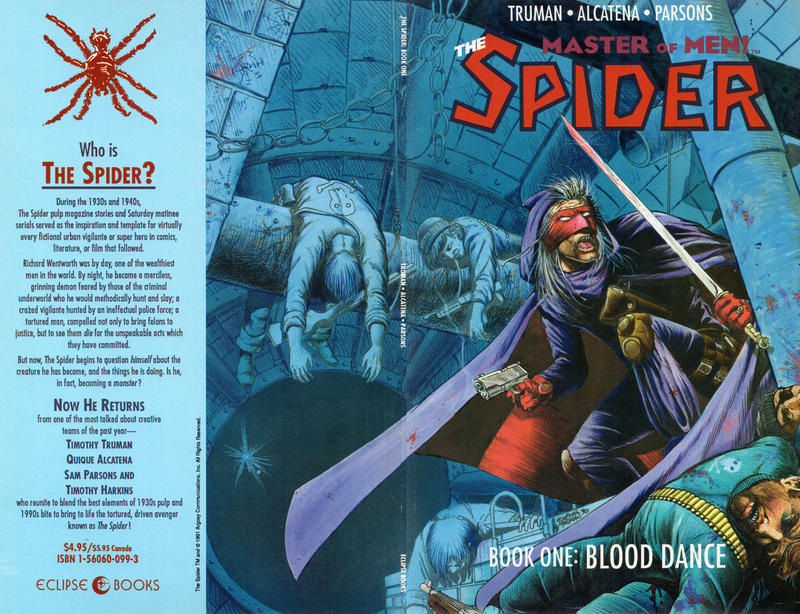 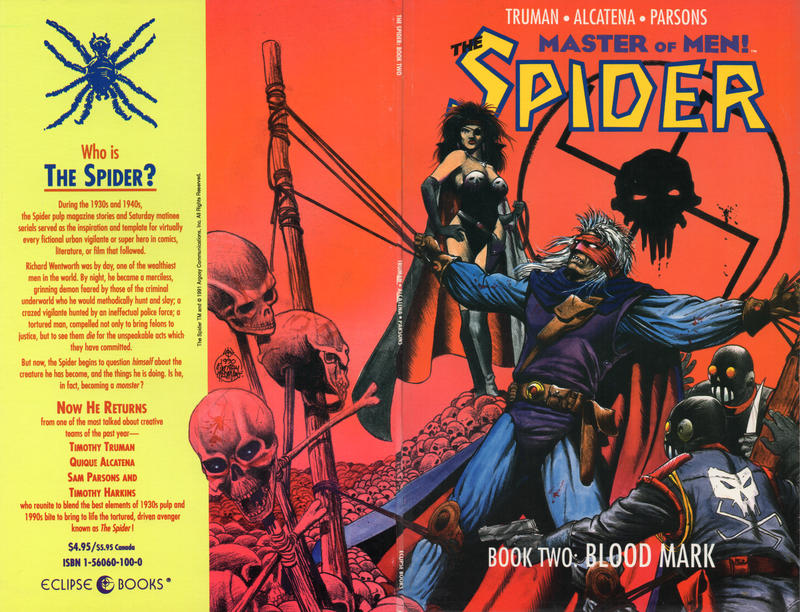 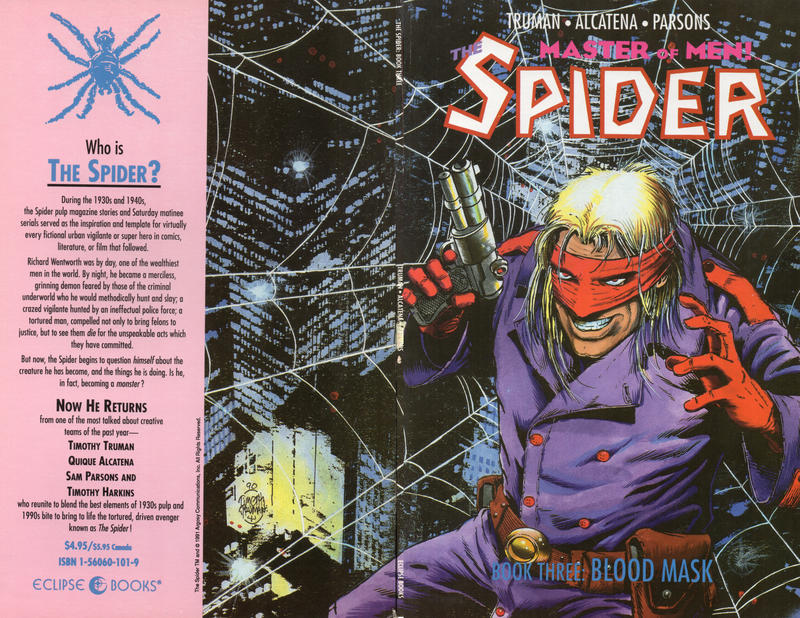 Creative Team: Creative Team: Tim truman-story & pencils, Quique Alcatena-inks, Tim Harkins-letters, Sam Parsons-color, cat yronwode-editor Partially inspired by "The Corpse Cargo" (the Spider V3, #2, 1934, by Norvell Page, as Grant Stockbridge) Synopsis: The story is set in the 1990s, as seen in the 1930s. Thus, technology has grown, but the depravity of the world is still much as it had been in the 30s. The first chapter finds The Spider hunting down an orphan kidnapping ring and he isn't squeamish about ending their efforts, permanently... 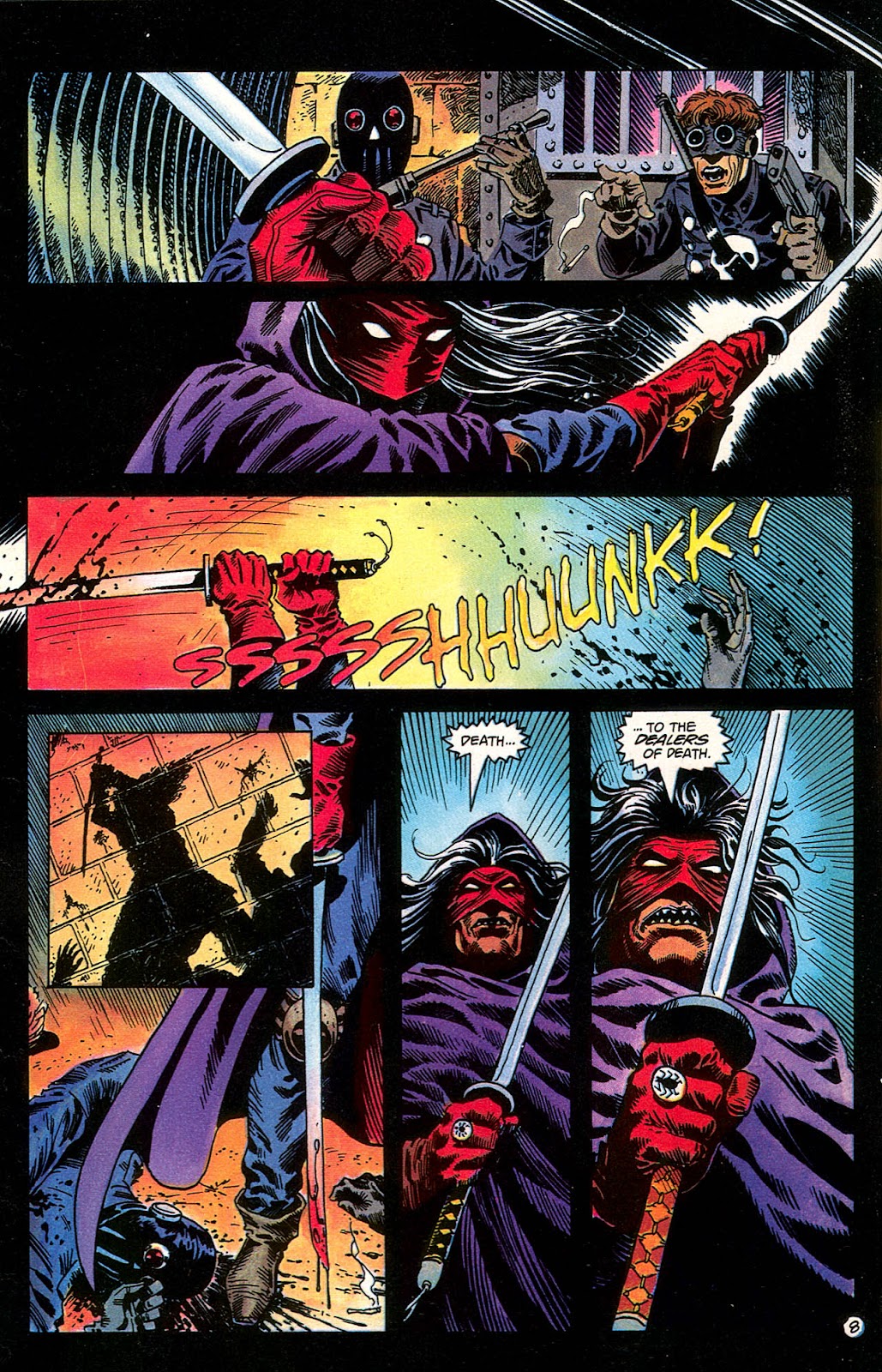 He discovers some kind of death cult, with a kidnapped boy about to be sacrificed in a ritual, which includes an electrified ceremonial dagger. the Spider destroys them and frees the child, taking him to a friend for treatment. he then continues his life as Richard Wentworth and we see the working of his company, Argosy Enterprises (named for Argosy Communications, the rights holding company for The Spider), with talks of potential new acquisitions and potential inner strife. Wentworth later visits a scientist friend and shows him the dagger, which he feels is pretty high tech for the group he fought. Further investigation leads him to an apartment, where earlier we saw a man tortured for information, by shadowy figures, led by a woman. The spider finds them gone, but finds railroad timetables and maps of the rail line, but there is no station near the area of the maps. he realizes what is going to happen and we cut to the rail lines, as the woman, captain Kidd, with her aid, Bolo, derails the train for looting... 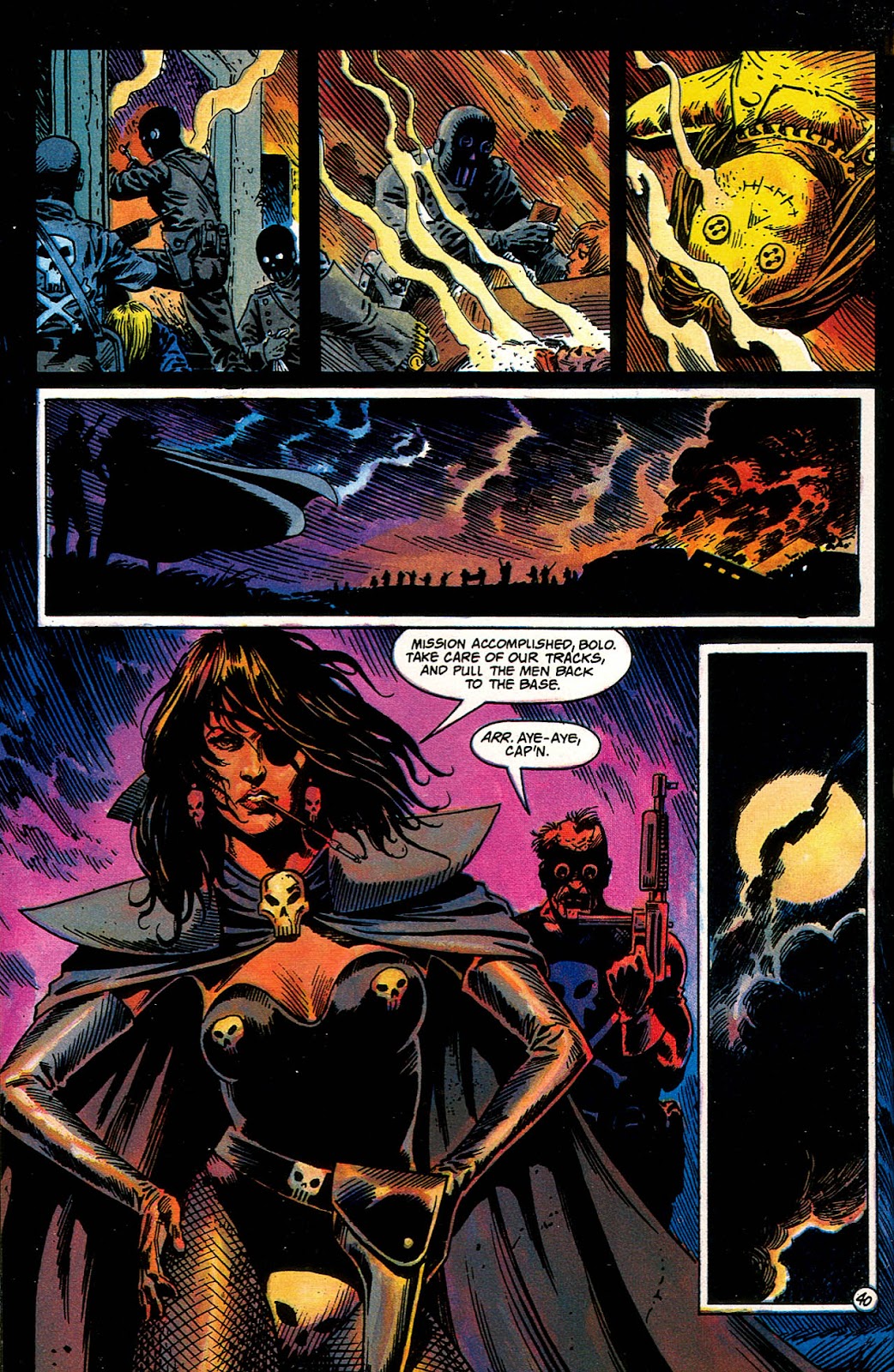 They use the electrical power from a nearby substation to derail the train and kill all on board. the spider arrives after they have gone and soon finds himself targeted by the police. In chapter 2, the spider uses the web gun, created by his scientist friend, to escape the police, with Ram Singh's help. he goes to Nita's place to heal his injuries and they talk of his need to be the Spider. Elsewhere, Captain Kidd and her gang bring their loot to a fortified "citadel, somewhere in new Jersey, and meet US Senator Skarno, who is in league with their "master." 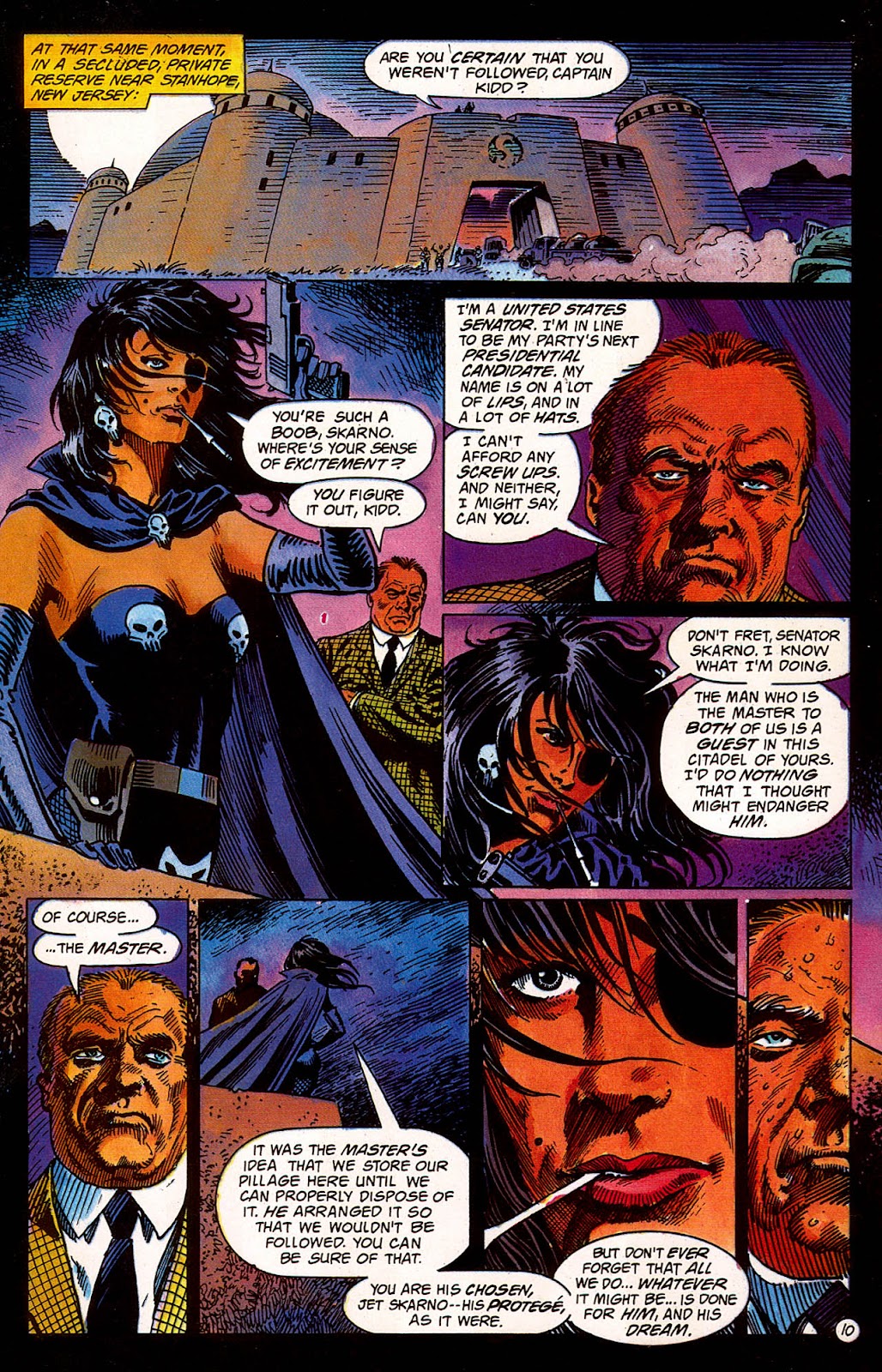 Richard Wentowrth checks in at Argosy and discusses the first issue of Urbane magazine, with a George S Kaufman retrospective. he quashes a planned piece on the Spider, saying he won't engage in cheap sensationalism in the magazine, but substitutes an expose on Senator Jet Skarno, a fascist who has attacked unions and minorities, leading to pogroms in his home state. Wentworth says he is being bankrolled by a failed foreign politician and he has come East to spread his message of hate. 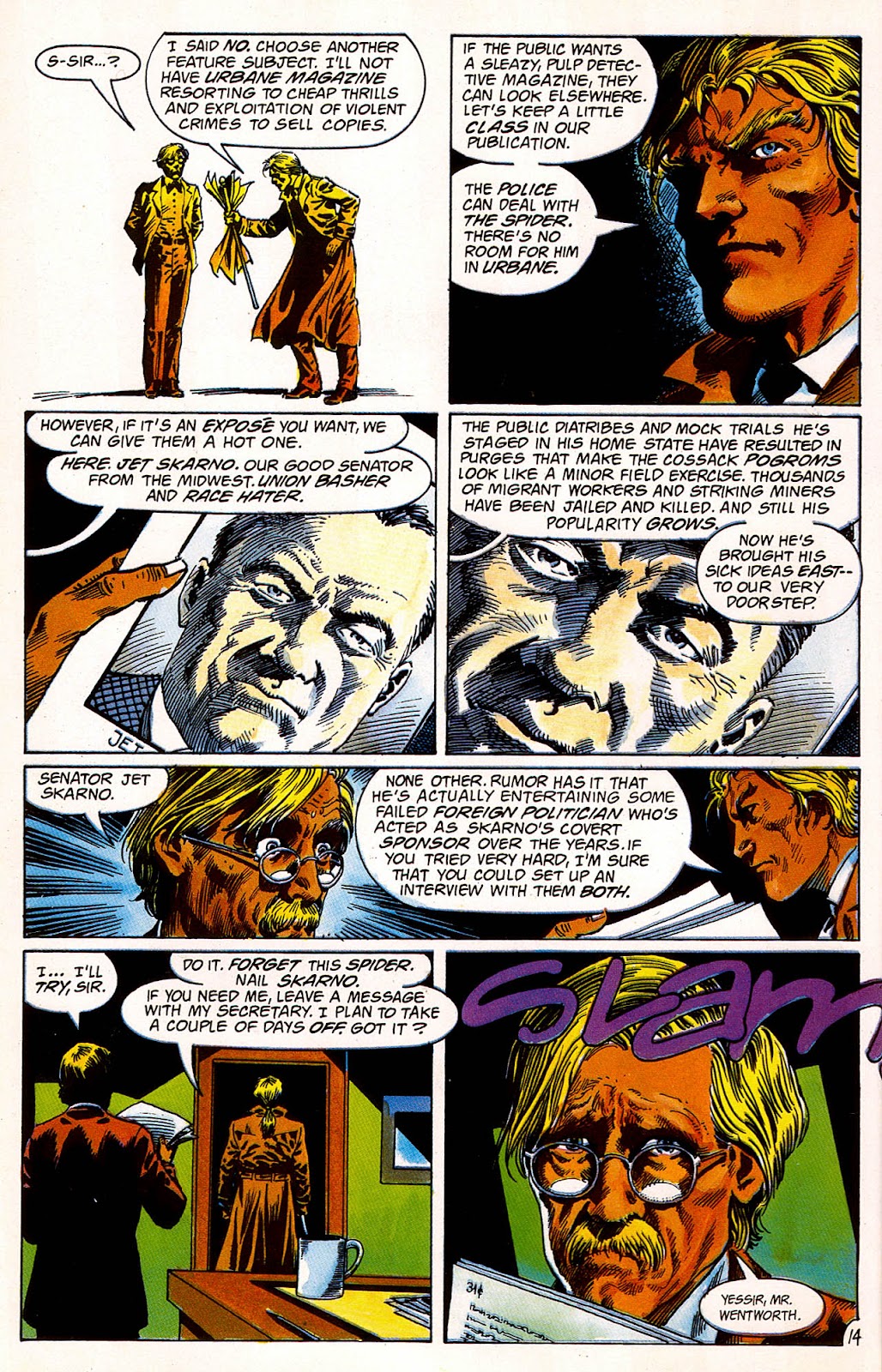 Wentworth is visited by the police commissioner, Kirkpatrick, who alludes to Wentworth's friend the spider, being closer to him then people think and talks of the allegations against the Spider. He suggests the Spider meets with him, with the aim of catching the real criminals. he never outright calls Wentworth the Spider, but it is obvious he knows. We learn of Richard Wentworth's past, as his wealthy parents are murdered by an enemy and he is raised by Dr Brownlee, the scientist he visited in issue #1. He ends up in the army, with the League of Nations, fighting in the Indus Valley, where he meets Ram Singh... 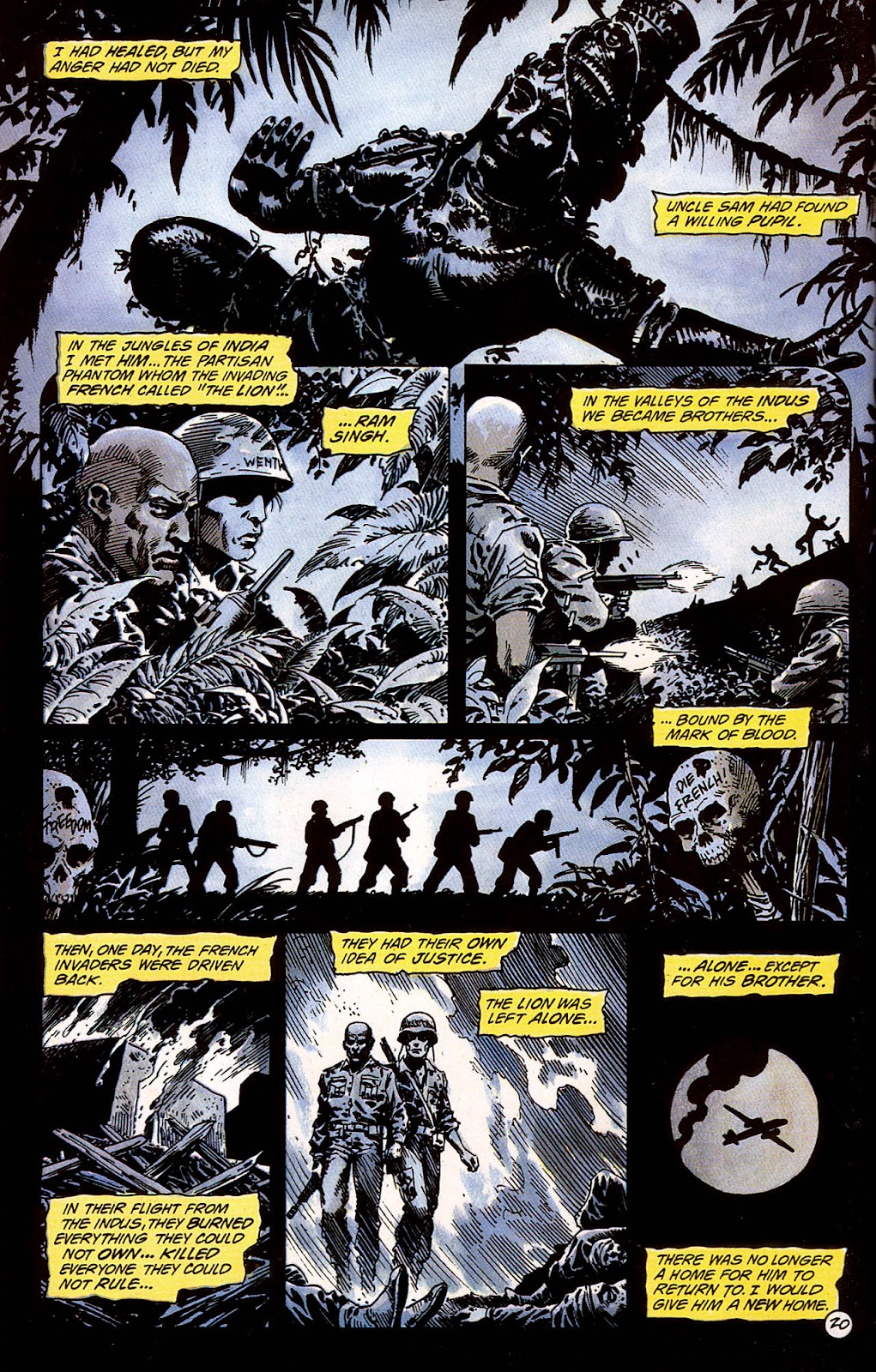 When he returned home, he found Brownlee targeted by criminals and wentworth saves him from death, but he is forced to live inside a suit, which we saw in issue 1. Wentworth takes up the mantle of the Spider, after noticing one building a web, in the lab, and takes down the criminals. The Spider meets with Kilpatrick and learns of another train attack, this time carrying mostly Hassidic Jews. He has evidence of money being funneled through an Illinois bank to Hamburg, converting the dollars to deutsche marks. The Spider follows his evidence and comes to the citadel, where Skarno meets with the master.... 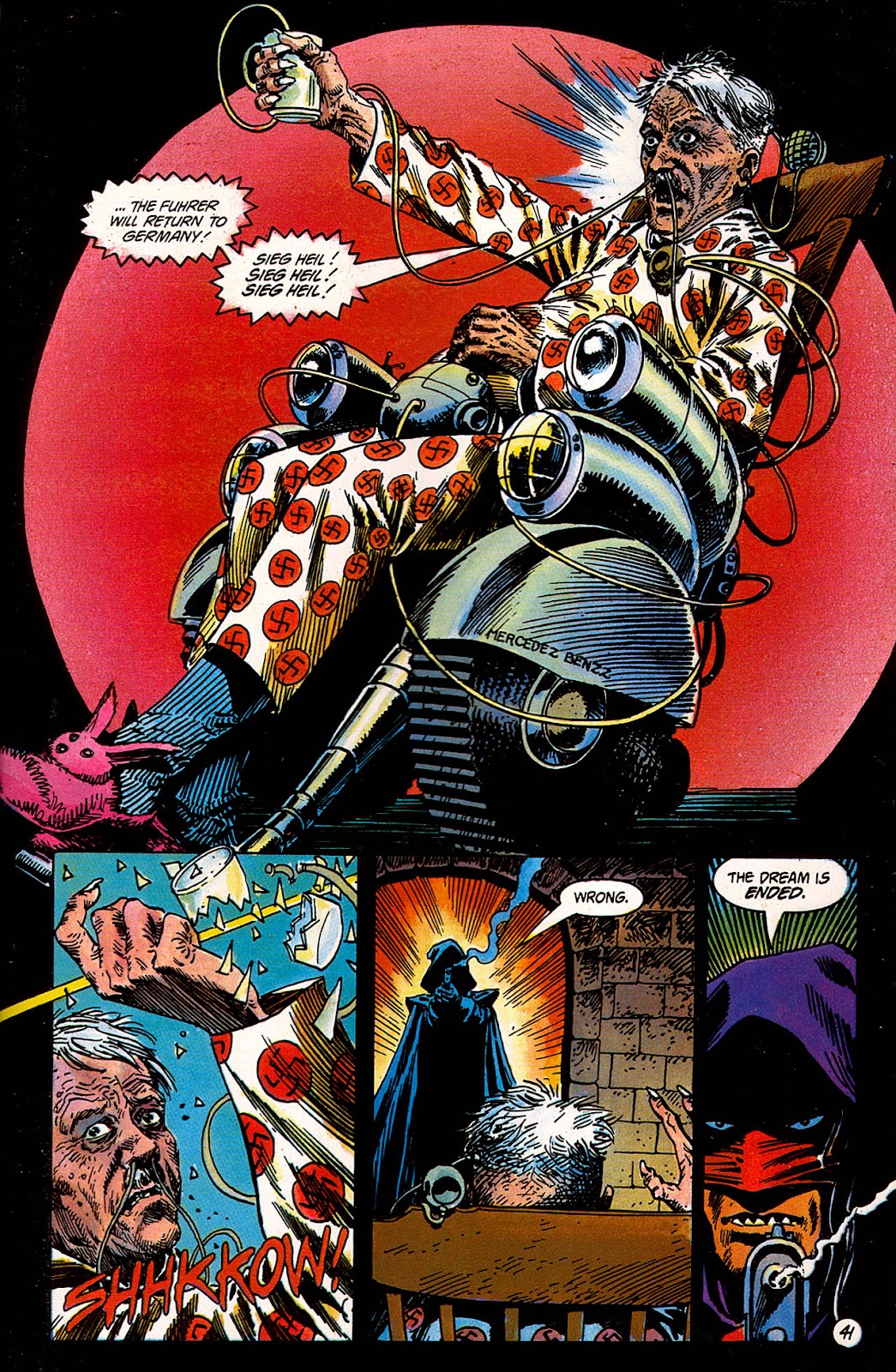 Adolf Hitler, who was forced to flee Germany in 1935, when rioting broke out and the people rose up against his government. The Spider draws a bead on him, but is interrupted by captain Kidd. In Chapter 3, The spider battles both Captain Kidd and Bolo, but is defeated... 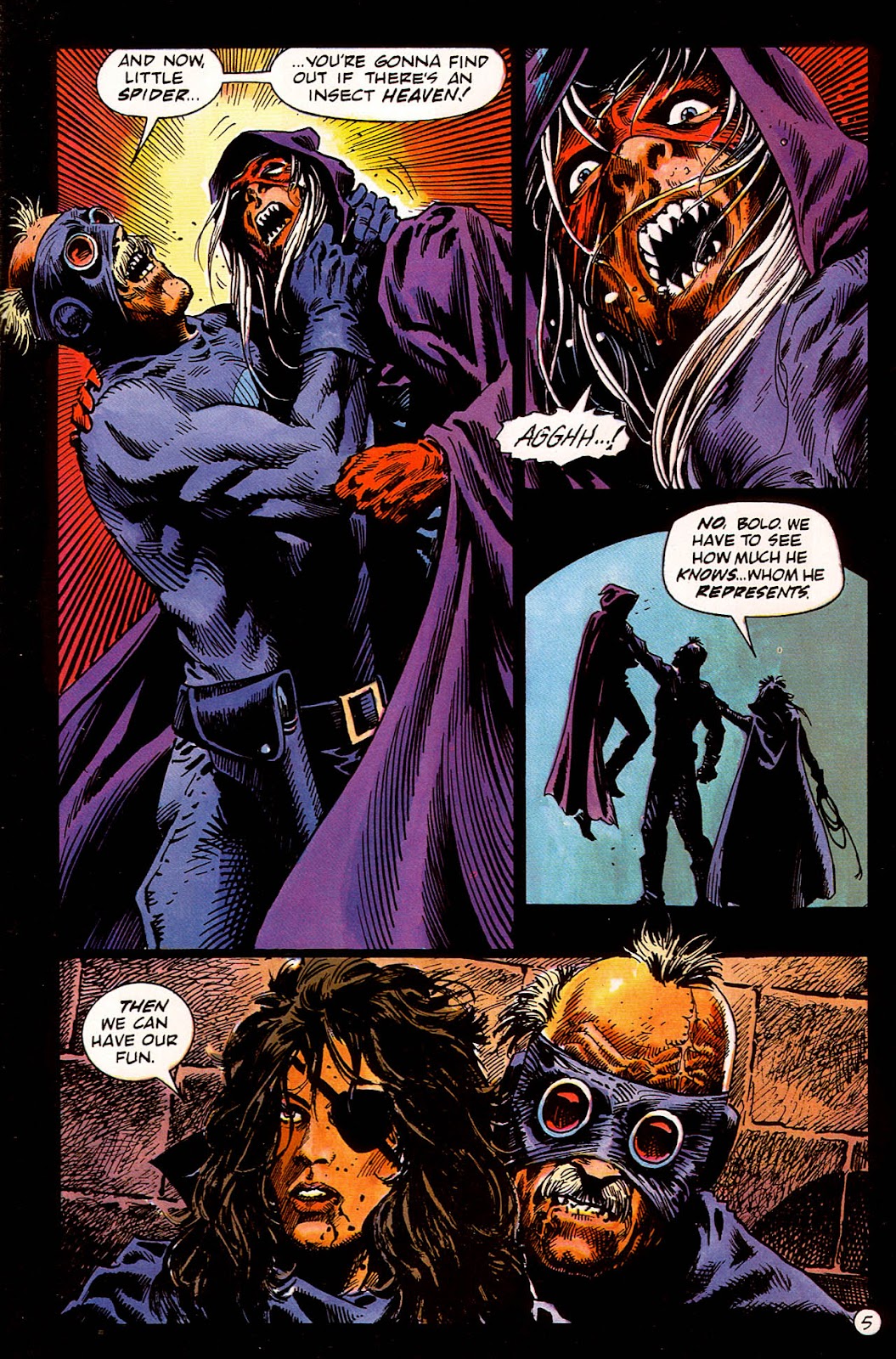 The Spider is unmasked and revealed to be Richard Wentworth and Skarno believes they can use the fact for their purposes and keep him alive, rather than filming his death. Ram Singh knows the Spider has been captured and arms himself to go after his master and runs into Nita, who knows, too, that something has gone wrong. She insists on joining him. In captivity, Wentworth meets Prof Curley, the inventor of the electrical machine that Captain Kidd uses for the train attacks. He agrees to aid Wentworth in escaping and stopping the villains, but wants Captain Kidd left for himself. Wentworth agrees, but they are spied upon by Kidd. Wentworth separates his shoulders to slip out of the metal vest in which he has been chained, then has Curley help reset them. He spots Kidd's spy hole and smiles. he climbs up and pulls loose the bricks and they are able to squeeze through the opening. The villains plot an attack on the international wing of the airport and the predominantly Jewish passengers who will be arriving to celebrate Passover, with friends and relatives... 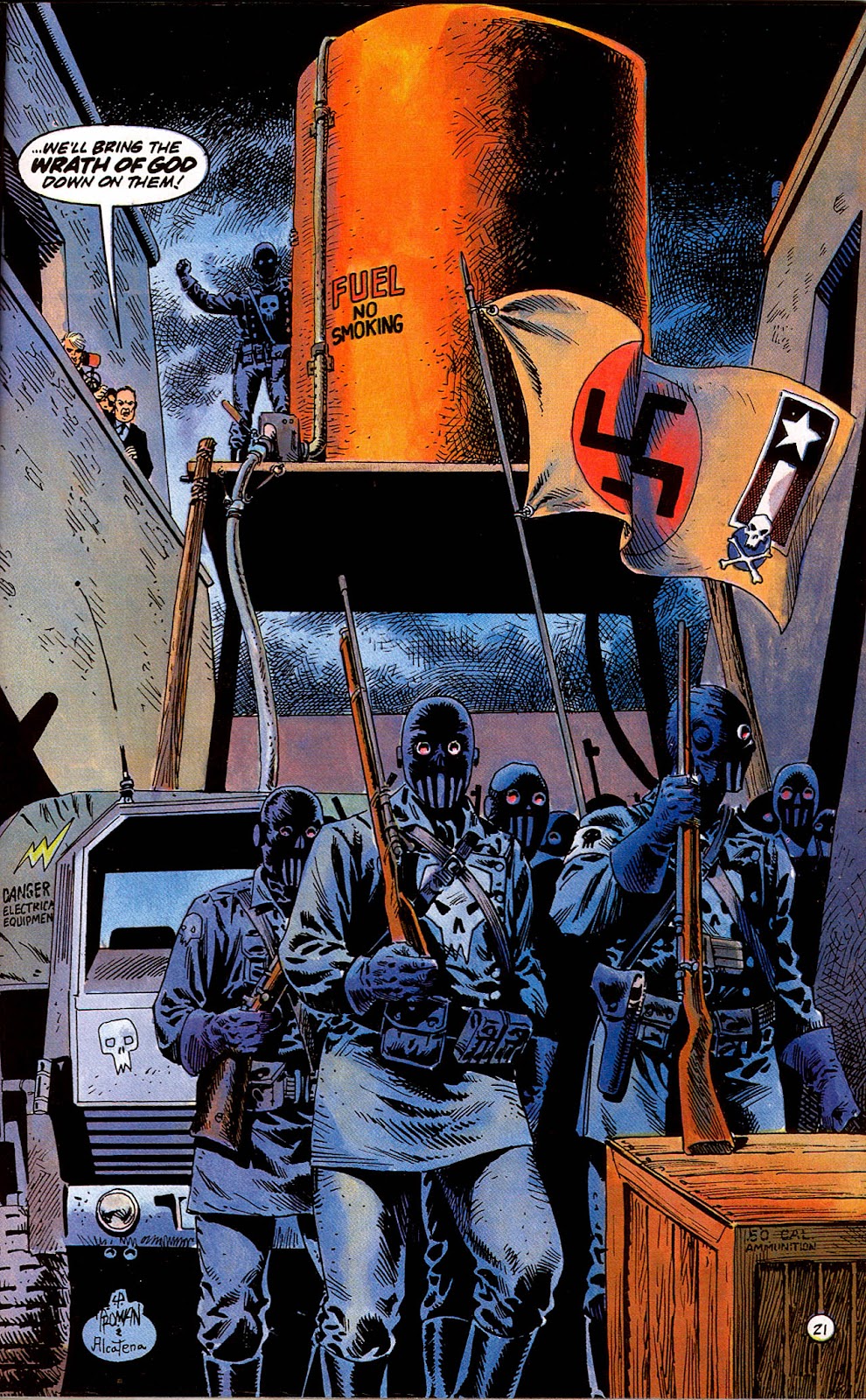 The Spider turns up and opens up with a submachine gun on the troops of the villain. He destroys the fuel tank that is filling their vehicles and mows down the soldiers. bolo climbs up to get him and gets riddled in the face and falls to his death. He and Curley try to make their escape, but get cornered in a crossfire, with Curley hit. it looks bad, until ram Singh turns up and gives them covering fire. They then corner Hitler and Skarno and Wentworth tells them whey are about to die, when Kidd turns up with Nita, as a hostage, and the film of Wentworth's unmasking... 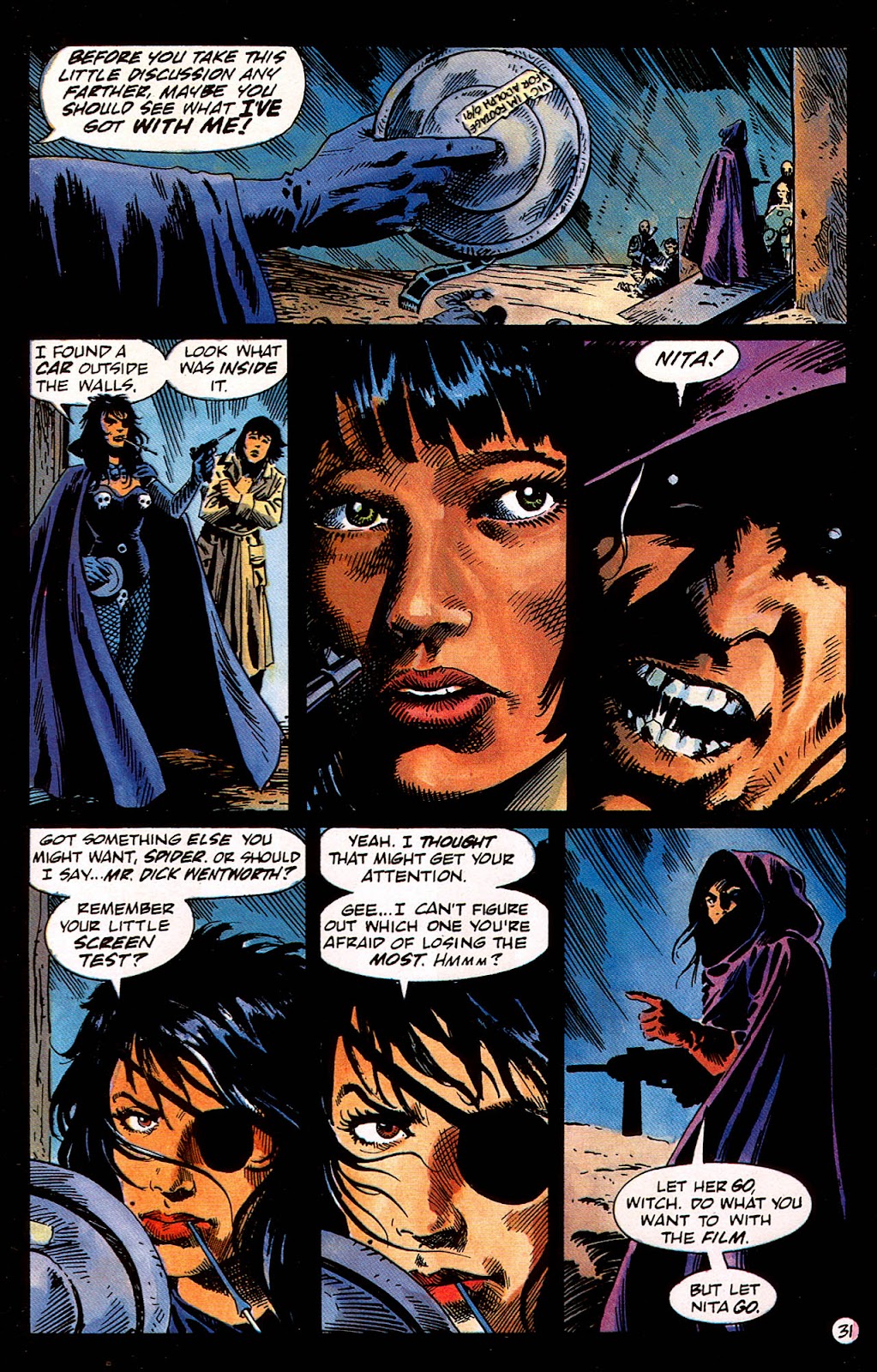 Kidd freaks out when Wentworth tells her to let Nita go, going on a rant about men talking to her that way and threatening to kill Nita. She is able to free Skarno and Hitler and renegs on freeing Nita. Curley shoots her and Wentworth guns down Skarno, then electrocutes Hitler with the machine. Curley dies, revealing that Kidd was his daughter. The Spider leaves, with Ram Singh and Nita. he later visits Kirkpatrick and delivers the head of the man who killed Kirkpatrick's wife and daughter, Bolo. It ends with the revelation that Skarno is badly wounded, but not dead, trying to revive Hitler and vowing to return. Thoughts: An excellent adaptation and modernization of the Spider. Truman stays true to the style of the pulp stories, with the righteous Wentworth and his active companions. Nita Van Sloan was his fiancee, but they did not marry. it was never overt, but there were hints that their relationship was physical. Nita was a capable figure and actively took part in missions, even replacing the Spider in a few stories. Ram Singh was a feared fighter and all three were part of the group of rebels who fight the Black Police fascists in the pulp epic. here, Truman just tweaks that and puts them into a pulp world, but advanced enough, technologically, that the more fanciful devices might seem more possible, though with heavy coils and cables, rather than sleek micro-processors and circuitry. The blood and violence is intact, as well as the Old Testament justice. Given the more modern setting, Truman is more overt with the physical side of Richard and Nita's relationship, though through dialogue, rather than depiction. When Nita treats his wounds, he says she makes a great nurse and would look cute in one of those white caps. Nita responds with "fat chance," but the uniform might be of use for a bit of fun. Slipping in Hitler is old hat for these kinds of things, but it helps sell the idea of an alternate history. that is further aided by Wentworth being a veteran of a modern war, in Asia, as he helps fight off a French invasion, while serving under League of Nations command, rather than United Nations. Nazi Germany falls in 1935, when Jews, gypsies and other Nazi targets rise up and attack the Nuremburg rally, forcing Hitler to flee. Truman mocks Hitler by showing him as a pathetic old man, kept alive by chemicals and other means, clad in swastika pajamas and bunny slippers. the image of him in the wheel chair reminds one of Peter Selelrs, as Dr Strangelove, in the Kubrick film. Truman relates his early love for the Spider and his attempts to do a Spider comic at First (ending up just doing an homage, in Grimjack #5) and Eclipse, before circumstances led to this series. It is done in prestige format, as Eclipse had moved into more of a graphic novel formatting for everything they were doing. So, the story plays out over 3 48-page books, with additional material at the end of each issue. #1 features background on the pulps and the two serials. #2 has a piece from Will Murray, a pulp historian and novelist, in his own right (writer of some destroyer novels, the marvel comic series based on it, as well as some Doc Savage novels, based on plots in Lester Dent's personal papers). the third gives us Truman's road to this series. The first mini did well enough for a second, which is a more direct adaptation of the pulp story, Death Reign of the Vampire King. That story was reprinted in the late 70s, as part of the Pocket Books reprint line, with changes and was also reprinted in the Carrol & Graf reprint series. The story has a madman and his gang releasing vampire bats on the city, to ravage it and make it easier to conquer. the villain is known as The Bat Man and the original story was published in 1935, 4 years before the caped crusader or the Black Bat. 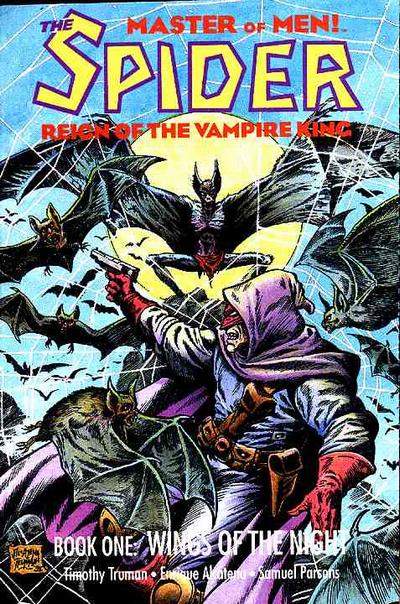 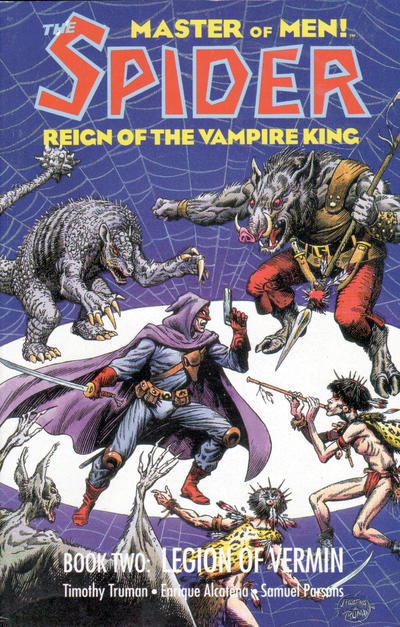 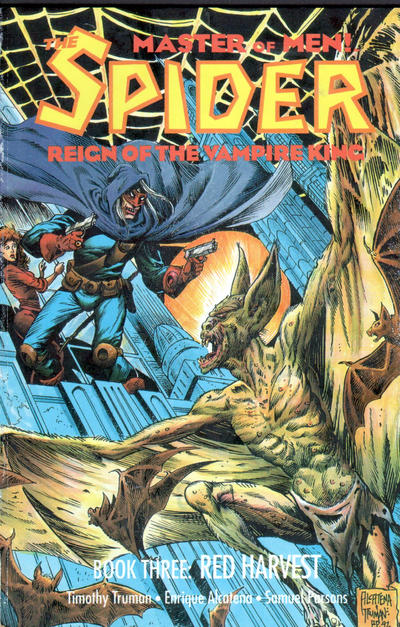 I don't have copies of this, anymore and no digital file. the basic plot follows as in the pulp, but Truman gives it a twist, with real monsters, including and actual Bat Man...  Alcatena handles the full art and Truman only the script. Wayne Truman replaces Tim Harkins on the lettering. The plot includes a gang war and more character interaction.  but much of the same brutality....  That was it for the Spider and pretty much Truman's association with Eclipse, except for two projects: Robin Hood and Dragon Chiang....    Truman provides pencil breakdowns for the mini-series, conveniently timed to come out when a certain Prince of Thieves was in theaters, written by editor Valerie Jones and painted art by Christopher Schenck. I caught the first issue when it came out, but not the other two, but later got a digital copy of it. It is fine, but nothing particularly special.  This features Truman on story and pencils, with Tim Bradstreet on inks. The story is another post-apocalyptic future, with a devastated US and a Chines long-haul trucker, with a high tech rig, bringing goods in from Asia, across a massive bridge across the Bering Strait. It has much in common with Scout, other than Bradstreet's ink overpower Truman's pencils, in some scenes. 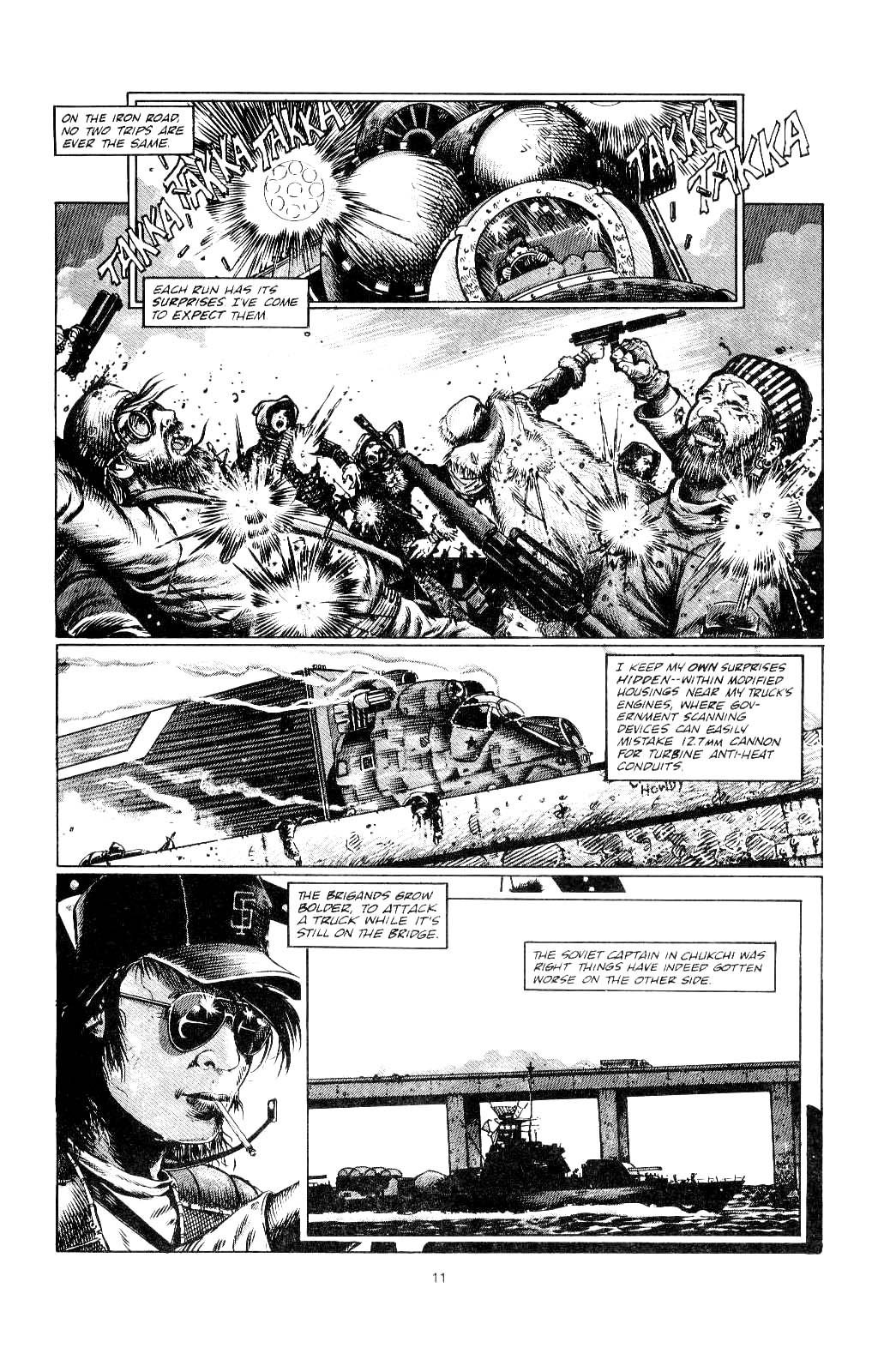 He crosses Canada and picks up a hitchhiker, who is part of a gang, who hijack his truck and steal his cargo. he tracks them down and finds out the cargo was involved in a bigger plot. It's all rather violent and nihilistic, even more than Scout. The book was one of several ideas concocted by Tim and chuck Dixon, on road trips and was born in Truman's love of biker movies, from and old theater, where his uncle ran the projector, with much of the work of the late William Smith, like The Losers and Roger Corman's biker exploitation films (Wild Angels). This became mixed with Mad Max and other influences, until we have what is essentially a biker movie about a Chinese truck driver, in a lawless land. It was serialized in Europe and published as a complete package, by Eclipse. I never got a copy, for various reasons, which is part of why I am not doing a full-on review. Like I say, much of the style is similar to Scout; but I kind of feel it lacks the depth of that series, which is likely due to its conception and inspiration. It's more of a single story that was part of a group of ideas, born out of things like exploitation films, music and other influences. In a perfect world, there would have been more of a market for this, as what Truman describes sounds much like what Tarantino did with his films, especially stuff like Grindhouse and its segments. If the US would support anthologies, like Dark Hose Presents and Negative Burn, we could have had more stuff like this (not necessarily the post-apocalyptic action comic, but different types of stories, in a wider range of genres or sub-genres). Truman moved on to other things, as Eclipse became less stable, working on things like Grateful Dead Comix, the Wild Cards book covers and Star Wars stories, for Dark Horse, Turok, for Valiant, and various things for DC (including my favorite, Guns of the Dragon). So, that is the world of what was 4Winds and Tim Truman's work with Eclipse. |
|






















































